
STUDENT WORKBOOK
MODULE 3: MONEY MODULE 4: DIRECTIONS
August 1979
Copyright ©1980 by John H. T. Harvey, Lucille A. Barale, Roberta S. Barry, and Thomas E. Madden
PREFACE
Standard Chinese: A Modular Approach originated in an interagency conference held at the Foreign Service Institute in August 1973 to address the need generally felt in the U.S. Government language training community for improving and updating Chinese materials to reflect current usage in Beijing and Taipei.
The conference resolved to develop materials which were flexible enough in form and content to meet the requirements of a wide range of government agencies and academic institutions.
A Project Board was established consisting of representatives of the Central Intelligence Agency Language Learning Center, the Defense Language-Institute, the State Department's Foreign Service Institute, the Cryptologic School of the National Security Agency, and the U.S. Office of Education, later joined by the Canadian Forces Foreign Language School. The representatives have included Arthur T. McNeill, John Hopkins, and John Boag (CIA); Colonel John F. Elder III, Joseph C. Hutchinson, Ivy Gibian, and Major Bernard Muller-Thym (DLI); James R. Frith and John B. Ratliff III (FSI); Kazuo Shitama (NSA); Richard T. Thompson and Julia Petrov (OE); and Lieutenant Colonel George Kozoriz (CFFLS).
The Project Board set up the Chinese Core Curriculum Project in 197^ in space provided, at the Foreign Service Institute. Each of the six U.S. and Canadian government agencies provided funds and other assistance.
Gerard P. Kok was appointed project coordinator, and a planning council was formed consisting of Mr. Kok, Frances Li of the Defense Language Institute, Patricia O'Connor of the University of Texas, Earl M. Hickerson of the Language Learning Center, and James Wrenn of Brown University. In the fall of 1977, Lucille A. Barale was appointed deputy project coordinator. David W. Dellinger of the Language Learning Center and Charles R. Sheehan of the Foreign Service Institute also served on the planning council and contributed material to the project. The planning council drew up the original overall design for the materials and met regularly to review their development.
Writers for the first half of the materials were John H. T. Harvey, Lucille A. Barale, and Roberta S. Barry, who worked in close cooperation with the planning council and with the Chinese staff of the Foreign Service Institute. Mr. Harvey developed the instructional formats of the comprehension and production self-study materials, and also designed the communication-based classroom activities and wrote the teacher's guides. Lucille A. Barale and Roberta S. Barry wrote the tape scripts and the student text. By 1978 Thomas E. Madden and Susan C. Pola had joined the staff. Led by Ms. Barale, they have worked as a team to produce the materials subsequent to Module 6.
All Chinese language material was prepared or selected by Chuan 0. Chao, Ying-chih Chen, Hsiao-jung Chi, Eva Diao, Jan Hu, Tsung-mi Li, and Yunhui C< Yang, assisted for part of the time by Chieh-fang Ou Lee, Ying-ming Chen, and Joseph Yu Hsu Wang. Anna Affholder, Mei-li Chen, and Henry Khuo helped in the preparation of a preliminary corpus of dialogues.
Administrative assistance was provided at various times by Vincent Basciano, Lisa A. Bowden, Jill W. Ellis, Donna Fong, Renee T. C. Liang, Thomas E. Madden, Susan C. Pola, and Kathleen Strype.
The production of tape recordings was directed by Jose M. Ramirez of the Foreign Service Institute Recording Studio. The Chinese script was voiced by Ms. Chao, Ms. Chen, Mr. Chen, Ms. Diao, Ms. Hu, Mr. Khuo, Mr. Li, and Ms. Yang. The English script was read by Ms. Barale, Ms. Barry, Mr. Basciano, Ms. Ellis, Ms. Pola, and Ms. Strype.
The graphics were produced by John McClelland of the Foreign Service Institute Audio-Visual staff, under the general supervision of Joseph A. Sadote, Chief of Audio-Visual.
Standard Chinese: A Modular Approach was field-tested with the cooperation of Brown University; the Defense Language Institute, Foreign Language Center; the Foreign Service Institute; the Language Learning Center; the United States Air Force Academy; the University of Illinois; and the University of Virginia.
Colonel Samuel L. Stapleton and Colonel Thomas G. Foster, Commandants of the Defense Language Institute, Foreign Language Center, authorized the DLIFLC support necessary for preparation of this edition of the course materials. This support included coordination, graphic arts, editing, typing, proofreading, printing, and materials necessary to carry out these tasks.
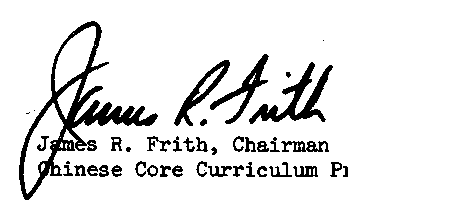
Jarnos R. Frith, Chairman
Chinese Core Curriculum Project Board
CONTENTS
MODULE 3: MONEY
UNIT 1 C-2 Workbook..................... ... . 1
Communication Game A .......... . ....... 7
Communication Game B.................
Communication Game......... .......• ... 3k
UNIT k C-2 Workbook...............
P-2 Workbook .......... . .......... . kl
P-2 Workbook ...................... 69
MODULE k: DIRECTIONS
P-2 Workbook
MODULE 3: MONEY
EXERCISE 1
This is a review dialogue similar to dialogues at the end of C-l tapes. You will test your understanding of vocabulary items and grammar introduced in this unit.
In this conversation, Mr. Jacobsen is making some purchases at a news-' stand in Taipei. You will hear the conversation twice. Then each sentence in the dialogue will be followed by a pause during which you are to say the English equivalent. After each pause, the speaker will give an acceptable English translation for comparison.
EXERCISE 2
In this exercise you will work on your comprehension of amounts of money and prices per unit. Zhāng San has 100 Taiwan dollars to spend in the bookstore. You will hear his conversation with the clerk three times. As you listen the first two times, jot down on the chart below prices of items he wants to buy, and answer the first question under the chart. As you listen to the dialogue for the third time, answer the second and third questions.
Here are two titles you will need for this exercise:
Zhōngguo Wtnxuí Shi (History of Chinese Literature)
Taiwan Wéntán (Taiwan Literary Magazine)
ITEM
PRICE
History of Chinese Literature ________
Taiwan Literary Magazine
History of England
map of England
QUESTIONS
1. Did Mr. Zhang have enough money for everything he wanted to buy?
( ) Yes ( ) No
2. Which item did Mr. Zhāng decide not to buy?
( ) History of Chinese Literature
( ) Taiwan Literary Magazine
( ) History of England
( ) map of England
3. How much money did Mr. Zhāng have left out of his 100 Taiwan dollars?
EXERCISE 3
In this exercise you will work on your comprehension of counters to indicate amounts. You will hear three conversations. The first and third take place at newsstands, and the second in a bookstore.
After listening to the series of conversations for the second time, answer the question below. Then listen to the conversations again.'
QUESTION
1. Which two people bought the same number of items?
) No. 1 and No.
) No. 2 and No.
) No. 1 and No.
EXERCISE 4
This exercise will give you more practice listening for prices. Lewis Ross, an American student in Taipei, is browsing through a bookstore. You will hear his conversation with the clerk three times. After listening to the dialogue for the second time, answer the questions below. Then listen to the conversation again.
QUESTIONS
1. Did the clerk get the total right? ( ) Yes ( ) No
2. What is the correct total?
EXERCISE 1
This exercise gives you practice in finding out whether an item is sold, finding out the price per unit, and completing the purchase.
Display I lists the items you want to bry at a newsstand on eight different occasions. For each item, first ask if it is sold there. If the news, vendor says that it is, ask the price per copy. When he tells you the price, say that you will buy one copy, and tell him how much you are giving him—the exact change.
Example
YOU ASK: Hlmen zhèli mài ZhSngwín bio bu mail CRepeat confirmation.3 TAPE: WSmen mil. Jiù zài nili.
YOU ASK: Zhège Zhǒngwín bio duSshao %i£n yífèn? CRepeat confirmation.!
TAPE: Sǎnkuii qiín yífin.
YOU SAY: HMo. Wg snSi yífin. Zhi ahi s&nkuii oiín. CRepeat confirmation. 3
The underlined sentence in the last line of the example is "Here’s three dollars" (literally, "This is three dollars").
Here are the new vocabulary items you will need for this exercise:
Hin-Yíng zìdiln (Chinese-English dictionary)
Ylng-Hln zìdiln (English-Chinese dictionary)
DISPLAY I You want to bty
1. a Chinese (-language) newspaper
2. a Chinese magazine
3. a map of Taipei
4. a Chinese-English dictionary.
5. an American magazine
6, an English(-language) newspaper
7. a map of Taiwan
8. an English-Chinese dictionary
EXERCISE 2
This exercise gives you practice in talking about buying and selling various amounts of things. You will answer questions about how many books students bought and sold; at the beginning of last semester.
Display II shows the names of various students and the number of books each student bought and sold at the university bookstore. Use this information to answer the questions. (Notice that all the students have finished buying and selling their books.)
Example
Q: Lfn YSngpíng màile jlbSn shū?
A: Tā màile lilngbSn shū. CRepeat confirmation. 3
Q: Zhào Défēn maile jíbān shū?
A: Tā māile qībān shū. CRepeat confirmation.3
DISPLAY II
|
STUDENT |
BOOKS BOUGHT |
BOOKS SOLD |
|
1. Lfn YSngpíng |
6 |
2 |
|
2. Zhào Défān |
7 |
3 |
|
3. Ying Huìrin |
6 |
h |
|
U. Chin GuSquín |
5 |
3 |
|
5. Sdng Zìqiāng |
U |
2 |
|
6. JiSng Bíngyíng |
5 |
1 |
|
7. MS ZhīyuSn |
7 |
0 |
|
8. Zhou Dexián |
U |
5 |
|
9. SīmS Ching |
6 |
3 |
|
10. Fang WSnrū |
5 |
2 |
EXERCISE 3
This exercise involves buying and selling books, but this tine you must pay attention to whether or not the students have completed their purchases and sales. Display III shows the purchases and sales students have made as of the day before classes. Use this information to answer the questions on tape. (Not all students have finished buying and selling all their books.)
When giving your answer, you will need to choose between a single le and double le construction. As you remember from the BIO Module, the double le construction is used to talk about actions started in the past and still going on, as in W8 l&ile li&ngge xlngcl le, ”1 have been here two weeks.” In this exercise you will be talking not about duration of time but rather about amounts of goods, as in Wǔ mSile lilngbMn shǔ le. "I have bought two books (so far).”
Example
Q: Lin Yǔngpfng inSile JlbSn xln shǔ le?
A: Ta yljīng mlile wǔbín xīa shǔ le. [Repeat confirmation.3
Q: TS màile jlbǔn jiǔ shǔ?
A: TI mǔile liMngbSn jiǔ shǔ. [Repeat confirmation.J
Q: Zhǔo DffSn mìile jXbln Jiǔ shǔ le?
A: Tā yXjīng mlile yìbǔn jiǔ shǔ le. [Repeat confirmation.3
Here are the additional vocabulary items you will need for this exercise:
xln (new)
‘ jiǔ (old)
DISPLAY III
|
STUDENT |
BOOKS BOUGHT (xīn shū) |
BOOK SOLD (jiù shū) |
|
1. Lin YJSngpíng |
5 out of 6 |
2 out of 2 |
|
2. Zhào Défēn |
U out of 7 |
1 out of 3 |
|
3. Ying Huìrfin |
6 out of 6 |
3 out of U |
|
U. Chin GuSquán |
3 out of 5 |
3 out of 3 |
|
5. S8ng ZÌqiáng |
U out of 4 |
1 out of 2 |
|
6. JiSng Bīngyíng |
3 out of 5 |
1 out of 1 |
|
7. MS ZhīyuSn |
7 out of 7 |
2 out of 3 |
|
8. Zhōu Dixiin |
3 out of U |
5 out of 5 |
|
9. SīmX Ching |
5 out of 6 |
3 out of 3 |
|
10. Fang WSnrú |
5 out of 5 |
1 out of 1 |
INSTRUCTIONS:
Type: Book Exchange
Situation: You are one of four second-year students at a college in Taiwan. It is the start of the school year, and each student wants to sell the books he has left over from last year and wants to buy the books he needs for this year.
All students at this college take the same eight courses during the first two years, four each year, but may take the courses in either year. There is one textbook for each course. You therefore have four textbooks you want to sell, and you want to buy the four textbooks you do not have.
There are two set prices for each secondhand textbook, one price for copies in good condition and one for copies in bad condition. Some students can afford and insist on the good copies, and some can only afford and must settle for the bad copies.
Goal: To sell the four textbooks you have at the set prices and to buy the four textbooks you need at prices you can afford.
Number of Players: Four in a group.
Setting up: First, your teacher will list the eight courses on the chalkboard.
Then, each player is dealt four cards, which represent the four text-* books he has. Each card gives the name of the course and the sale price for the textbook. (See Cards—Textbook, on the following pages.)
Also, each player is dealt a card which reads either WBIGH” (can afford high prices) or "LOW” (has to shop for low prices), indicating what prices he can afford.
Each player then compares the four textbooks he.has with the eight listed on the chalkboard to determine what four he needs to buy. He writes a shopping list of the books he needs to buy.
Procedure: Mingle with the other players, shopping around to find who has the textbooks you need and what the high and low prices are. (You may find it more efficient to shop for one textbook at a time.) Then make your purchases.
Example: You are Speaker 1 (Si). You need to buy a cheap copy of the textbook for the economics course (nèibàn JíngJixuà, "that volume ConJ economics").
SI: NX y5u nàbàn JīngJixué meiyou?
S2: Y8u.
SI: NX mài bu mài? CS2 may have Just bought it for himself.3
S2: Mài.
SI: Duōshao qiàn?
S2: Bāshikuài qiān.
SI: Xièxie. W3 xiàngyixiàng. ("I'll think it over.")
SI: NX yōu nàbàn JingJixué meiyou?
S3: Méiyou.
SI: Zài jiàn.
SI: NX yōu nàbàn JīngJixuí meiyou?
SU: Yōu.
SI: NX mài bu mài?
SU: Mài.
SI: Duōshao qiàn?
SU: Jiǔshikuài qián.
SI: W5 bù mài. Zài Jiàn.
SI: Wō mài nàbàn JingJixué. Zhè shi bāshikuài qián.
S2: Hào.
Speaker 2 hands over the card. You take the card, keeping it separate from your "for sale" cards.
Aàlííional Note: If the teacher asks for the total amount you have spent or made at a given point, you will need the word for "hundred," bài (NUM 5).
T: NX màile jXbàn shū le?
S: Wǒ màile liàngbàn le.
T: Nàliàngbàn shū yígdng duōshao qián?
S: Yígōng yìbàivūshikuài qián. ($150)
As may be obvious, nàliàngbàn shū means "those two books."
Practice Points: Prices, buying and selling.
CARDS—TEXTBOOK
|
HIGH |
LOW |
HIGH |
LOW |
|
American History $90 |
American History $75 |
Chinese History $85 |
Chinese History $60 |
|
English Literature $75 |
Chinese Literature $65 |
English Literature $55 |
Chinese Literature . $U5 |
|
Economics 070 |
Political Science 065 |
Political Science 080 |
Economics 095 |
|
Chemistry 085 |
Chemistzy 075 |
Mathematics 050 |
Mathematics 070 |
INSTRUCTIONS:
Type: Shopping Lists
Situation: The setting is Taipei. You are one of several people who have made out shopping lists. You are interested in finding out who has the most ambitious spending plans.
Goal: To find the player who will be paying the highest total for his purchases.
Number of Players: Four or more in a group.
Materials: A deck of cards. Written on each card are the name of an item, specific quantity, and the unit price for the item. (See Cards—Shopping, on the following pages.)
Procedure: Each player is dealt a hand of three cards. Together, these make up his shopping list.
Mingle with the other players to exchange information. Ask each player for the items, quantities, and prices of his planned purchases, and work out the totals on your work sheet. (Do not ask players for the total cost of all their purchases.)
Example: You are Speaker 1, starting your conversation with Speaker 2.
SI: Nl xiǎng mai shénme?
S2: Wo xiSng mài yífèn Yingwén bào, liàngbén Méiguo zázhì, yìzhāng Taiwan dìtú.
SI: Yingwén bào duóshao qián yífèn?
S2: Wǔkuài qián.
When you have completed your survey, report to the teacher. If you found, for example, that S2’s purchases will be more expensive than anyone else*s, you will say
SI: Shi S2 Xiānsheng. (“It’s S2 who is planning to spend the most.")
T: Yígòng duōshao qián?
SI: Yígòng yìbǎi èrshiwǔkuài qián.
Practice Points: Items, amounts (with counters), prices.
INFORMATION WORK SHEET:
|
Players’ Names 7 | ||||
|
Items to Buy | ||||
|
totals-----> |
CARDS—SHOPPING
|
1 English-language newspaper |
2 English-language newspapers |
1 English-language newspaper |
1 English-language newspaper |
|
at 05 |
at 05 each |
at 010 |
at 010 |
|
1 Chinese-language newspaper |
3 Chinese-language newspapers |
2 Chinese-language newspapers |
1 Chinese-language newspaper |
|
at 03 |
at 03 each |
at 05 each |
at 05 |
|
2 American magazines at 020 each |
1 American magazine at 020 |
3 American magazines ■ at 030 each |
2 American magazines at 030 each |
|
3 Chinese magazines |
2 Chinese magazines |
1 Chinese magazine |
2 Chinese magazines | |
|
at 010 each |
at 010 each |
at 020 |
at 020 each |
|
1 map of Taipei |
3 maps of Taipei |
2 maps of Taipei |
4 maps of Taipei | |
|
at 025 |
at 025 each |
at 050 each |
at 050 each |
|
1 Chinese-English dictionary at 035 |
2 Chinese-English dictionaries at 035 each |
1 Chinese-English dictionary at 095 |
3 Chinese-English dictionaries at 095 each |
|
3 maps of Taiwan |
U naps of Taiwan |
1 map of Taiwan |
2 maps of Taiwan | |
|
at *U0 each |
at *1*0 each |
at *65 |
at *65 each |
|
1 English-Chinese dictionary |
3 English-Chinese dictionaries |
2 English-Chinese dictionaries |
1 English-Chinese dictionary |
|
at *1*5 |
at *1*5 each |
at 075 each |
at *75 |
EXERCISE 1
This review dialogue will test your understanding of vocabulary items and grammar introduced in this unit.
In this conversation, Mr. Whitten is making some purchases at a small shop near his hotel in BSijlng. You will hear the conversation twice. Then each sentence in the dialogue will be followed by a pause during which you are to translate. After each pause, the speaker will give an acceptable English equivalent for comparison.
EXERCISE 2
This exercise will give you practice in recognizing exact prices which include dimes and pennies, abbreviated prices, and prices with zero in the tens place. You will hear five conversations involving purchases. The series of dialogues will be repeated two times. As you listen, record on the chart below information about each purchase.
|
1. |
ITEM |
PRICE PER UNIT |
TOTAL PRICE |
GAVE TO CLERK |
RECEIVED IN CHANGE |
|
2. | |||||
|
3. | |||||
|
u. | |||||
|
5. |
EXERCISE 1
In this exercise you will answer questions about quantities of items that have been bought and sold at "marketing and supply cooperatives" (government-owned stores): which store sold what and which person bought what.
Comrade Sun and Comrade JiSng have made purchases in three cooperatives. (Display I shows these transactions.) Supply and Marketing Cooperative Number 1 sells pastries and apples. Supply and Marketing Cooperative Number 2 sells soda and beer. Supply and Marketing Cooperative Number 3 sells oranges and soap, among other things.
Example
|
TAPE: |
Dìyī Gōngxiāo Hézuōshè mii xiSo diSnxIn bu mai? |
|
YOU: TAPE: YOU: TAPE: YOU: |
TSmen mài xiSo diSnxīn. Tāmen mài qìshuX bu mai? TSmen bú mài. Z&i nSr mài? Zìi Dììr GSngxiio Hézudshè mài. |
Here are the new vocabulary items you will need for this exercise:
|
píjiS (yìpíng píjifi) |
(beer Ca bottle of beer!) |
|
júzi (yìjīn Júsi) |
(oranges Ca catty of oranges!) |
|
ftixio (yfkuài fíizio) |
(soap Cone bar of soap!) |
|
gongxiao hézuBshè |
(supply and marketing•cooperative) |
DISPLAY I
|
COOPERATIVES (Gōngxiāo HezuSshè) |
CUSTOMERS Comrade Sun Comrade Jiang | |
|
Supply and Marketing Cooperative No. 1 (Dìyī Gōngxiāo Hezuèshè) |
2 catties of small pastries |
1 catty of apples |
|
Supply and Marketing Cooperative No. 2 (DÌèr Gongxiāo Eezuoshè) |
6 bottles of soda |
U bottles of beer |
|
Supply and Marketing Cooperative No. 3 (DÌsān Gōngxiāo Hézuoshè) |
3 catties of oranges |
1 bar of soap |
EXERCISE 2
In this exercise you will ask for various quantities of items and deal with prices in PRC currency: kuài. máo, and fēn. Display II is a list of twelve purchases you are to make, on twelve separate occasions.
For each purchase, ask the shopkeeper for the quantity you want. She will respond with the unit price. In your pocket you have two $10 bills, two $1 bills, and two dimes of People's currency. Give the shopkeeper an amount of money which is closest to the purchase price. Tell her how much money you are giving her. She will tell you what your change, if any, will be.
Example
YOU: Qíng nl gēi wo yífèn Renmín RÌbào. CRepeat confirmation.!
TAPE: HSo. Rénmín RÌbào wǔfēn qián yífèn.
YOU: GSi nl yìmáo qián. CRepeat confirmation.!
TAPE: Zhao ni wǔfēn qián.
DISPLAY II
(Remember that for each purchase you have two $10 bills, two $1 bills, and two dimes.)
1. 1 copy of The People’s Daily (Rénmía Rìbào)
2. 1 copy of The People’s Pictorial (Rfanín Huìbìo)
3. 1 copy of a nap of BSiJīng
U. 1 copy of The New China Dictionary (Xtnhut ZÌdiSn)
5. 2 copies of a nap of China
6. 3 copies of the Guāngnlng Daily (GuSngníng Rlbìo)
7. 1 catty of small pastries
8. 12 bottles of soda
9. U catties of apples
10. 10 bottles of QIngdXo beer
11. 5 catties of oranges
12. 2 bars of soap
EXERCISE 3
In this exercise you will purchase two items at a time. Display III shows your shopping lists on six different occasions.
With each list, ask the shopkeeper for a certain quantity of the first item. She will note your request with HSo. Then say you also want so much of the second item. She will ask you if you want anything else. Reply that you do not. She will tell you the total cost of your purchases. Tell her how much money you are giving her, on the assumption that you have two $10 bills, two $1 bills, and two dimes and want to give her only enough to cover the purchases. She will tell you how much change she is giving you, if any.
Example
YOU: Qing ni gěi wo liěngzhāng Zhōngguo dìtú. CRepeat confirmation.3
TAPE: Hao.
YOU: WS hái yào yìběn Xinhua Zìdiln. CRepeat confirmation.!
TAPE: Hao. Ní hái yào shénme?
YOU: W3 bú yào shenme le. CRepeat confirmation.!
TAPE: Liǎngzhāng Zhōngguo dìtǔ wǔkuài qián, yìběn Xinhua Zìdiln yíkuài liěngmáo wǔ. YÍgdng liàkuài liěngmáo wǔ.
YOU: Gěi ni shíkuài qián. CRepeat confirmation.!
TAPE: ZhSo ni sānkuài qímáo wǔ.
DISPLAY III
(Remember you have two $10 bills, two $1 bills, and two dimes each time.)
1. 2 copies of a map of China AND
1 copy of The New China Dictionary (Xinhua Zìdiǎn)
2. 1 copy of The People's Daily (Renmín Rìbào) AND
2 copies of the GuSngmíng Daily (Guángmíng Rìbào)
3. 1 copy of a map of Beijing AND
1 copy of The People's Pictorial (Renmín Huàbào)
U. 1 catty of small pastries AND
12 bottles of soda
5. U catties of apples AND
10 bottles of QīngdSo beer
6. 5 catties of oranges AND
2 bars of soap
INSTRUCTIONS!
Type: Shopping Lists (This is the same as Cornmunication Game B in Unit 1, except that it is set in Beijing and involves the new material in this unit.)
|
5 bottles of soda at ¥.15 |
3 bottles of soda at ¥.15 |
1* bottles of beer at ¥.1*8 |
8 bottles of beer at ¥.1*8 |
|
3 catties of small pastries at ¥.75 |
5 catties of small pastries at ¥.75 |
1* catties of large apples at ¥.1*5 |
1 catty of large apples at ¥.1*5 |
|
5 bars of soap at ¥.35 |
1* bars of soap at ¥.35 |
1* catties of small apples at ¥.1*0 |
2 catties of small apples at ¥.1*0 |
|
3 catties of oranges |
2 catties of oranges |
6 maps of BSijlng |
3 maps of Bíijfng | |
|
at ¥.38 |
at ¥.38 |
at ¥.50 |
at ¥.30 |
|
2 magazines |
5 magazines |
1 history book |
3 history books |
|
at ¥.22 |
at ¥.22 |
at ¥1.05 |
at ¥1.05 |
|
U magazines at ¥1.00 |
7 magazines at ¥1.00 |
1 map of China at ¥1.55 |
6 maps of China at ¥1.55 |
INSTRUCTIONS:
Type: Shopping
Situation: The setting is Beijing. You are either one of several shoppers or one of several storekeepers. The shoppers have lists of items to be purchased and the amount of each item. The storekeepers have stock lists of the items for sale and the unit price of each item. The shoppers are looking for the best buys.
(In most cases, you will find that a specific item is sold for the same price throughout the PRC. The Beijing setting is used here to give you work on prices with méo and fēn. The unrealistic price competition is used in this game to make you investigate prices carefully.)
Goal: For shoppers, to make their purchases as cheaply as possible. For storekeepers, to sell what they can at set prices.
Number of Players: Groups of four students or more.
Materials: One deck of cards for shoppers and one deck for storekeepers. (See Cards*—Shopping, which follow.)
Each shopper is dealt a hand of cards representing his shopping list. Each card gives an item and a quantity. For example, ”6 bottles of beer.” Each storekeeper is dealt a hand of cards representing his stock list. Each card gives an item and a unit price. Different storekeepers have cards giving different prices for the same item. For example, "beer at ¥.1*5 a bottle” and "beer at ¥.1*8 a bottle.” Play money may also be provided.
Procedure: Players mingle to make their purchases and sales.
(Shoppers talk only with storekeepers, and storekeepers talk only with shoppers.)
As a shopper, when you find the storekeeper who has the lowest price and make your purchase, write down the price. As a storekeeper, when you make a sale, write down the quantity sold. You will need these notes when your teacher talks with you after sales are completed.
Example: You are Speaker 1, a shopper. The last item on your shopping list is ”6 bottles of beer." Speaker 2 and Speaker 3 are storekeepers.
SI: Nímen zhèr mài pi Jiù bu mai?
S2: Mài. Jiù zài zhèli.
SI: Duōshao qián yìpíng?
S2: Sānmáo qián yìpíng.
SI: Xièxie.
SI: Nímen zhèr mài pi Jiù bu mai?
S3: Mài. Jiù zài zhèli.
SI: Duōshao qián yìpíng?
S3: Liángmáo qián yìpíng.
SI: Háo. Qíng ni gSi wo liùpíng.
S3: Ní hái yào shénme?
SI: W8 bú yào shénme le.
S3: Yígōng yíkuài liángnáo qián.
SI: Zhèi shi liángkuài qián.
S3: Zhao ni bāmáo qián.
(If play money is not being used, pick any reasonable round figure for the total amount given to the storekeeper.)
After the shopping has been completed, your teacher will question you:
T: Ní mài shénme le? CCompletion le follows the object shénme.
See Unit U.l
SI: Wǒ màile liùpíng píjiù, liSngJin dà píngguō. CCompletion le precedes these "amount" objects, just as it precedes amounts of time in duration sentences.!
T: Yígōng duōshao qián?
SI: Yígōng liSngkuài yìmáo qián.
T: Píjiǔ duōshao. qián yìpíng?
SI: LiSngmáo qián yìpíng.
(etc.)
Practice Points: Items, amounts, prices.
CARDS—SHOPPING (SHOPPER)
|
5 bottles of soda |
12 bottles of beer |
U catties of small pastries |
3 catties of large apples |
|
7 bars of soap |
2 catties of small apples |
U catties of oranges |
1 Chinese History book |
|
1 map of Beijing |
3 maps of China |
CARDS—SHOPPING (STOREKEEPER)
|
soda |
beer |
soda |
beer |
|
at ¥.13 |
at ¥.1»5 |
at ¥.18 |
at ¥.U8 |
|
per bottle |
per bottle |
per bottle |
per bottle |
|
small pastries |
large apples |
small pastries |
large apples |
|
at ¥.67 |
at ¥.55 |
at ¥.70 |
at ¥.U5 |
|
per catty |
per catty |
per catty |
per catty |
|
soap |
small apples |
soap |
small apples |
|
at ¥.35 |
at ¥.U7 |
at ¥.36 |
at ¥.1»3 |
|
per bar |
per catty |
per bar |
per catty |
|
oranges at ¥.35 per catty |
maps of Beijing at ¥.U6 each |
oranges at ¥.38 per catty |
maps of Beijing at-¥.5O each |
|
Chinese History books at ¥2.00 each |
maps of China at ¥1.85 each |
Chinese History books at ¥1.05 each |
maps of China at ¥1.65 each |
EXERCISE 1
This exercise is based on the review dialogue at the end of the C-l tape. You will work on your comprehension of words and patterns introduced in this unit.
In this conversation Mr. Saunders is talking to a clerk at the Friendship Department Store in BSijXng. You will hear the conversation twice. Then each sentence will be followed by a pause during which you are to translate it. After each pause, the speaker will give an acceptable English equivalent.
EXERCISE 2
This exercise will give you practice listening for comparisons in a conversation. Professor Liú is looking for a student to help him with a research project that will involve the use of French and some Chinese. The professor is talking to Mrs. Mao, who teaches Chinese to Americans. He is considering two of her students for the research job. The two students are Pan TÍngfēng (Timothy Pappas) and B&i Lìr6ng (Louise Becker).
You win hear the conversation three times. As you listen to it for the third time, answer.the three questions below.
Here is a new phrase you will hear in this exercise:
tamen liSngge rSn
(the two of them)
QUESTIONS
1. Is the student who is better at Chinese also better at French?
( ) Yes ( ) No
2. How long did Bái LÌrSng study Chinese in the United States?
3. How long did Pan TÍngfēng study Chinese in the United States?
EXERCISE 3
In this exercise you will listen for modifiers. Mrs. Jefferson is buying gifts for her family and friends back home. Listen to the conversation two times; then answer the question below as you listen for the third time.
You will need three colors for this exercise:
|
lán |
(to be blue) |
|
-i* lu |
(to be green) |
|
huáng |
(to be yellow) |
QUESTION
1. How many of each kind of vase did Mrs. Jefferson buy?
large yellow ____________
small yellow ____________
large blue _________
small blue _________
large green ____________
small green ____________
EXERCISE 1
In answering the questions in this exercise you will not only give prices of items but also compare them. The items are described only as "large ones" or "small ones," "red ones'* or "green ones," and so forth. Display I gives the prices and descriptions of items being discussed.
Give prices in the short form, for example, yíkuìi wS, "one dollar fifty." But remember that even dollar amounts (that is* single-syllable numbers followed by a counter) are normally followed by difat yíku&i qjfa.
Example
TAPE: PíngguS, hfagde guì háishi l&de guìt
YOU: Hfagde guì. CRepeat confirmation.!
TAPE: Hfagde duoshao qifa?
YOU: Hfagde èrshiku&i qifa yígè.* CRepeat confirmation.1
Here is’the additional vocabulary you will need in this exercise:
lu (to be green)
bái (to be white)
hufag (to be yellow)
yǔsSn (yìbS yǔsSn) (umbrella Cone umbrella!)
DISPLAY I
|
APPLES: |
red $20 each |
green $15 each | |
|
DICTIONARIES: |
$250 each |
$85 each | |
|
MAPS: |
large $20 each |
small $8 esich | |
|
VASES: |
yellow $75 each |
red $80 each |
green $85 each |
|
UMBRELLAS: |
white $100 each |
red $80 each |
yellow $90 each |
♦In Taiwan apples sure sold one by one, rather than by the catty.
EXERCISE 2
Tn this exercise you will move objects to the topic position when dōu is in the sentence. For each of the questions on tape, assume that you are shopping for a RED, a WHITE, and a BLUE vase. The question will offer you a choice of two colors. Answer that you want one of them or both or neither as appropriate.
The following examples are the first
Example 1
Q: Hl yào hōngde háishi yào lùde?
A: W3 yào hōngde.
CRepeat confirmation.!
three items on tape.
(Do you want a red one or a green one?)
(I want a red one.)
Example 2
Q: Nl yào lánde háishi yào báide?
A: Lánde, báide, wō dōu yào.
CRepeat confirmation.!
Example 3
Q: Ni yào huángde háishi yào lude?
A: Huángde, lùde, wō dōu bú yào.
CRepeat confirmation.!
(Do you want a blue one or a white one?)
(I want both a blue one and a white one.)
(Do you want a yellow one or a green one?)
(I don't want either a yellow one or a green one.)
EXERCISE 3
In this exercise you will use the shi...de and le markers with objects. Display II shows what Mrs. Anderson and Comrade Gao bought last week and on what day. Use this information to answer the questions on tape.
Example
Q: Kndésěn Fūren shi nSitiSn mSide huSpíng?
A: Ta shi Xlngqīyl mSide huSpíng.
CRepeat confirmation.!
Q: TS mSile jlge huSping!
A: Ta mSile liSngge huSpíng.
CRepeat confirmation.I
DISPLAY II
Mrs. Anderson Comrade Gao
|
MONDAY |
2 vases |
1 catty of oranges |
|
TUESDAY |
3 catties of apples |
1 umbrella |
|
WEDNESDAY |
6 bottles of soda |
1 bar of soap |
|
THURSDAY |
1 catty of oranges |
3 bottles of soda |
|
FRIDAY |
1 umbrella |
2 catties of apples |
INSTRUCTIONS:
Type: Shopping (This is the same as Communication Game B in Unit 2, except that items are described by size and color and that sometimes storekeepers have cheaper and more expensive versions of the same items.)
Ejramgle: You are Speaker 1, a shopper, One of your cards reads "1 large map of Bōijīng."
Speaker 2, one of the storekeepers, has the following card:
maps of Beijing
large: ¥U.OO, ¥3.50
small: ¥2.50, ¥2.00
That is, he has a cheaper and a more expensive version of both large and small maps, of Bōijlng.
SI: Nlmen zhèr mài Beijing dìtú bu mai?
S2: Mài. Nl yào dàde háishi xiaode?
SI: Wō yào dàde. Duōshao qián yìzhang?
S2: Sìkuài qián yìzhang.
SI: Nl you piányi yìdianrde ma?
S2: Yōu. Zhèige sānkuài wǔmáo qian yìzhāng.
Naturally, the storekeeper quotes the price of the more expensive map, and yóu check to see if he has a cheaper one.
You would then talk to another storekeeper to compare prices.
CARDS—SHOPPING (SHOPPER)
|
3 yellow vases |
1 red vase |
1 blue umbrella |
2 red umbrellas' |
|
2 large |
b small |
1 large |
2 snail |
|
maps of |
naps of |
Chinese** |
Chinese- |
|
B&JIng |
BSiJīng |
English dictionary |
English dictionaries |
|
U green vases |
2 blue vases |
2 green umbrellas |
1 yellow umbrella |
CARDS—SHOPPING (STOREKEEPER)
|
vases green ¥37.50 yellow ¥1*7.50 red ¥36.00 blue ¥U0.50 ¥36.00 |
umbrellas red ¥2.60 yellow ¥1.75 blue ¥2.05 green ¥1.90 |
vases yellow ¥1*0.00 ¥30.00 blue ¥35.00 green ¥1*2.50 ¥35.00 red ¥31».00 |
umbrellas green ¥2.25 yellow ¥2.25 red ¥2.50 ¥2.00 blue ¥2.50 ¥2.00 |
|
English-Chinese |
Chinese-English |
English-Chinese |
Chinese-English |
|
dictionaries large ¥11.00 small ¥7.25 ¥6.50 |
dictionaries |
dictionaries |
dictionaries |
|
large ¥12.75 ¥11.00 small ¥6.30 |
large ¥12.25 small ¥7.75 |
large ¥10.50 small ¥5.15 |
|
maps of BlijSng |
maps of Biiiīng large ¥1.80 ¥1.50 small ¥.60 ¥.1*5 | ||
|
large ¥1.65 small ¥.50 |
EXERCISE 1
This exercise is the review dialogue from the end of the C-l tape. You will work on your comprehension of the words and patterns introduced in this unit.
In this conversation, Miss Liáng is visiting Major Weiss's house. She is standing in front of the china closet talking to Mrs. Weiss. You will hear the conversation twice. Then each sentence in the dialogue will be followed by a pause for your translation. After the pause, the speaker will give an acceptable English equivalent for the sentence.
EXERCISE 2
This exercise is intended to give you practice in distinguishing completion le from new-situation le. The exercise consists of five short exchanges about what someone has bought. These exchanges are taken from longer conversations, with all clues removed, so that you have to figure out from the position of the le markers whether the person is still shopping or not.
You will hear the series of exchanges three times. After listening for the third time, answer the question "Is the person planning to buy more of the item?" for each exchange.
Here are vocabulary items for this exercise:
|
zhuǒzi |
(table) |
|
yízi |
(chair) |
|
shūjiàzi |
(bookcase) |
|
hu£ng |
(to be yellow, to be brown) |
|
-bS |
Ccounter for chairs1 |
QUESTION
1. Is the person planning to buy more of the item?
|
Exchange 1: |
( ) |
Yes |
( ) |
No |
|
Exchange 2: |
( ) |
Yes |
( ) |
No |
|
Exchange 3: |
( ) |
Yes |
( ) |
No |
|
Exchange U: |
( ) |
Yes |
( ) |
No |
|
Exchange 5: |
( ) |
Yes |
( ) |
No |
EXERCISE 3
In this exercise you will work on your comprehension of modifying clauses. The exercise consists of a series of questions and answers about the objects listed in Display I, below. Each item listed is discussed in two exchanges. Each item will be described by a modifying clause about either 1) who bought it or 2) who is reading it now. Each question and each answer will be followed by a pause for your translation. After the pause, the speaker will give an acceptable English equivalent for comparison.
Example 1 (the first exchange in Display I)
TAPE: Hǔ Xilojii xilnsìi kìnde shǔ shi nlbSn shut YOU: Which book is the one that Miss Hǔ is reading now? CONFIRMATION
TAPE: Shi Wing Xiǎnsheng m&ide ntbin shǔ.
YOU: It’s the book that Mr. Wing bought. CONFIRMATION
Example 2 (the second exchange in Display I)
TAPE: Wing Xiǎnsheng mSide shǔ shi nSbSn shǔ?
YOU: Which book is the one that Mr. Wing bought? CONFIRMATION
TAPE: Shi Hǔ XiSojii xiǎnzǎi kǎnde nìbin shǔ.
YOU: It’s the book that Miss Hǔ is reading now. CONFIRMATION
DISPLAY I
EXCHANGES BUYERS READERS MBS
|
1-2 |
Mr. Wing |
Miss Hǔ |
-book |
|
3-U |
Miss Hǔ |
Mr. Wing |
magazine |
|
5-6 |
Mr. Wing |
Miss Hǔ |
newspaper |
|
7-8 |
Mr. Wing |
Miss Hǔ |
English newspaper Chinese newspaper |
EXERCISE 4
This exercise will give you practice in getting information from a conversation that you do not fully understand. You will be listening to a conversation in Taipei between Mrs. Freedman, who has recently moved to Taiwan, and her friend Mrs. Sun.
You will hear the conversation three times. Answer the questions below as you listen to the dialogue for the third time.
The new vocabulary item dìtSn» "rug,” is used in this exercise. Both the word for "rug" and the word for "table” are used with the counter -zhang.
yìzhang dìtSn (one rug)
yìzhāng zhuōzi (one table)
QUESTIONS
1. How long has Mrs. Freedman been in Taipei?
2. Have all her household things arrived? _______________
3. When did Mrs. Freedman buy some things at the First Company? _______________
U. Which of the following items did Mrs. Freedman buy? ITEM NUMBER OF
table ________
bookcase ________
chair ________
rice bowls _______
rug _________
teacups ________
5. What color do the two women like? ___________
6. Are Mrs. Sun's dishes more or less expensive than Mrs. Freedman's? ( ) More ( ) Less
EXERCISE 1
This exercise gives you a chance to produce sentences with modifying clauses. For each item, you will hear two sentences describing a situation and then a question about that situation. Answer the question based on the information in the first two sentences. (Display I summarizes the information for each item.)
Example
TAPE: Wing Xiānsheng m£ile yìbin shū. Hú Xiíojiū xiìnzài kàn nlběn shu.
Hú Xilojiū xiànzài kànde shu shi nlbin shū?
YOU: Shi Wing Xiinsheng mSide nìbSn shū.
The first sentence above, "Mr. Wing bought one book,55 contains the marker le for completed action. But when the same words are used in a modifying clause, the marker le is dropped, as in the last sentence, "it's the book that Mr. Wing boughtP*
DISPLAY 5
ITEMS BUYERS READERS OBJECTS
|
1-2 |
Mr. Wing |
Miss Hū |
book |
|
3-i» |
Miss Hi |
Mr. Wing |
magazines |
|
5—6 |
Mr. Wing |
Miss Hfi |
newspaper |
|
7-8 |
Mr. Wing |
Miss Hi |
English newspaper Chinese newspaper |
|
3 small maps of BSijīng |
1 large map of BSiJīng |
|
2 large |
1 small |
|
English- |
English |
|
Chinese |
Chinese |
|
dictionaries |
dictionary |
EXERCISE 2
In this exercise you will practice using dōu, ’’all,” and yōude, ’’some.” Mrs. Weiss is talking with a friend about the household baggage she shipped from the United States to Taiwan. Some of the items have already arrived at the Weiss's new home in Taipei, and seme have not. (Display II summarizes the situation.) Mrs. Weiss answers questions about her belongings, including questions about the colors of items.
Take the part of Mrs. Weiss, answering the questions before she does and then repeating her answers.
Example
|
TAPE (friend): YOU: |
Ní Jiālide dōngxi dōu dào le ma? Yōude dào le, youde hái mái dào. CRepeat confirmation.3 |
|
TAPE (friend): YOU: |
Zhuōzi dōu dào le ma? Zhuōzi dōu dào le. CRepeat confirmation.3 |
|
TAPE (friend): YOU: |
Nlmen you jlzhāng? Wōmen you liSngzhǎng zhuōzi. CRepeat confirmation.3 |
|
TAPE (friend): YOU: |
Dōu shi shénme yánsàde? Dōu shi béide. CRepeat confirmation.3 |
DISPLAY II
|
HAVE ARRIVED |
HAVE NOT ARRIVED YET |
RED |
YELLOW |
BLUE |
WHITE |
GREEK | |
|
TABLES |
all—2 |
all | |||||
|
CHAIRS |
some—6 |
some—6 |
some |
some | |||
|
BOOKCASES |
all—3 |
all | |||||
|
RUGS |
some—2 |
some—2 |
some |
some | |||
|
DISHES |
some |
some | |||||
|
TEACUPS |
all |
some |
some |
EXERCISE 3
This exercise gives you practice in the use of completion le with ’’amount" objects and "nonamount" objects. Before beginning this exercise, you may want to review the Reference Notes on Nos. 3-5 for this unit in your textbook.
In this exercise, you are working in an embassy. Embassy officials have decided to buy as many goods as possible from local stores. As one of your duties, you oversee the purchasing of all supplies. You must keep a record of all supplies bought for business and entertainment. Display III, a page from this record, provides you with the information necessary for this exercise.
As the exercise begins, you are talking with the new supplier of fruits, beverages, and pastries. He will ask you questions about what quantities of these items have been purchased in past months, so that he can anticipate future needs. If there is a number in the appropriate box in Display III, tell him how much of that item you bought. If there is a check mark in the box, tell him that you bought the item but that you do not know how much was purchased. If there is a zero in the box, tell him that you did not buy that item.
TAPE: Nlmen YÍyuè mli chíyi le ma?
YOU: WSmen mlile stJIn ehíyù.
TAPE: PÍngguǒ ne?
YOU: WSmen yS mli píngguS le. KSshi bù zhldlo mSile duSshao.
Here are vocabulary items you will need in Exercise 3:
cháyè (tea Cliterally "tea leaves"!)
mlile liMngJIn chfyù. (I bought two catties of tea.)
zhīdao (to know)
KSshi bù zhldùo mSile (But I don’t know how much duōshao. was bought.) '
DISPLAY III
FRUITS. PASTRIES. AND BEVERAGES PURCHASED—JANUARY THROUGH JUNE
|
APPLES |
ORANGES |
PASTRIES |
TEA |
SOFT DRINKS |
beer | |
|
(number of catties) |
(number of bottles) | |||||
|
Jan. |
15 |
0 |
U |
95 |
y/ | |
|
Feb. |
12 |
x/ |
18 |
3 |
0 |
50 |
|
Mar. |
23 |
27 |
22 |
0 |
V | |
|
Apr. |
18 |
y/ |
0 |
5 |
y |
60 |
|
May |
/ |
30 |
31 |
0 |
/ |
86 |
|
Jun. |
iZ |
0 |
y/ |
14 |
80 |
90 |
INSTRUCTIONS:
Type: Dominoes (Shoppers)
Situation: The setting is BSijXng. You and the other people in a group are talking about four shoppers who made six purchases each.
Each person in the group knows some of the items the shoppers bought. For example, you might know that the shopper who bought apples also bought pastries, and another player might know that the shopper who bought pastries also bought soda. Together, therefore, the two of you know three of the purchases one shopper made. Similarly, the players in your group can figure out the six items each shopper bought.
Goal: To figure out the six items purchased by each shopper.
Number of Players: Groups of three to eight.students.
Materials: Eash round is pleyed with a deck of 2h cards. Each deck contains four "chains" of six cards, one chain for each of the four shoppers. Each card in a chain lists two of the shopper's purchases. Each purchase is listed on two cards, so that the cards may be "chained” like dominoes until they form a loop. Here is a simplified example of a looping chain of cards listing one shopper's purchases (with three items instead of six).
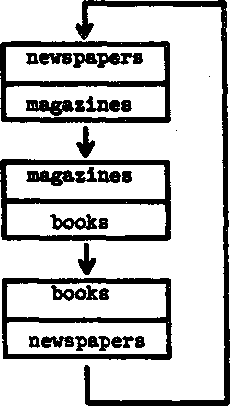
The cards for the first round list items only. The cards for the second round also list quantities for some items.
Procedure: Discussion in a group. Each player is dealt a hand from the deck of 2b cards. (All cards are dealt.) One person plays a card from his hand, announcing one of the purchases listed on it: W3 zhèr y3u ytge rén, CThis sentence ’’introduces” the shopper.3 Ta m£i zázhì le.
The player who has the other card listing that purchase then "chains" with the other purchase written on his card: MSi zézhìde nèige rén yè mSi shǔ le. CNotice how the modifying clause identifies the shopper as the same one Just mentioned.!
Eventually the chain loops back to the first player, who points this out: MSi bàode nèige rén yé mSi zézhì le. Nīmen yījīng zhīdao tā mSi zézhì le.
Then another player starts another chain in the same way.
Bxanmle: You are Speaker 1. You have a card listing "newspapers/magazines.” Speaker 2 and Speaker 3 have "magazines/books" and "books/newspapers."
SI: W8 zhèr y8u yíge rén. Tā mSi zázhì le.
S2: MSi zázhìde nèige rén y? mSi shǔ le.
S3: MSi shǔde nèige rén yS mSi bèo le.
SI: MSi bìode nèige rén yS mSi zézhì le. Nīmen yījīng zhīdao tā mSi zézhì le.
(Remember that there will be six cards in a chain.)
Additional Note: In the follow-up discussion, it may be helpful to place the cards on a table to form chains, as in a real game of dominoes.
Practice Points: Modifying clauses, completed action with "amount" and "nonamountN objects.
CARDS—DOMINOES (SHOPPERS) AB CD (ROUND 1)
|
large apples |
oranges |
beer |
maps of Bíijīng |
|
books |
American magazines |
yellow umbrellas |
bookcases |
|
books |
American magazines |
yellow umbrellas |
bookcases |
|
chairs |
tables |
soda |
rugs |
|
chairs |
tables |
soda |
rugs | |
|
large dishes |
white rice bowls |
teacups |
blue rice bowls |
A BCD (ROUND 1)
|
large . dishes |
white rice bowls |
teacups |
blue rice bowls |
|
newspapers |
pastries |
vases |
small dishes |
|
newspapers |
pastries |
vases |
small dishes |
|
green umbrellas |
maps of China |
small apples |
Chinese magazines |
|
green umbrellas |
maps of China |
small apples |
Chinese magazines |
|
large apples |
oranges |
beer |
maps of Beijing |
A B CD (ROUND 2)
|
2 catties of apples |
1 newspaper |
1 catty of apples |
6 bottles . of beer |
|
5 books |
magazines |
pastries |
oranges |
|
5 books |
magazines |
pastries |
oranges |
|
chairs |
soda |
vases |
2 newspapers |
|
chairs |
soda |
vases |
2 newspapers |
|
1 umbrella |
2 umbrellas |
12 books |
1 table |
B
C
D (ROUND 2)
|
1 umbrella |
2 umbrellas |
12 books |
1 table |
|
rice bowls |
2 tables |
U bottles of beer |
teacups |
|
rice bowls |
2 tables |
U bottles of beer |
teacups | |
|
blue dishes |
red dishes |
rugs |
maps |
|
blue dishes |
red dishes |
rugs |
maps | ||
|
2 catties of apples |
1 newspaper |
1 catty of apples |
6 bottles of beer |
INSTRUCTIONS:
Type: Dominoes (BIO Review) This game is played the same way as Communication Game A for this unit.
Materials; Instead of the names of two purchases, you will find on each card biographic information about one of four Americans in Taipei. (See Cards—Dominoes, which follow.) Here is one chain of six cards:
TIME OF ARRIVAL
COLLEGE MAJOR
PLACE OF EMPLOYMENT
CURRENT RESIDENCE
NUMBER OF CHILDREN
FAVORITE PURCHASE
TIME OF ARRIVAL

Example: You are Speaker 1. You have the "Taiwan University/First Hotel" and "4 children/teacups" cards.
SI: Wō zhèli yōu yíge rén. Tā zhù zai Dìyi Dàfàndiàn.
S2: Zhù zai Dìyī Dàfàndiànde nàge rén yōu sìge háizi.
SI: You sìge héizide nàge rén xīhuan mài chábēi.
S3: Xihuan mài chábēide nàge rén shi qiántiān láide.
SU: Qiántiān láide nàge rén niànguo Zhōngguo lìshì.
S3: Niànguo Zhōngguo lìshide nàge rén zài Taiwan Dàxué gōngzuò.
SI: Zài Táiwān Dàxué gōngzuōde nàge rén zhù zai Dìyi Dàfàndiàn.
WSmen yījīng zhldao tā zhù zai Dìyi Dàfàndiàn, shi bu shi?
CARDS—DOMINOES (BIO Review) A B C D
|
yesterday |
last week |
last month |
last year |
|
economics |
political science |
Chinese history |
Chinese literature |
|
economics |
political science |
Chinese history |
Chinese literature |
|
Bank of America |
State Department |
U.S. Military Attache's Office |
U.S. International Communications Agency |
|
Bank of America |
State Department |
U.S. Military Attache's Office |
U.S. International Communications Agency |
|
Ambassador Hotel |
Hr. Li's bouse |
198 Dàlǐ Street |
Tiānmǔ |
A BCD
|
Ambassador Hotel |
Mr. Li's house |
198 Dàlǐ Street |
Tiānmǔ |
|
no children |
3 children |
2 children |
1 child |
|
no children |
3 children |
2 children |
1 child |
|
pastries |
maps |
vases |
books |
|
pastries |
maps |
vases |
books |
|
yesterday |
last week |
last month |
last year |
EXERCISE 1
This exercise is based on the review dialogue at the end of the C-l tape. You will work on your comprehension of the words and patterns introduced in this unit.
In this conversation, Mr. Ferrara is checking out of his hotel in BSijīng. He is receiving his bill.
You will hear the conversation twice. Then each sentence will be followed by a pause for your translation. After the pause, the speaker will give an acceptable English equivalent of the sentence.
EXERCISE 2
This exercise will give you practice in following currency transactions involving PRC currency. In this exercise you will listen to an American in Beijing who is talking to a Chinese acquaintance.
You will hear the conversation three times. After listening to it for the second time, read the questions below, and write the answers as you listen for the third time.
QUESTIONS
1. Did the American have any money left after he made his purchases? ( ) Yes ( ) No
2. How much money in People’s currency did the American have?
(HINT: Find out from the dialogue how much People's currency you get for one U.S. dollar. Then multiply by the amount of the American's traveler's checks.) ■
3. What items did he buy, and how much did he spend for them?
ITEMS PRICE IN PEOPLE'S CURRENCY
U. In People’s currency, what is the total amount that the American spent?
EXERCISE 3
In this exercise, a Canadian student in Béijlng is talking to a Chinese student about some gifts the Canadian has just bought to send to her family. You will hear the conversation three times. Answer the question below as you listen for the third time.
Here is a new word you will find in the dialogue:
YSuyí Shāngdièn (Friendship Department Store)
QUESTION
1. List the family members that the Canadian bought things for and the item that she bought for each person.
PERSON ITEM HOW MANY
EXERCISE 4
In this exercise you will listen for expressions you understand in a conversation that is partly' over your head. Mr. Todd is just finishing his shopping in the Friendship Department Store in BXijlng. While listening to his conversation for the third time, answer the questions below.
QUESTIONS
1. How much money did the American need to pay for his purchases? _________________________
2. How much did he have? ______________
3. What kind and amount of currency did he change at the bank? What amount did he end up with?
CURRENCY CHANGED _______________________________
CURRENCY OBTAINED ;
H. Does the Nationalities Hotel accept U.S. currency?
( ) Yes ( ) No
EXERCISE 1
Tliis exercise will give you a chance to talk about amounts of money changed.
Display I shows the names of four people, the amount of money they changed on certain days, and the total amount they changed during that time. Use this information to answer the questions on tape.
Example
TAPE: Āndásēn Xiānsheng Sānyue Èrshihào huànle duōshao qián?
YOU: Tā huànle yìbāikuāi Māijīnde luxíng zhlpiào.
TAPE: Tā Sānyuè Èrshiqíhāo huānle duōshao qián?
YOU: Tā méi huàn qián.
TAPE: Tā jlntiān huànle duōshao qián?
YOU: Tā Jíntiǎn huànle qīshiwvkuài Māijln.
TAPE: Tā yfgōng huānle duōshao qián le?
YOU: Tā yígōng huànle yìbāi qīshiwǔkuāi MeijIn le.
Notice that after money amounts you can use Māijīn or qián, but not both: qīshiwǔkuāi qián or qīshiwǔkuai Māijīn.
DISPLAY I
MARCH 20 MARCH 27 TODAY TOTAL (So Far)
|
Mr. Anderson (índásěn) |
U.S. 3100 in traveler’s checks |
0 |
U.S. 375 |
U.S. 3175 |
|
Miss Novak (Nuòw’akè) |
U.S. 350 |
u.s. 3100 in traveler’s checks |
0 |
U.S. 3150 |
|
Mr. Bauer (Bāoer) |
U.S. 3150 |
0 |
u.s. 3100 in traveler’s checks |
U.S. 3250 |
|
Mr. Martin (Mādíng) |
0 |
U.S. 3175 |
U.S. 375 in traveler’s checks |
U.S. 3250 |
EXERCISE 2
In this exercise you will have a chance to use the completion marker le with amount and nonamount objects. Display II shows what certain Americans bought for their new residences' in Taipei. If an item was bought, there is a check in the appropriate box. If the amount bought is known, then the number is shown. If none was bought, there is a "no” in the box.
Use the display information to answer the questions. Repeat confirmations.
Example
TAPE: Wang Xiǎnsheng mǎi shcuyīnjī le ma?
YOU: Tā rnaile liǎngge shōuyīnjī.
TAPE: Diànshì ne?
YOU: Tā yě mai diànshì le.
TAPE: Shūjiàzi ne?
YOU: Tā méi mai.
The additional required vocabulary used in this exercise is: shouyīnjī (yfge shouyīnjī) (radio)
diànshì (yfge diànshì) (television)
diànshàn (yfge diànshàn) (electric fan)
DISPLAY II
|
RADIOS |
TELEVISION |
BOOKCASE |
ELECTRIC FANS |
TABLES |
CHAIRS | |
|
Daniel King |
2 |
no |
U |
• s |
6 | |
|
Major Weiss |
1 |
iX |
2 |
U | ||
|
Peter Cook |
no |
2 |
1 |
2 |
EXERCISE 3
In this exercise you will use place phrases like wSmenzhēli, "our place (here)," and Wáng Xiǎnsheng nàli, "Mr. wing's place (there)." The conversation takes place in Taipei, where four women share a college dormitory room. Each person has her own corner of the room, "her place." He Guìfēn and Qián Ailing are sitting on their beds. They are asking each other where in the room (i.e., in whose corner of the room) various items are. (Display III shows the room.)
Answer each question on tape before the roommate does; then listen to her answer and repeat it.
Example
TAPE: Qián Ailing, w3de níbēn (Qián Ailing, where is that poli-zhèngzhixuá zài náli? tical science book of mine?)
YOU: Zài wǒ zhèli. (It’s here in ny place.)
Notice that full names are used.
DISPLAY III
THE DORMITORY ROOM
IX Qiūxiá
Bái Yùzhēn
(not in the room)
Bái Yùzhēn's English-
Chinese dictionary

some magazines

today’s newspaper

(not in the room)
Hi Guìfēn*s American JgSP/ history book C__5<
Qián Ailing's American literature book -——a/
Hi Guìfēn's economics
book ^-^3/
(S)
I2nd speakerp—

He Guìfēn's political science book
He Guìfēn's Chinese-English dictionary
INSTRUCTIONS:
Type: Five of a Kind
Situation: You and several other people exchange money so that each of you will have only bills or coins of a single denomination.
Goal: To get five cards shoving the same denomination.
Number of Players: Groups of four to six students.
Materials: Cards listing six different combinations of money. The total value of each card is ¥10 in People's currency. The six combinations are
one ¥1Ō bill yìzhāng shíkuàide
two ¥5 bills liSngzhāng wukuàide
ten ¥1 coins shíge yíkuàide
twenty ¥.50 coins ìrshige wSmáode
one hundred ¥.10 coins yìb&ige yìmíode
tv© hundred ¥.05 coins liSngb&ige vSfēnde
There are five cards for each combination. Bills are shorn as rectangles and coins as circles. (See Cards—Five of a Kind, which follow.)
Procedure: 1) Make up a deck of cards including only.as many money combinations as there are players. For example, if there are four players, remove the ten cards for two combinations.
2) Shuffle the cards.
3) Peal all the cards. Each player then has a five-card hand.
b) Players take turns trying to exchange certain cards with other players. The winner is the player who gets five cards alike.
5) Cards may be shuffled and redealt for another round. In a group of fewer than six players, the money combinations not in play should be different for a second round.
Example: You are Speaker 1. You have the following hand:
one ¥10 bill
one ¥10 bill
two ¥5 bills
two ¥5 bills
ten ¥1 coins
You naturally want to exchange your ¥1 coins for ¥5 or ¥10 bills.
SI: M&fan ni, w8 zhèr y3u shíge yíkuàide. Qlng ni gSi wo huànhuan.
S2: NI yào z?nme huàn?
SI: Qlng gSi wo liSngzhǎng wǔkuàide.
82: Duìbuqī, w8 méi wǔkuàide.
SI: Nl ySu mSiyou yìzhāng shíkuàide?
S2: Yǔu.
SI: Wǔmen huànhuan ba.
82: HSo.
You now have a full house. Later you will try to exchange your ¥5 bills for ¥10 bills to give you five of a kind.
Practice Points: Changing money.
CARDS—FIVĒ OF A KIND

|
1 ¥10.00 |
1 ¥10.00 |
2 ¥5.00 |
2 ¥5.00 |
|
• |
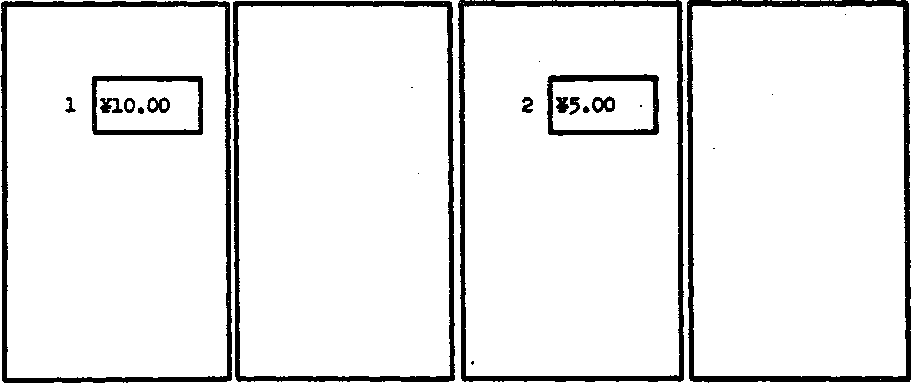
|
IQ^sZpO^ |
10 ^KO^ |
20 ^50^ |
20 ^‘5°^ |
|
10 |
20 |
20^50^ | |
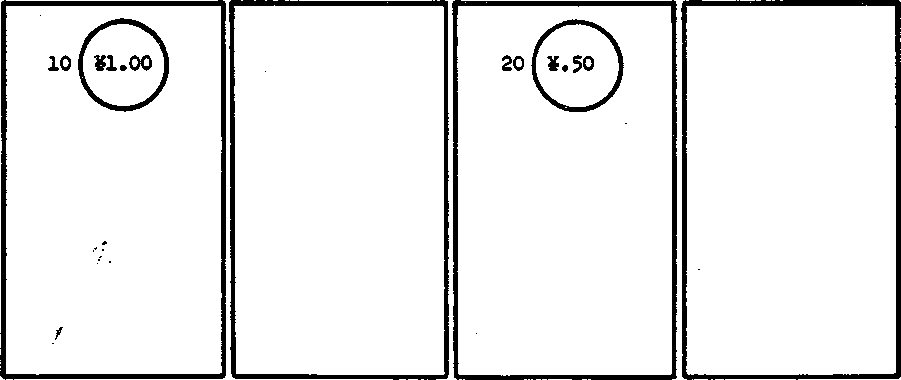
6U
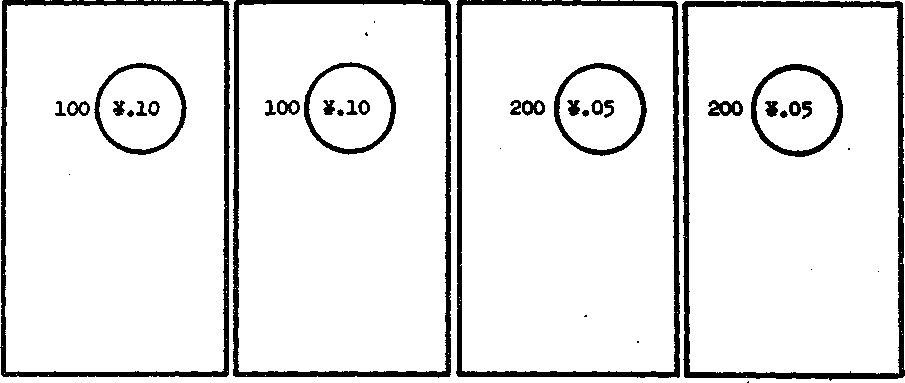

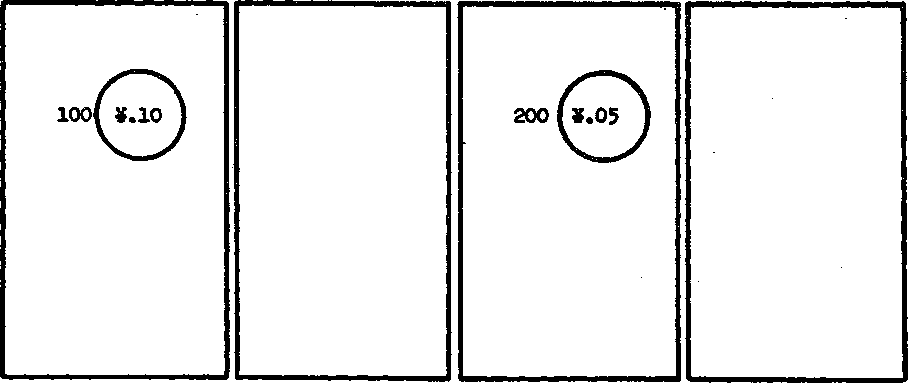
EXERCISE 1
Now you will practice following money transactions involving bills of different denominations. In this conversation, Mr. Perez is just completing a purchase at a fruit seller's, which happens to be next door to a small tailor shop in Taipei.
You will hear the conversation three times. As you listen to it for the third time, answer the questions below.
QUESTIONS
1. At first, the customer wanted to pay with what kind of bill?
2. The clerk gets bills of what denomination for the customer?
3. What change does the clerk give to the customer when he finally
———
h. Is this the correct change? ( ) Yes ( ) No
EXERCISE 2
Six young men (listed on the next page) work in the same office building in Taipei. One day last week they arranged to meet during the day to make plans for a mountain-climbing trip. As it happened, their working hours that day were rather unusual.
You will hear their working hours three times. As you listen, write this information next to the men's names. Then answer the question "What time did the men meet?" (The answer will be on the hour or half hour.)
Here are the new words you will need for this exercise:
zKoshang (morning—6 a.m. to 11 a.m., full daylight until
almost noon)
shàngwǔ. (morning, forenoon—9 a.m. to noon, normal business day until noon)
xiàwǔ (afternoon—noon to 5 p.m., the end of the business
day)
w&nshang (evening—5 p.m. to 11 p.m.)
Time spans given for these terms are, of course, approximate. (For additional details, see the last Reference Notes in the Unit 6 text.)
Clock time in Chinese may be preceded by a time-of-day word. Here are a few examples:
shàngwǔ shídiān zhōng. (ten o'clock in the morning) xiàwǔ sìdiān ban (four-thirty in the afternoon)
wānshang jiǔdiān zhōng (nine o'clock in the evening) Notice that the time-of-day word precedes the hour in Chinese.
MEW CAME LEFT
Yáng ZhìyuSn _________ ________
Lin Zìqiáng __________ _______
Zhāng Shàowín _________ ___________
Ōuyáng Huá __________ ■ ~
Huáng Zhènhàn ___________ ___________
Jiāng Shìyīng __________ __________
QUESTION
1. What time did the men meet? ____________
EXERCISE 3
In this exercise you will hear Mr. Paulsen talking to a teller in a Taipei bank. Listen for the various kinds of bills involved in the transaction.
You will hear the conversation three times. As you listen to it for the third time, answer the questions below.
QUESTIONS
1. What did Mr. Paulsen start out with?
( ) one $200 traveler's check
( ) two $100 traveler's checks
( ) twenty $10 traveler's checks
2. How many of each kind of bill did Mr. Paulsen end up with?
$100 bills .$10 bills
EXERCISE 4
Nov you will listen to time-of-day words and clock times. You may not understand every word in the conversation, but you should be able to answer the question below.
Miss Sdng, a nurse, is being asked about when she starts work. Listen to the conversation three times. Then answer the question.
Here are some nev words you will need for this exercise:
|
kāishl y3ude shíhou |
(to start, to begin) (sometimes) |
QUESTION
1. What are the starting times of the shifts Miss Sdng might work?
TIME OF DAY CLOCK TIME
EXERCISE 1
In this exercise you will have a chance to give someone the exact time of day and to use the aspect marker shi...de.
Display I shows the names of people coming for a conference today at a local university. It also shows their arrival times. Mr. Zhèng, who has Just arrived, is interested in knowing what time people got in or are due to arrive. Answer his questions according to the information in the display.
Example 1
Q: Sun Zhènhàn shi Jīntiān JidiSn zhong l&ide?
A: Tā shi Ji&diSn hín líide.
If someone has not arrived yet, you must first explain this and then provide his time of arrival.
Example 2
Q: Li Tíngfēn ne?
A: Tā h&i měi lāi. Tā shíārdiān zhong l£i.
DISPLAY I
|
9:30 |
10:00 |
10:30 |
11:00 |
NQW 11:30 fl2:00 |
12:30 |
1:00 |
1:30 |
2:00 | |
|
Sun Zhènhān |
X |
1 | |||||||
|
Li Tíngfēng |
1 X | ||||||||
|
Bai Huìrān |
X |
1 | |||||||
|
Shi Guóquān |
1 |
X | |||||||
|
Gāo Bingyíng |
X |
1 | |||||||
|
Jiāng Shìyīng |
X 1 | ||||||||
|
Wíng Défēn |
1 |
X | |||||||
|
Ouyáng Cheng |
X |
1 | |||||||
|
Deng Shàowén |
1 |
X | |||||||
|
Bāo MSilíng |
1 |
X |
EXERCISE 2
In this exercise you practice giving clock time and using time-of-day words.
Display II shows the names of nurses working at a hospital in Běijīng. It also shows the shifts they will be working for the next two weeks. Base your answers to the recorded questions on the information in this display.
Example
TAPE: Hé Wénqing JldiSn zhōng kāishī gōngzuō?
YOU: Tā zāoshang qīdi&n zhōng kāishī gōngzuō.
Notice that, in the answer, the word "morning" is added to the hour to avoid confusion about which "seven o’clock" is meant. Include the words "morning," "afternoon," and "evening" in your answers.
Here are the new vocabulary iter« you will need in this exercise: sSoshang (morning—6 a.m. to 11 a.m.)
xiàwS (afternoon—noon until the end of the business day)
wānshang (evening—end of the business day until 11 p.m.)
kāishī (to start, to begin)
DISPLAY II
|
7 a.m. |
3 p.m. |
11 p.m. | |
|
Hi Wínqlng |
X | ||
|
Ying Défēn |
X | ||
|
Zhang MSilíng |
X | ||
|
Bōng Xuéfēn |
X | ||
|
Xiè Bāolín |
X | ||
|
Sōng WSnrtì |
X | ||
|
Zhou Qiāoyún |
X | ||
|
Ting Juān |
X | ||
|
Mao Yùlin |
X | ||
|
Sun Mlnzhēn |
X |
EXERCISE 3
Display III shows the names of people who came for a conference at a local university and their departure times. Using the display, answer the two recorded questions about each person.
Example
TAPE: Sun Zhènhàn shi wānshang zōude ma?
YOU: Bú shi, tā shi zāoshang zōude.
TAPE: Tā shi Jldiān zhōng zōude?
YOU: Tā shi q,Idiān zhōng zōude.
For this exercise you will need the vocabulary item shàngwō, "morning (9 a.m. to noon).1' Although zāoshang mor be used to refer to the whole morning, shāngwō is often used to refer to a business-day morning. In this context, zāoshang refers only to 6 a.m. until 9 a.m., and shāngwtt refers to 9 a»m. until noon.
|
DISPLAY ill 1 |
A.M 9 a |
L i: « |
L 1 • |
3 |
I 5 f |
>JÍ. 7 . a |
9 |
i: • |
L __| |
|
1. Sūn Zhènhān 1 |
: i > |
I > |
1 1 |
8 » |
í t |
8 - 8 |
9 8 - |
i t |
1 —J |
|
2. Li Tíngfāng |
i g |
: * • |
1 • |
8 5 |
8 | |
1 | - |
8 I |
8 _____| | |
|
3. Shi Guōquín |
1 |
■ |
í 1 |
1 ] a |
: 8 |
1 I |
1 8 - |
1 j |
1 __4 |
|
U. Gāo Bīngyíng |
1 a |
i |
1 1 |
1 a |
i । |
s : - i |
; 1 ■ 1 ■ |
8 ■ 8 |
8 |
|
5. Ōuyāng Cheng |
1 |
X |
1 í |
1 a |
1 i |
i ■« |
8 a |
I . I |
8 —J |
|
6. Deng Shàowén |
1 1 |
í a |
í í |
1 |
1 1 í |
: । |
8 |
1 I |
1 —8 |
|
7. Bāo MSilíng |
1 |
1 1 |
1 a |
1 1 |
1 • |
8 1 |
1 |
8 | |
8 _j |
|
8. Bái Huìrān |
1 |
I a |
1 a |
í a |
8 i |
1 ■ . |
1 2 |
8 । |
1 1 |
|
9. Jiāng Shìying |
X |
1 1 |
1 a |
1 a |
1 1 |
1 i |
8 | |
1 1 |
1 _4 |
|
10. Wing Defēn |
ì 8—4--- |
I : 1—i— |
: i 8—4— |
1 1—4— |
1 -4— |
1 L-4— |
1 —4— |
1 —1— |
1 _______1 |
INSTRUCTIONS:
Type: Meeting
Situation: It is the beginning of the school year at a college in Taipei. You and three other students have your new class schedules. You are trying to figure out when you can get together every day as a study group.
Goal: To find an hour during the school day when all four of you are free.
Number of Players: Groups of four students.
Materials: A work sheet for each player. (See Sample Work Sheets, which follow.) Under your name for this game, your daily class schedule is shown, with check marks indicating the hours at which you have classes.
Procedure: Mingle with the players in your group to exchange information.
Examole: You are Speaker 1. It is Round 1.
SI: WSmen kéyi JiSdiSn ban Jiàn ma?
S2: Bè kéyi. W8 ySu kè.
SI: WSmen yìdiSn zhōng Jiàn, xíng bu xíng?
S2: Xíng. Wō méiyou kè.
SI: SSndiin zhōng nl y8 méiyou kè ma?
S2: Méiyou. SāndiSn zhōng yé kéyi.
You would now question the other players. You ask only about the hours that Speaker 2 is free.
Practice Points: Clock time.
SAMPLE WORK SHEETS:
(BOUND 1)
|
Zhōu |
Li |
MS |
Wing | |
|
8:30 | ||||
|
9:30 | ||||
|
10:30 | ||||
|
11:30 | ||||
|
1:00 | ||||
|
2:00 | ||||
|
3:00 | ||||
|
U:00 |
(BOUND 2)
|
Zhōu |
LI |
Ml |
Wing | |
|
8:30 | ||||
|
9:30 | ||||
|
10:30 | ||||
|
11:30 | ||||
|
1:00 | ||||
|
2:00 | ||||
|
3:00 | ||||
|
lt:OO |
(BOUND 3)
|
Zhōu |
IS |
Mg |
Wing | |
|
8:30 | ||||
|
9:30 | ||||
|
10:30 | ||||
|
11:30 | ||||
|
1:00 | ||||
|
2:00 | ||||
|
3:00 | ||||
|
U:00 |
(ROUND 1)
|
Zhōu |
II |
MS |
Wang | |
|
8:30 | ||||
|
9:30 |
yf | |||
|
10:30 • |
yf | |||
|
11:30 | ||||
|
1:00 |
yf | |||
|
2:00 | ||||
|
3:00 | ||||
|
U:00 |
(ROUND 2)
|
Zhou |
LI |
MS |
Wang | |
|
8:30 | ||||
|
9:30 | ||||
|
10:30 |
yf | |||
|
11:30 |
yf | |||
|
1:00 | ||||
|
2:00 | ||||
|
3:00 | ||||
|
U:00 |
(ROUND 3)
|
•- |
Zhōu |
II |
MS |
Wang |
|
8:30 | ||||
|
9:30 |
yf | |||
|
10:30 | ||||
|
11:30 |
yf | |||
|
1:00 | ||||
|
2:00 | ||||
|
3:00 | ||||
|
U:00 |
(ROUND 1)
|
Zhōu |
MX |
Wing | ||
|
8:30 | ||||
|
9:30 | ||||
|
10:30 | ||||
|
11:30 | ||||
|
1:00 | ||||
|
2:00 | ||||
|
3:00 | ||||
|
ìkOO |
(ROUSD 2)
|
Zhōu |
II |
MX |
Wing | |
|
8:30 | ||||
|
9:30 |
if | |||
|
10:30 |
y/ | |||
|
11:30 | ||||
|
1:00 |
yf | |||
|
2:00 | ||||
|
3:00 | ||||
|
U:00 |
(ROUND 3)
|
Zhōu |
II |
MX |
Wing | |
|
8:30 | ||||
|
9:30 | ||||
|
10:30 | ||||
|
11:30 |
yf | |||
|
1:00 | ||||
|
2:00 |
yf | |||
|
3:00 | ||||
|
l>:00 |
yf |
(ROUND 1)
|
Zhou |
II |
MS |
Wang | |
|
8:30 | ||||
|
9:30 |
if | |||
|
10:30 | ||||
|
11:30 | ||||
|
1:00 | ||||
|
2:00 | ||||
|
3:00 | ||||
|
U:00 |
(ROUND 2)
|
Zhou |
LI |
MS |
Wang | |
|
8:30 | ||||
|
9:30 | ||||
|
10:30 | ||||
|
11:30 | ||||
|
1:00 | ||||
|
2:00 | ||||
|
3:00 | ||||
|
U:00 |
(ROUND 3)
|
Zhōu |
II |
MS |
Wáng | |
|
8:30 |
✓ | |||
|
9:30 | ||||
|
10:30 | ||||
|
11:30 | ||||
|
1:00 | ||||
|
2:00 | ||||
|
3:00 | ||||
|
l»:00 |
(ROUND 1)
|
Zhōu |
LI |
MS |
Wing | |
|
8:30 |
• | |||
|
9:30 | ||||
|
10:30 | ||||
|
11:30 | ||||
|
1:00 | ||||
|
2:00 | ||||
|
3:00 | ||||
|
U:00 |
(ROUND 2)
|
Zhōu |
Li |
Wing | ||
|
8:30 | ||||
|
9:30 | ||||
|
10:30 | ||||
|
11:30 | ||||
|
1:00 | ||||
|
2:00 | ||||
|
3:00 | ||||
|
^:00 |
(ROUND 3)
|
Zhōu |
Li |
MS |
Wáng | |
|
8:30 | ||||
|
9:30 | ||||
|
10:30 | ||||
|
11:30 | ||||
|
1:00 | ||||
|
2:00 | ||||
|
3:00 | ||||
|
U:00 |
INSTRUCTIONS:
Type: Matching
Situation: - It is the beginning of the school year at a college in Taipei. You and three other students have your new class schedules. You are comparing them to see what classes two or more of you will be attending together. (There is only one class for each subject at any given hour; so having a class at the same time means attending it together.)
Goal: To find matches in classes.
Number of Players: Groups of four students.
Materials: A work sheet for each player. (See Sample Work Sheets, which follow.)
|
Example: |
You are Speaker 1. It is Round 1. |
|
SI: S2: SI: S2: SI: |
JiudiSn zhōng nì ySu kè ma? YSu. YSu shénme kè? YSu yìténg JīngJixué. Ni ne? JiǔdiSn zhōng wS ySu yìténg zhìngzhixué. |
(etc.)
Additional Note: For this game, you will need to know the counter for class periods, -téng.
Practice Points: Clock time, review of academic subjects.
SAMPLE WORK SHEETS:
(ROUND 1)
|
Zhōu |
LI |
MS |
Wfing | |
|
9:00 |
Pol. Sei.' | |||
|
10:00 |
Eng. Lit. | |||
|
11:00 | ||||
|
12:00 |
Math | |||
|
1:30 |
Economics | |||
|
2:30 | ||||
|
3:30 | ||||
|
U:30 |
(ROUND 2)
|
Zhōu |
LI |
W&ig | ||
|
9:00 | ||||
|
10:00 |
Ch. Lit. | |||
|
11:00 |
Chemistry | |||
|
12:00 |
Ch. Hist. | |||
|
1:30 | ||||
|
2:30 |
Pol. Sci. | |||
|
3:30 | ||||
|
U:30 |
(ROUND 3)
|
Zhōu |
LI |
Mg |
Wáng | |
|
9:00 |
Math | |||
|
10:00 |
Japanese | |||
|
11:00 | ||||
|
12:00 |
Am. Hist. | |||
|
1:30 | ||||
|
2:30 | ||||
|
3:30 |
Economics | |||
|
U:30 |
(ROUND 1)
|
Zhōu |
LI |
M& |
Wang | |
|
9:00 | ||||
|
10:00 |
English | |||
|
11:00 |
Eng. Hist. | |||
|
12:00 |
Eng. Lit. | |||
|
1:30 | ||||
|
2:30 | ||||
|
3:30 |
Math | |||
|
U:30 |
(ROUND 2)
|
Zhōu |
LI |
Ml |
Wang | |
|
9:00 |
Chemistry | |||
|
10:00 |
Eng. Lit. | |||
|
11:00 | ||||
|
12:00 |
Economics | |||
|
1:30 | ||||
|
2:30 |
Ch. Lit. | |||
|
3:30 | ||||
|
U:30 |
(ROUND 3)
|
Zhōu |
LI |
MS |
Wang | |
|
9:00 |
English | |||
|
10:00 |
Ch. Lit. | |||
|
11:00 |
Am. Hist. | |||
|
12:00 | ||||
|
1:30 |
Pol. Sci. | |||
|
2:30 | ||||
|
3:30 | ||||
|
U:30 |
(ROUND 1)
|
Zhōu |
LI |
MS |
Wáng | |
|
9:00 | ||||
|
10:00 |
English | |||
|
11:00 |
Economics | |||
|
12:00 | ||||
|
1:30 |
Pol. Sci. | |||
|
2:30 | ||||
|
3:30 |
Chemistry | |||
|
U:30 |
(BOUND 2)
|
Zhōu |
LI |
MS |
Wfing | |
|
9:00 |
Chemistry | |||
|
10:00 |
Ch. Lit. | |||
|
11:00 | ||||
|
12:00 |
Japanese | |||
|
1:30 |
Economics | |||
|
2:30 | ||||
|
3:30 | ||||
|
U:30 |
(ROUND 3)
|
Zhōu |
LI |
MS |
Wáng | |
|
9:00 |
English | |||
|
10:00 |
Chemistry | |||
|
11:00 | ||||
|
12:00 |
Economics | |||
|
1:30 | ||||
|
2:30 |
Eng. Lit. | |||
|
3:30 | ||||
|
U:30 |
(ROUND 1)
|
Zhōu |
Li |
MS |
Wáng | |
|
9:00 |
Ch. Hist. | |||
|
10:00 | ||||
|
11:00 |
English | |||
|
12:00 |
Eng. Lit. | |||
|
1:30 |
Pol. Sci. | |||
|
2:30 | ||||
|
3:30 | ||||
|
U:30 |
(ROUND 2)
|
Zhōu |
Lī |
MS |
Wáng | |
|
9:00 | ||||
|
10:00 | ||||
|
11:00 |
Chemistry | |||
|
12:00 |
Japanese | |||
|
1:30 | ||||
|
2:30 |
Ch. Lit. | |||
|
3:30 | ||||
|
U:30 |
Am. Hist. |
(ROUND 3)
|
Zhōu |
LI |
Mǎ |
Wáng | |
|
9:00 | ||||
|
10:00 |
Chemistry | |||
|
11:00 |
Am. Hist. | |||
|
12:00 |
Pol. Sci. | |||
|
1:30 | ||||
|
2:30 | ||||
|
3:30 |
Math | |||
|
U:30 |
(ROUND 1)
|
Zhōu |
Lī |
MS |
Wáng | |
|
9:00 |
Ch. Hist. | |||
|
10:00 | ||||
|
11:00 |
Economics | |||
|
12:00 |
Japanese | |||
|
1:30 | ||||
|
2:30 | ||||
|
3:30 |
Math | |||
|
U:30 |
(ROUND 2)
|
Zhōu |
LĪ |
MS |
W&ig | |
|
9:00 | ||||
|
10:00 |
Eng. Lit. | |||
|
11:00 |
English | |||
|
12:00 | ||||
|
1:30 |
Economics | |||
|
2:30 | ||||
|
3:30 | ||||
|
U:30 |
Am. Hist. |
(ROUND 3)
|
Zhōu |
Lí |
MS |
Wáng | |
|
9:00 | ||||
|
10:00 |
Ch. Lit. | |||
|
11:00 | ||||
|
12:00 |
Economics | |||
|
1:30 | ||||
|
2:30 | ||||
|
3:30 |
Math | |||
|
U:30 |
Japanese |
EXERCISE 1
In this exercise you will work on your comprehension of directions involving the words for "right,” "left," and "intersection."
In this conversation, an American student and a Chinese student are standing across the street from their boardinghouse in Taipei. The American student learned some Chinese in the United States. He has just arrived in Taipei for further study.
You will hear the conversation three times. As you listen to it for the third time, answer the questions on the next page.
You need to know four new expressions for this exercise:
zuSbianr (left side)
shūdiàn (bookstore)
Zhōngguo Wfaxué Shi (A History of Chinese Literature)
shāngdiàn (store, shop)
Dàole lùkōu means "having REACHED the intersection." The expression does not mean "having CROSSED the intersection." (See map below. The X represents dàole dìèrge lùkōu.)
BOAROiNG'
HOUSE

TWO
STUDENTS
FACING
EAST

QUESTIONS
1. How do you get to Taiwan University from "here’’ (i.e., where the students are standing)? (For the route, draw a line from the students to the university. For Taiwan University, draw a circle on the map.)
2. How do you get to the Student Bookstore (Xuěshēng Shūdiàn) from Taiwan University? (Show the route and mark an X on the map for the bookstore.)
3. In which direction is the small shop where you can buy soap? (Indicate the direction by an arrow beginning where the students are and pointing towards the shop.)
BOARDING*
HOUSE

TWO STUDENTS FACING EAST
EXERCISE 2
In this exercise you will work on your comprehension of the words for "from," ”to,” and "by way of." Mr. Randolph, an American businessman, is t.aiking with his friend Mrs. Zhāng, a Chinese woman living abroad.
You will hear the conversation three times. As you listen to it for the third time, answer the Questions on the next page.
Here are three new words you need to know for this exercise:
Jíngguo ("by vay of, via)
Jin (to be close, to be near)
fingbian (to be convenient)
The place names you need for the exercise are given below.

In this unit you saw the phrase "go to..." translated as dào...qù. In giving the stages of a long itinerary, however, dào is usually used alone, without qù, as in W5 qùnián c6ng Niǔ Yuē dào Dōngjīng, cóng Dòngjīng dào XiānggSng, c6ng XiānggSng dào BSiJīng.
QUESTIONS
1. Was it last year that Mr. Randolph vent to China through Europe? ( ) Yes ( ) No
2. Is it cheaper to go to China via San Francisco?
( ) Yea ( ) No
EXERCISE 3
This exercise will give you practice in recognizing the prepositional verb dao and the full verb <5 in different situations. In this conversation two Chinese students are talking about their study plans at Taiwan University.
You will hear the conversation three tines. As you listen to it for the third tine, answer the questions below.
Here are two expressions you need for this exercise:
kāi xué (school starts Cliterally, "open school*!)
h&i bù yídìng (not yet certain)
This conversation contains a number of sentences involving the purpose of as action. You have already learned sentences involving the purpose of someone’s "coming":
Ni l&i zuà shfome? (What did you come to do?)
Here you will find sentences about the purpose of studying and going:
NI sue Rìwén zuB shénme? (Why are you studying Japanese?)
W8 xiSng dìo RìbSn qù (I’m thinking of going to Japan
nian shǔ. to study.)
QUESTIONS
1. Do both students have definite plans to study overseas?
( ) Yes ( ) No
2. Is it more expensive to study in Japan than in the United States? ( ) Yes ( ) No
DIALECT LISTENING EXERCISE
A Dialect Listening Exercise is a conversation from a preceding exercise spoken with a different pronunciation. You will learn to understand Chinese as pronounced by speakers of Chinese languages who have learned Standard Chinese as a second language.
One common characteristic of dialect speech is that words which would start with the sounds /ah/, /ch/, and /sh/ (i.e., retroflex, or /r/-position, sounds) in Standard Chinese are pronounced with the sounds /z/, /c/, and /s/ (i.e., dental, or /s/-position, sounds). Also, initial /r/ may be pronounced like an English 1., or z_.
EXERCISE 1
In this exercise you will ask for directions. You will also practice a technique that will help you understand directions: breaking down the directions into steps.
Using the "maps" of Taipei in Display I, ask directions to the place named at the top of each map. For instance, the first place you are looking for is the bank. So your conversation starts out like this:
Example 1
YOU: Qíngwèn, dào yính&ng qù, zSnme z8uT
CRepeat confirmation.]
TAPE: Cong zhèli wàng zuS z3u. Dàole lùkíu, zài wáng ydu z3u, jiù dào le.
Your second task in this exercise is to listen to the directions given and to indicate the route by drawing a line on the appropriate map. (The directions will be repeated.)
How your third task: breaking down the directions into steps. Using the route you have just mapped out, take the first step of the directions and ask if that is what you do first. Then ask what comes after that. For instance:
Example 2
YOU: W3 xiàn wàng zu3 z5u, duì bu dui?
TAPE: Duì le.
YOU: RánhSu ne?
TAPE: Ránhòu, dàole 13k3u, zài wàng ydu z8u.
YOU: HSo. Xiàxie.
For this exercise you need to know the word xi&oxué, "grade school "primary school."
DISPLAY I

4. From the elementary school

: Indicates starting point and direction faced.
EXERCISE 2
Tn this exercise you will talk about sequences of actions. You are to describe where you went*yesterday, where you are going today, where you will go tomorrow, and so on.
Looking at Display II on the next page, you will see three lists showing places you went or will go to. Using this information, answer the recorded questions. (When taking your answers from a list, assume that today's date is the date given at the top of that list.)
Example 1
TAPE: Ní Jīntiān dào náli qù?
YOU: W3 xiān dào MSiguo Yínháng qù, ránhùu dào T&iwān Yínháng qù.
When answering questions about a completed action, use the shi...de construction, since you are focusing on WHERE you went, not on whether or not you went. When using shi...de in clauses, shi is sometimes omitted.
Example 2
TAPE: ZuétiSn ne?
YOU: W3 shi xiàn dào Guóbln Dàfàndiàn qùde, ránhdu dào fànguSnzi qùde.
(Notice that in the second clause there is no shi.)
DISPLAY II
LIST 1
(Today is September 11.)
DESTINATIONS
|
TODAY |
Bank of America |
Bank of Taiwan |
|
YESTERDAY |
Ambassador Hotel |
a restaurant |
|
TOMORROW |
Bank of America |
the First Hotel |
|
DAY AFTER TOMORROW |
Taiwan University |
a restaurant |
LIST 2
(Today is December 10.)
DESTINATIONS
|
TODAY |
Taiwan University |
HuámSi Coffeehouse |
|
YESTERDAY |
the First Company |
Taiwan University |
|
TOMORROW |
Taiwan University |
a restaurant |
|
DAY AFTER TOMORROW |
the First Company |
Huaměi Coffeehouse |
LIST 3
(Today is March 23.)
DESTINATIONS
|
TODAY |
Taiwan University |
Zhōngshān Elementary School |
|
YESTERDAY |
Hépíng Elementary School |
Taiwan University |
|
TOMORROW |
Zhōngshān Elementary School |
Hépíng Elementary School |
|
DAY AFTER TOMORROW |
Taiwan University |
Hépíng Elementary School |
EXERCISE 3
In this exercise you will ask two types of questions which call for yes/no answers. You have -learned how to ask yes/no questions by offering a choice between the "yes" answer and the "no" answer.
|
"YES” ANSWER |
"NO" ANSWER |
YES/NO-CHOICE QUESTION |
|
Tā lái. |
Tā bù lái. |
Tā lái bu lái? |
It is also possible to follow this pattern to form questions about actions which are completed:
"YES" ANSWER "NO" ANSWER YES/NO-CHOICE QUESTION
|
Tā lái le. |
Tā méi(you) lái. |
Tā lái le máiyou? |
The speaker on tape will give the ANSWER to a question. Then you are to ask the QUESTION that prompted the answer, using the appropriate yes/no-choice question.
Example 1
A: Tāmen nàli bfi mài MSiguo zázhì.
Q: Tāmen nàli mài bu mai MSiguo z&zhì?
As you know, Tāmen nàli mài MSiguo z&zhì bu mai? is also correct, but the speaker will confirm with the question in the example.
Example 2
A: Tā zSu le.
Q: Tā zSu le meiyou?
Keep in mind that měiyou can be the negative of the main verb ySu (a state verb) as well as the marker of the negative of completed action. Here is an example of the negative of ySu:
A: WS meiyou qián. (I don't have any money.)
Q: Ní ySu meiyou qián? (Do you have any money?)
Here is an example of the negative of completed action:
A: W3 měiyou huàn qián. (I haven't changed any money.)
Q: Ni huàn qián le máiyou? (Have you changed any money?)
INSTRUCTIONS:
Type: Tracing
Situation: The setting is Taipei. One person is giving directions to another over the telephone. Both have copies of the same map. The person giving directions has the route marked on his copy, and the person listening to the directions is trying to trade the route on his copy.
Goal: To have the same route marked on both maps.
Number of Players: Pairs of students.
Materials: Maps, either unlabeled or partially labeled with place names. (Both players have the same kind of map.)
Procedure: One player marks a route on his copy of the map. He gives directions to another player, who marks the route on his copy. Then the two players compare the routes they have marked.
The player giving directions may make the route as complicated as he wishes—the more complicated the better, within practical limits. He may at any time repeat himself or check to see if the other player has understood. The player receiving directions may at any time stop the other player, ask him to repeat, or check up on his own understanding.
With unlabeled maps, the starting point is indicated on both copies. With partially labeled maps, the player giving directions asks where the other player is now. The player receiving directions chooses a starting point and names it.
The same copies of the map, fresh copies, or different maps may be used for additional rounds of the game.
Example 1: (unlabeled map) You are Speaker 1. You have marked a route on your copy of the map (as shown on the first Sample Work Sheet).
SI: Cǒng nàli wàng yòu zǒu. Dàole làkǒu, zài wàng zuǒ zǒu.
S2: W5 xiān wàng yòu zSu, duì bu dui?
SI: Duì le.
S2: Ránhòu ne?
SI: Ránhòu, dàole lùkǒu, zài wàng zuǒ zǒu.
S2: Hǎo.
(etc.)
Example 2: (labeled map) You are Speaker 1. You have marked a route on your copy of the map. (See second Sample Work Sheet.)
S2: Dào nàli qù, zēnme z6u?
SI: NX xiànzài zài nāli?
S2: W5 xiànzài zài Huámēi Kāfēitlng.
SI: NX zhXdao bu zhidao Mēiguo WQguānchù?
S2: ZhXdao.
SI: Xian dào Mēiguo WQguānchù. Dàole Mēiguo WQguānchù, zài ytzhí z3u. Rfinhòu dàole lùkēu, zài vàng ydu z3u, jiù dào le.
S2: Wē xiān cóng Huémēi Kāfēitíng vàng ydu z5u. Rfinhdu, dàole dtsānge lùkēu, zài vàng ydu zēu, jiù dào le, duí bu dull
SI: Duì le.
(etc.)
Practice Points: Everything about'directions presented in the course to this point.
SAMPLE WORK SHEETS:





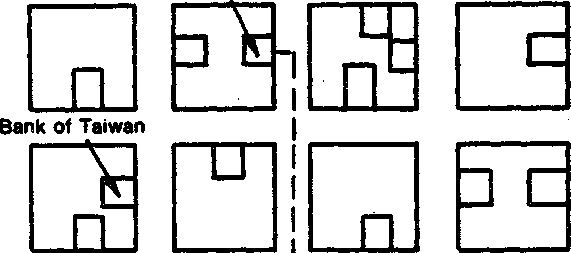


Shanghai Jiujiā*

U.S. Military Attache's Office

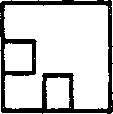


Dahuá Store


USICA



*Jiǔjiā means "restaurant" (literally, "wine house"). Fànguínr. and fSnguSnzi are seldom used in the names of restaurants.
UNLABELED MAPS for TRACING GAME


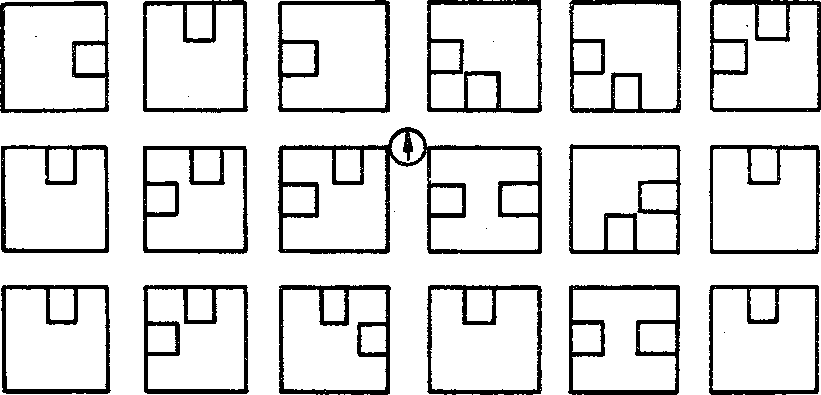


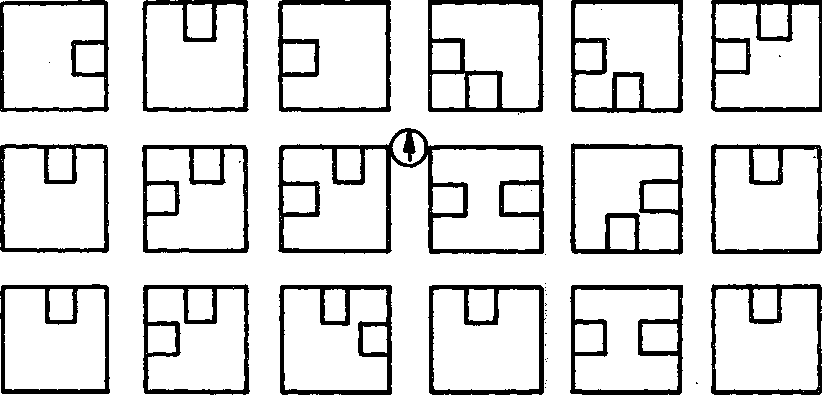
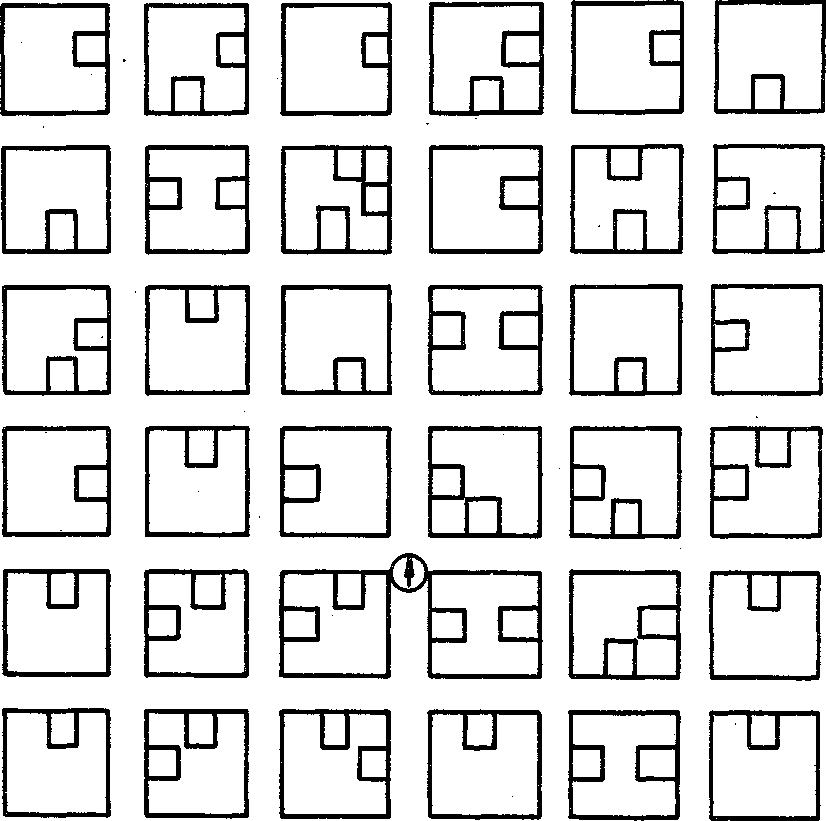



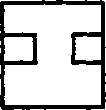









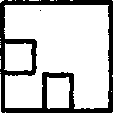








LABELED MAPS for TRACING GAME
First Hotel
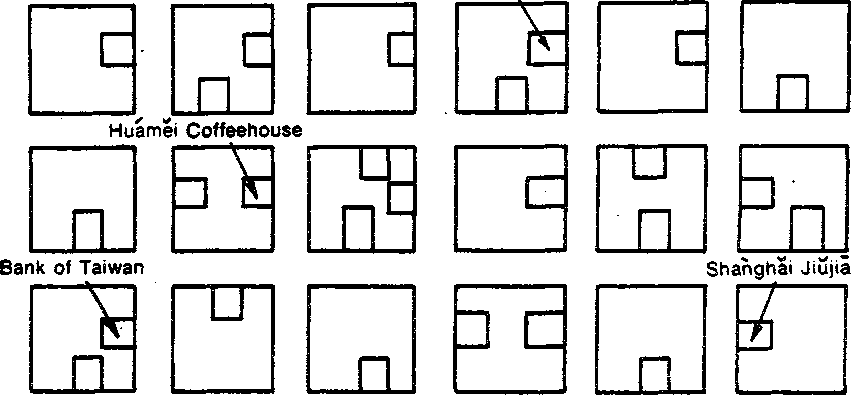
U.S. Military Attache's Office
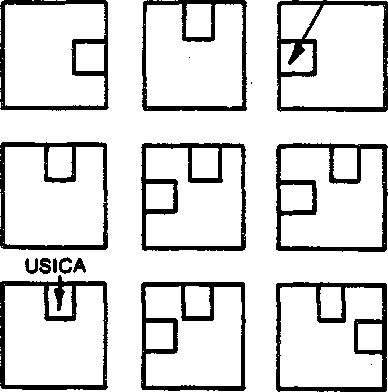
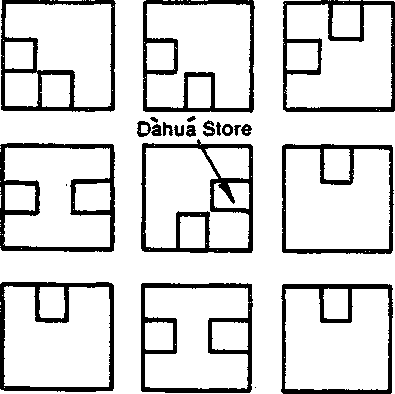




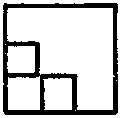
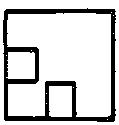
Dahuá Store






LISICA






First Hote!


Bank of Taiwan Shanghai Jiujiā

U.S. Military Attache’s Office

USICA




U.S. Military Attache's Office

Dahuá Store

USICA

Taipei
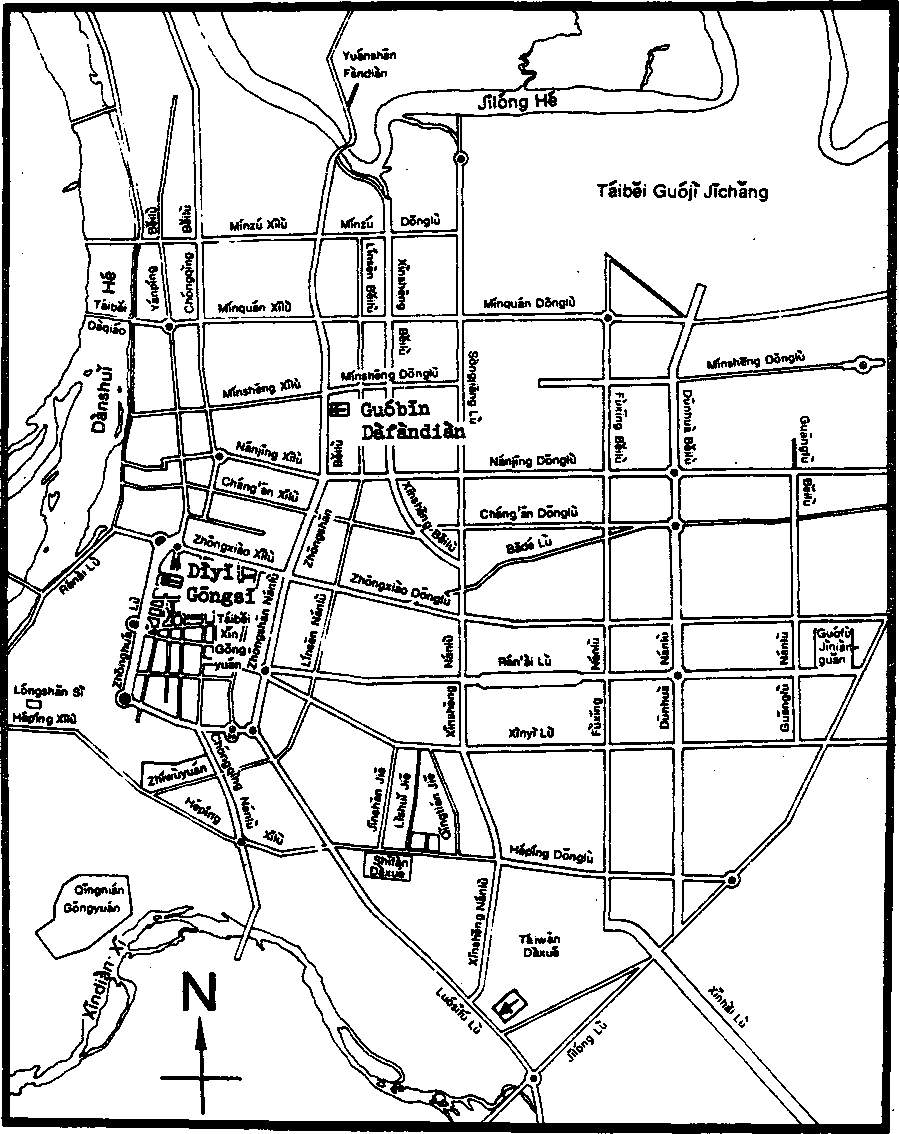
Taipei
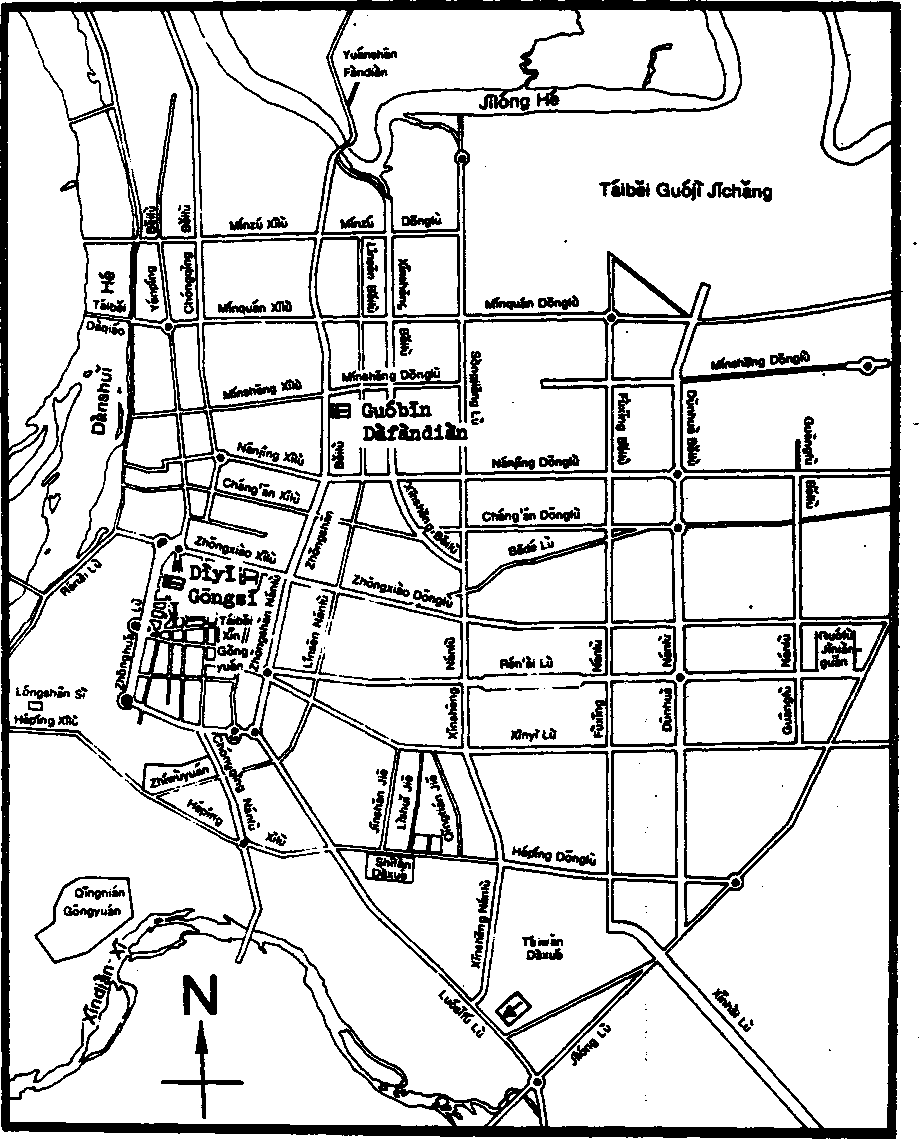
EXERCISE 1
This exercise will give you practice with the words for "inside," "outside," "right side," and "left side."
Mr. Ludden is making a purchase at the Friendship Department Store in BSiJing. He has just discovered that he does not have enough People's currency to pay for the purchase.
You will hear Mr. Ludden's conversation three times. As you listen to it for the third time, answer the questions on the next page.
Here are four expressions you will need for the exercise: gòu (to be enough)
Yǒuyí Shāngdiàn (Friendship Department Store)
bànshìchù (office)
zuìháo (it would be best that)
In this exercise the prepositional verb c6ng is used for "through,” or "via."
W3 cóng nSr zǒu? (How do I get there?)
Ní cóng nèige dámén z3u. (You get there through that entrance.) (When speaking of "via" cities and countries, you would generally use jingguo: W5 shi jlngguo RìbSn qùde, "I went via Japan.”)
Here is diagram of the Friendship Department Store, for your use in following the conversation and in answering the questions on the next page:

QUESTIONS .
1. How is Mr. Ludden advised to go to the bank office? ( ) through the inside ( ) through the outside
2. Where is the bank office?
( ) on the left side (B) ( ) on the right side (A)
EXERCISE 2
This exercise will give you more practice with the words for "inside," "outside," "right side," and "left side."
In the two conversations between a BSiJīng resident and an out-of-town guest, some of the details have been invented. They may not correspond to the actual situation in BSijīng.
You will hear the conversations three times. As you listen to them for the third time, answer the questions below.
You will need the word rě. "to be hot," for this exercise.
QUESTIONS
1. Indicate by check marks where each item is sold.
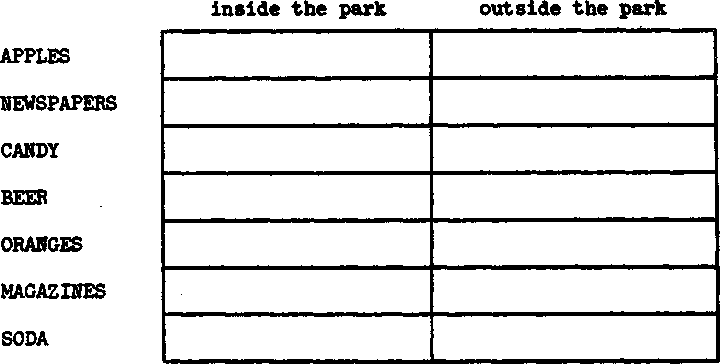
2. Are oranges and apples sold to the right of the candy? ( ) Yes ( ) No
EXERCISE 3
This exercise will give you practice with the words for "before" and "after."
Mr. Clark has been staying at the Běijīng Hotel for a few weeks. He is talking in the hotel lobby to Professor Lin, a Chinese person living overseas. Professor Lin has also been staying at the Běijīng Hotel for the past few weeks with a delegation from Europe.
You will hear the conversation three times. As you listen to it for the third time, answer the questions below.
Here are some new expressions you will need for the exercise: zóuzou (to take a walk)
nà (well, then)
QUESTIONS
1. Mr. Clark wants to go for a walk
( ) after he goes to see his friend.
( ) before he goes to see his friend.
2. Professor Lin's friend is coming
( ) at four o'clock.
( ) before four o'clock.
( ) after four o'clock.
EXERCISE 1
Translate orally into Chinese each English question below. After your translation, the speaker on tape will ask the question in Chinese and give an answer to the question.
The answers usually leave out the introductory "I know that..." and give only the information asked for:
Example 1 (No. 1 on tape)
Q: Ni zhidao bu zhidao Dōngdān Diànyingyuàn zài nSr?
A: Zài Dōngdān Càishichàngde yōubianr.
Example 2 (No. 2 on tape)
Q: Nl zhidao bu zhidao zhèr fùjìn yōu meiyou diìnyingyuàn?
A: Yōu, jiu zài Dōngdān CàishichSngde yōubianr■.
(Notice in Example 2 that a yes/no-choice question CNl zhidao bu zhidao...?2 may be used with "whether" as well as with "what," "where," wwho,H and so forth.)
QUESTIONS
1. Do you know where the Dōngdān Theater is?
2. Do you know whether there is a theater in this area?
3. Do you know at what hour the bank opens?
h. Do you know how to get to Dōngdān Park from here?
5- Do you know on what side of Dōngdān Park there is a market?
6. Do you know whether this hotel accepts American currency?
7. Do you know whether the bank opens on Saturday?
ó. Do you know where you can change money into People’s currency?
9. Do you know whether there is a bank in the vicinity of Dōngdān Park?
1C. Do you know hew much this vase costs?
EXERCISE 2
Display I is a map of two areas in a fictional Chinese city in Héběi. The zigzag line across the middle of the display indicates that the two areas are not near one another.
Use the display to answer the questions on tape, assuming that the map is complete. (For example, since a college is not shown in the vicinity of the Nanjing Hotel, assume that no college is in that area.)
For this exercise, you need to know these two expressions: xiáoxué (elementary school)
gōngxiāo hézuòshè (supply and marketing cooperative)
DISPLAY I
Bank of China
Zhōngshān University
Heplng Zhōngshīn
Hotel Park
Dàhua Theater

XǐnxTn Store
Nanjing Hotel
No. 5 Elementary School
China Bookstore
EXERCISE 3
Display II, on the next page, contains six maps of the sane area in a fictional Chinese city in Hétěi. On each nap a different place is labeled. You will ask directions "from" that place "to” the place indicated above the map.
For each map, ask how to get from one place to the other. When you are given the directions, repeat them one sentence at a tine. (You will find it helpful to trace the route on the map, with one arrow for each sentence.)
Example (Map 1: from the Hépíng Hotel to the Ho. 2 Elementary School) •
YOU: CÓng Hépíng Fàndiàn dào Dìèr Xi&oxué qù, zènne z5u?
TAPE: Chūle Hépíng Fàndiàn wàng dong zSu. Guile lùkSur, jiù shi Dìèr XiSoxué.
YOU: Chūle Hoping Fàndiàn, wi xiàn wàng dong ziu, duì bu dui?
TAPE: Duì le.
YOU: Rínhiu guile lùkSur, yiubianr Jiù shi Dìèr Xiàoxué, duì bu dui?
TAPE: Duì le.
You will need to know: xiàoxué (elementary school)
guile lùkiur (having passed the intersection)
DISPLAY II
1. From the Hepíng Hotel to the No. 2 Elementary School

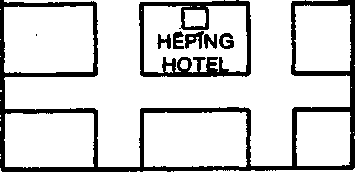
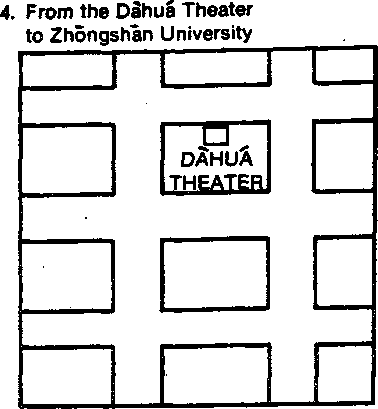
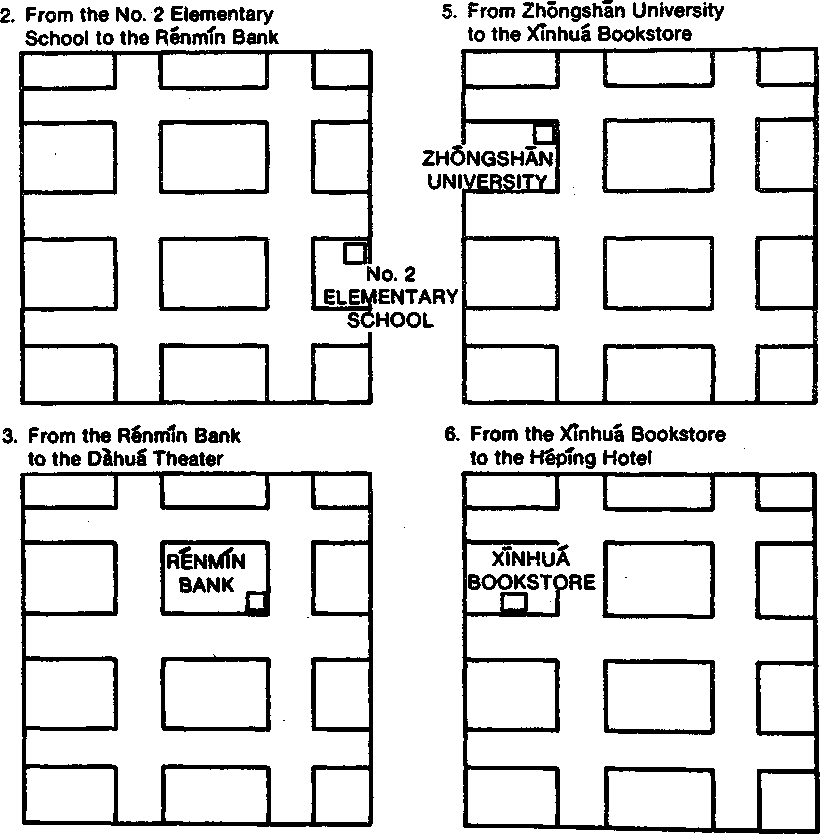
11U
EXERCISE 4
Each item will start with a statement that a person does one thing first and then does another. The statement is repeated. Then you are asked when the person does one of the two things. You answer that he does it either before or after he does the other.
Example 1
TAPE: Tā xiān qù māi dōngxi, zài qù kàn péngyou.
Tā shénme shíhou qù kàn péngyou?
YOU: Tā mSile dōngxi yíhōu, zài qù kàn péngyou.
CRepeat confirmation.J
In your reply, notice the completion le placed BEFORE the nonamount object dōngxi in the yíhōu clause. (See Reference Notes on Additional Required Vocabulary in your textbook.)
Example 2
TAPE: Tā xiān qù huàn qián, zài qù māi dōngxi. Tā shénme shíhou qù huàn qián?
YOU: Tà qù māi dōngxi yíaiín. xiān qù huàn qián. CRepeat confirmation.1
INSTRUCTIONS:
Type: Tracing (This game is played like the Unit 1 Communication Game, except that the setting is Béijīng and you have additional words and structures at your disposal.)
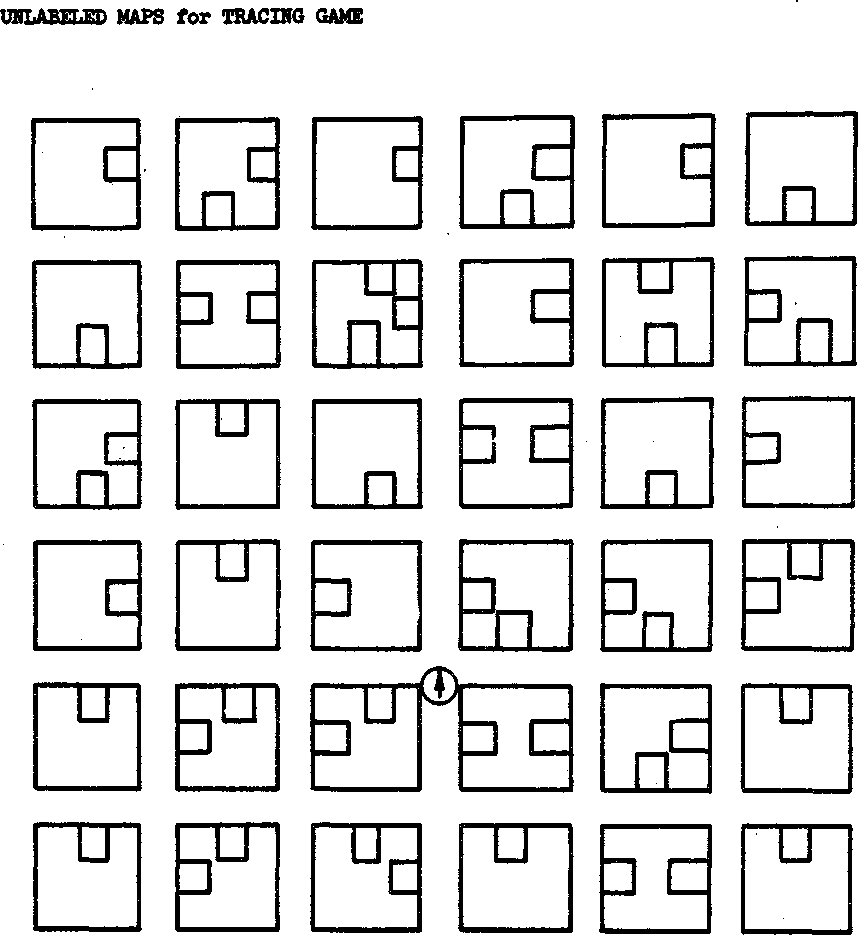
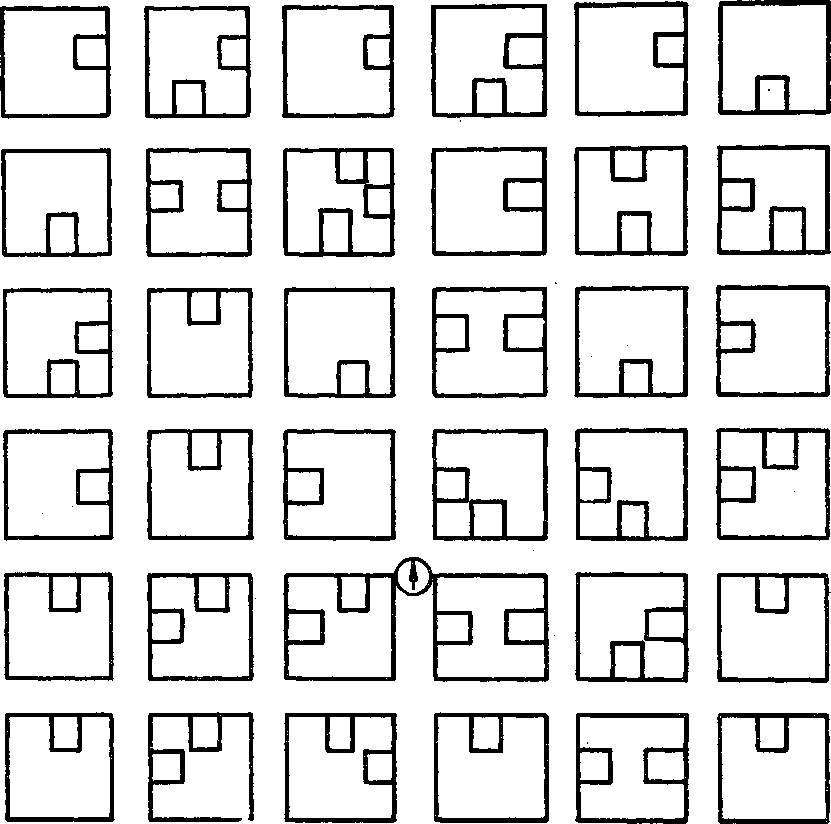
LABELED MAP for TRACING GAME



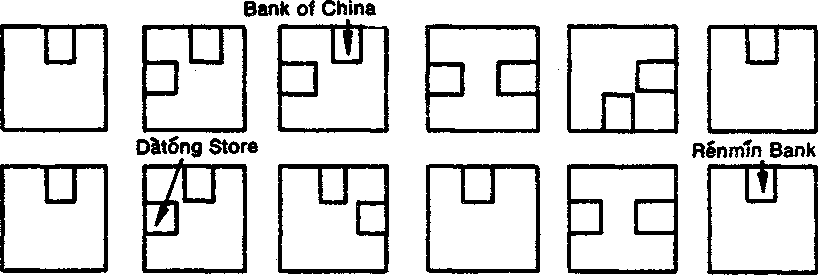
119
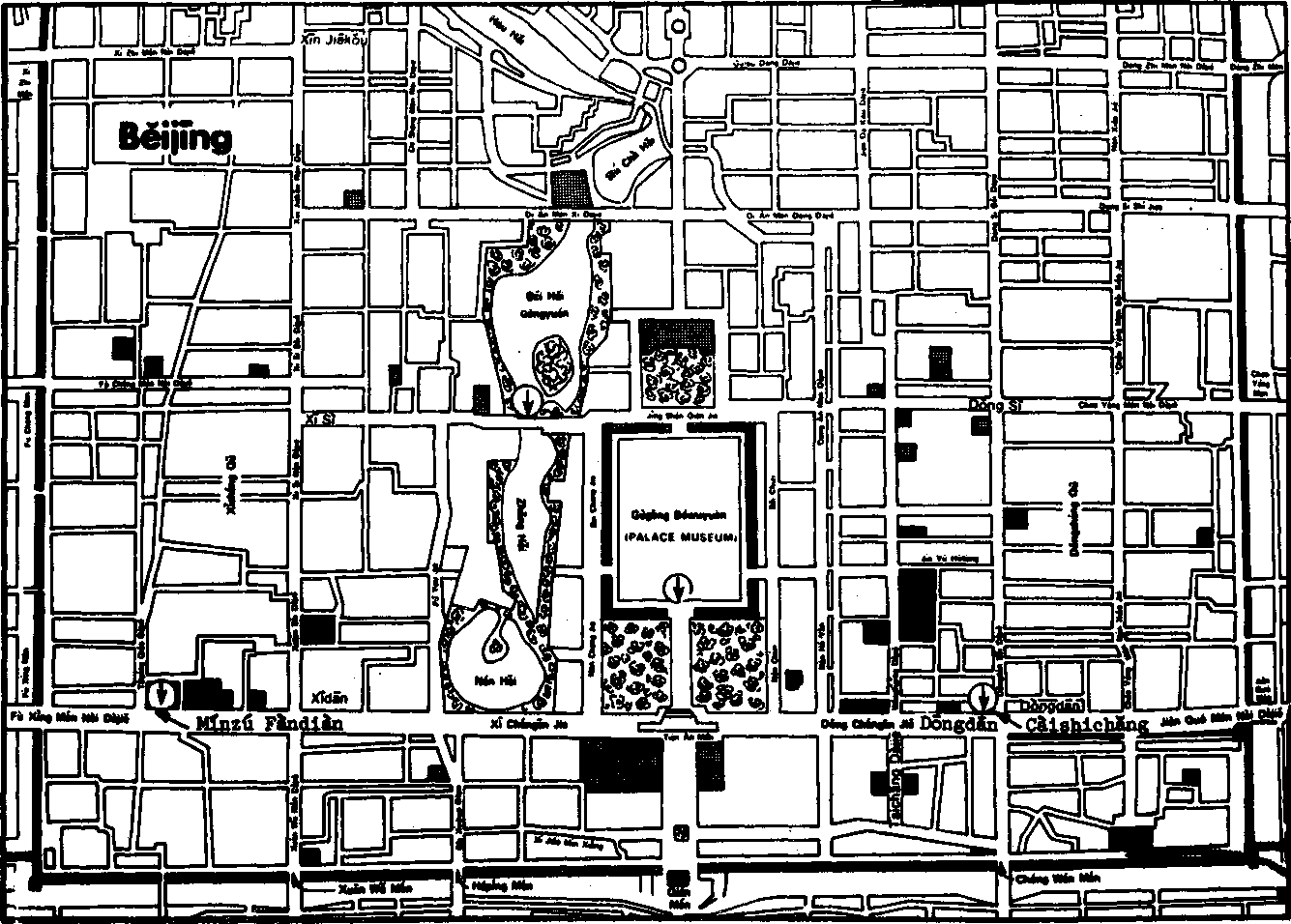
N )TE: The heavy dark lines show where the city walls were formerly located.

NOTE: The heavy dark lines show where the city walls were formerly located.
INSTRUCTIONS:
Type: Neighbors
Situation: You are talking with three people about where various other people live within a four-block area of Béijīng. Each player knows where six people live and needs to find out where six others live.
Goal: To fill in the names of the six other people in the appropriate places on your work sheet.
Number of Players: Groups of four students.
Materials: A work sheet for each player. (See Sample Work Sheet on the next page.) The names of six people are shown on your work sheet in the boxes representing their homes. The names of six other people are listed at the bottom of your work sheet.
Procedure: Mingle with the players in your group to find out where six people live.
In each conversation, identify people's homes known to both you and your partner. Then work to the north, south, east, or west in asking about what people live in these homes.
An expression such as "to the east of" will mean "immediately to the east of," that is, the next house in that direction.
You will not be able to describe the location of a house if it is not next to a person’s house known to both you and your conversation partner. You may say W5 zhidao zài nǎr, kSshi w5 bù zhidào zānme shuō. "I know where it is, but I don't know how to say it." (There are, of course, ways to describe the location. One way is to say Wángiā dōngbianr(de) dìsānge fángzi shi Chěnjiā, "The third house to the east of the Wings' house is the Chens' house.")
Example: You are Speaker 1. You have the Sample Work Sheet on the next page.
SI: Nī zhīdao bu zhidao Lī Jiā zài nār?
S2: W3 bù zhīdao.
SI: NX zhīdao bu zhidao Wing Jiā zài nār?
S2: Wo zhīdao.
SI: Nī zhīdao bu zhidao shéi zhù zai Wing jiāde dōngbianr?
S2: Gāo Tongzhì zhù zai Wing Jiāde dōngbianr.
SI: Lī Tongzhì zhù zai Gāo jiāde dōngbianr.
(etc.)
Practice Points: Dōngbianr. bSibianr, xībianr. ninbianr, Nī zhīdao bu zhidao...?
SAMPLE WORK SHEET:
|
Wang |
Gáo |
|
Liu |
|
* * Li |
Chen |
|
Zhao | |
OTHERS: Zhang, Yang, Wú, Zhōu, Huang, Xu
INSTRUCTIONS:
Type: Tic-Tac-Toe
Goal: As in any game of Tic-Tac-Toe, to occupy three squares in a row.
Number of Players: Pairs of students.
Materials: Each player draws a Tic-Tac-Toe ’’board” on paper. (Each player marks the plays on his own copy of the board.) The center square on the board is a park surrounded by eight city blocks. The blocks are identified by their direction from the park.
|
gōngyuánde xīběibianr |
gōngyuánde běibianr |
gōngyuánde dōngběibianr |
|
gōngyuánde xībianr |
GŌNGYUAN |
gōngyuánde dōngbianr |
|
gōngyuánde xīnánbianr |
gōngyuánde nánbianr |
gōngyuánde dōngnánbianr |
Notice that, in Chinese, a direction such as "northwest,” xlběi, is literally "west north"—the order in which the two directions are given is the reverse of the English order.
Procedure: The first player marks an X in a square. The second player marks an 0 in another square. And so on. As each player marks a square, he tells the other player what square he is occupying: Wō yào..., "I take...." The partner must mark the play in the appropriate square on his copy of the board.
Example; You are Speaker 1, marking Xs. (The numbers in the diagram below show the order of play.)
SI: WS yào gōngyuán.
S2: Wo yào gōngyuánde běibianr.
SI: WS yào gōngyuánde dōngběibianr.
S2: WS yào gōngyuánde xīnánbianr.
SI: WS yào gōngyuánde dōngbianr.
S2: WS yào gōngyuánde dōngnánbianr.
SI: Wō yào gōngyuánde xībianr. WS yíng le.
|
02 |
*3 | |
|
x7 |
*1 |
X5 |
|
01* |
06 |
Practice Points: Eight points of the compass.
EXERCISE 1
An American and his Chinese acquaintance have just left a movie theater in Dōngdān (BSijīng). They are talking in front of the theater.
You will hear the conversation three times. As you listen to it for the third time, translate each sentence orally during the pause provided on tape. Then compare your translation with the suggested translation given by the speaker.
Here are three words you need to know:
Jiao (to be called Las in Nèige gōngyuán Jiao Dōngdān Gōngyufin. "That park is called the Dōngdān Park.”3)
zǎo (to be early Cused also for "good morning"!)
zǒudāo (to walk to)
In this exercise the use of zhèige, "this," may seem strange to you. In English, you say "That movie was really good." In Chinese, you say "this (zhèige) movie”: Zhèige diànying zhēn hSo.
EXERCISE 2
Distances are discussed in this conversation between a Canadian man and a Chinese woman. They are talking in a hotel in BSijíng.
You will hear the conversation three times. As you listen to it for the third time, answer the questions below.
You need to know these expressions: zì (character Lof Chinese writing!)
niàn (to be pronounced, to be read as)
dài biSo (to wear a watch—dài, ”to\ear”; biSo, "watch”)
QUESTIONS
1. Where is the Chinese woman from?
( ) Beijing ( ) Nfinjlng ( ) ShànghSi
2. Is Nánjīng close to ShànghSi? ( ) Yes ( ) No
3. How many years did the Chinese woman attend Nanjing University? ( ) U years ( ) 3 years
U. How many years has the Chinese woman been working in Bǎijing? ( ) 1* years ( ) 3 years
What time of day was the conversation held? ( ) 8 o’clock ( ) 8:15 ( ) 8:30
EXERCISE 3
Again, distances are discussed by an American man and a Chinese woman. They are in the Beijing Hotel.
You will hear the conversation three times. Answer the questions below as you listen for the third time.
These two new expressions are in the conversation:
Bǎihuò Dàlóu Cname of a department store in BeijingJ
yíjiàn yishang (a piece of clothing)
QUESTIONS
1. How near is the Baihuò Dàlóu? ( ) faraway ( ) close-by
2. On the map below, which square represents the Bǎihuò Dàlóu? (Put an X in the appropriate square.)

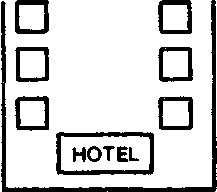


EXERCISER
A Chinese person living in Japan is visiting the PRC. He is talking with his guide in BSiJing^
You will hear the conversation three times. As you listen to it for the third time, translate each sentence orally during the pause provided on tape. Then compare your translation with the suggested translation given by the speaker. •
These expressions are in the conversation:
Yǒuyí Shāngdiàn (Friendship Department Store)
Hàn-Rì zìdiān (Chinese-Japanese dictionary)
Rì-Hàn zìdiān (Japanese-Chinese dictionary)
You have already learned that gēn can mean ’’and.” In this exercise, gēn is a prepositional verb translated as "with":
W3 gēn ta qù. (I’ll go with him.)
Notice that tā is toneless after the prepositional verb gēn. Tǎ keeps its tone after the conjunction gēn, meaning "and":
Wǒ gēn tā dōu qù le. (He and I both went.)
There are added differences between negative sentences containing gēn. "and," and gēn. "with":
Wǒ méiyou gēn ta qù. (I didn’t go with him.)
Wǒ gēn tā dōu méiyou qù. (Neither he nor I went.)
EXERCISE 1
The five maps in Display I show the same area of Beijing. For each map, ask how to get from one place to another, as indicated above the maps. When you are given the directions, check them one sentence at a time. (You will find it helpful to trace the route on each map, with one arrow for each sentence.)
Example (Map 1: from the Beijing Hotel to the Xinhua Bookstore)
YOU: Cōng BSijing Fàndiàn dào Xīnhuá Shūdiàn qu, zSnme zōu?
TAPE: Chūle Beijing Fàndiàn cháo dōng zōu. Dàole lùkōur cháo
bSi guii. Zōu bù yuin, lùdōng dìyíge dàlōu jiù shi Xinhua Shūdiàn.
YOU: Chūle BSijing Fàndiàn wc xiān cháo dōng zōu, duì bu dui? TAPE: ' Duì le.
YOU: Dàole lùkōur wō cháo běi guài, duì bu dui?
TAPE: Duì le.
YOU: Ránhōu zōu bù yuSn, lùdōngde dìyíge dàlōu jiù shi Xinhuá Shūdiàn, duì bu dui?
TAPE: Duì le.
You will need the expressicn Bǎihuō Dàlōu, the name of a department store in BSijing.
DISPLAY I
1. From the Běijīng Hotel to

4. From the Bank of China to
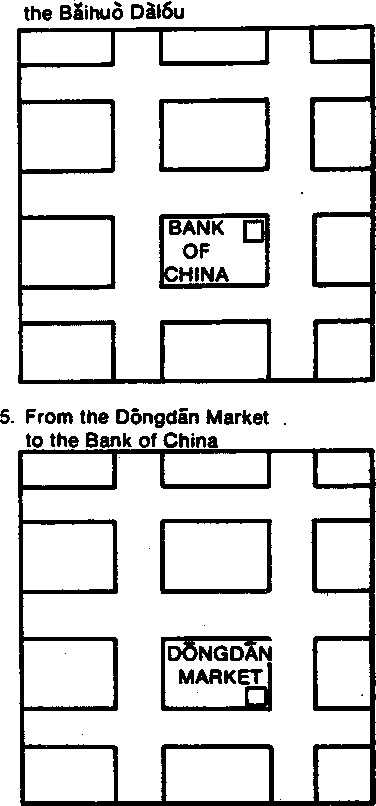
EXERCISE 2
The arrows on the map in Display II indicate trips that three people will take to three cities in the PRC. The speaker on tape will ask you questions about whether it is far from one city to another1 and about whether a certain person is going to a certain city.
Example'
Shanghai lí Nanjing yuan bu yuan?
Shanghai lí Nanjing bù yuan.
TAPE:
YOU:
Notice the position of bù in negative answers containing the prepositional verb lí.
DISPLAY II
CHINA
Běijīng

EXERCISE 3
Now you will practice modifying nouns in Chinese by forming phrases which correspond to English "which” or "who" phrases.
You have learned about phrases with the marker de used BEFORE the modified noun.
|
Xīhuan kàn diànylng |
DE |
nèige xuésheng. |

the student who likes to watch movies
Another way to describe a person, place, or thing is to use it in a sentence with y5u and FOLLOW it with the modifying phrase.
|
W3 you |
yige mèimei |
hen xihuan kan diànylng. |
|
(I have |
a younger sister |
twhoJ very much likes to watch movies.) |
|
Zuótiān you |
yige rén |
lái kàn nl. |
|
(Yesterday there was |
a person |
íwhol came to see you.) |
For each item in this exercise, you will hear two sentences. Combine the two into one sentence, using the second sentence to modify the first.
Example
TAPE: Tā ySu yige jiějie. Tā jiějie zài MSiguo niàn shū.
YOU: Tā y5u yige jiSjie zài Māiguo niàn shū.
INSTRUCTIONS:
Type: Tracing (This game is played like the Unit 1 Communication Game, except that the setting is Beijing and you have additional words and structures at your disposal. Be sure to use BSijing expressions such as cháo běi guǎi and lùdōng.)
UNLABELED MAPS for TRACING GAME
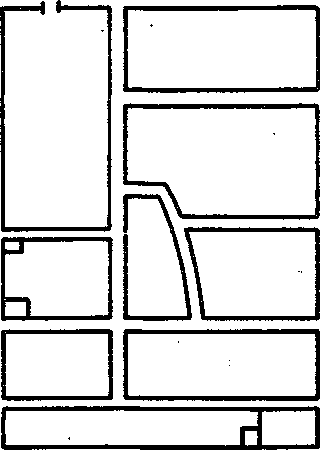
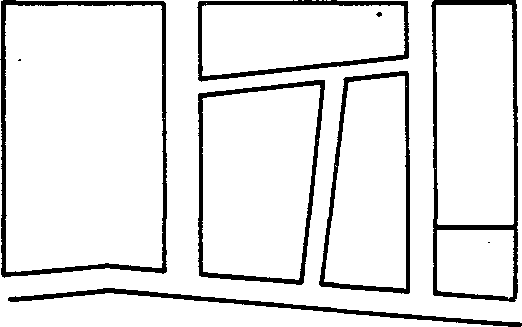
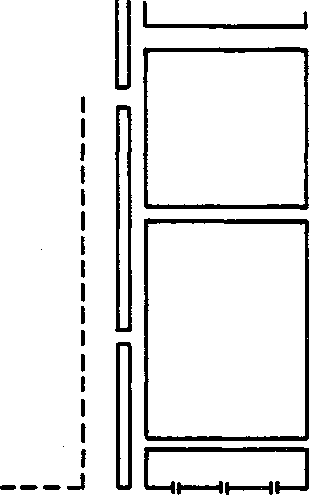

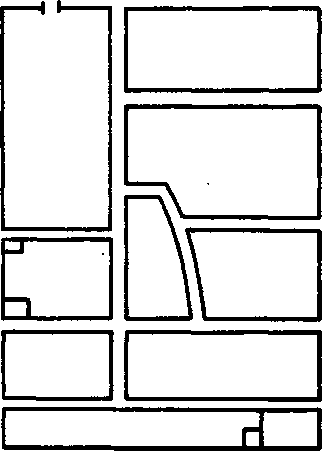


LABELED MAPS for TRACING GAME

I_ft ■ * A a.
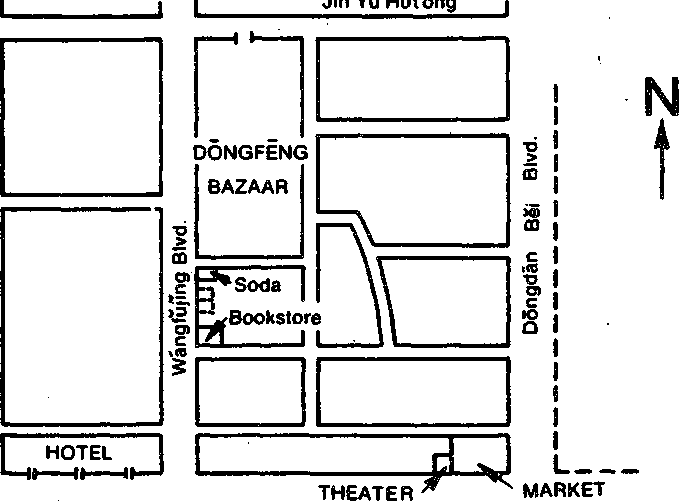
E. Chángōn St.
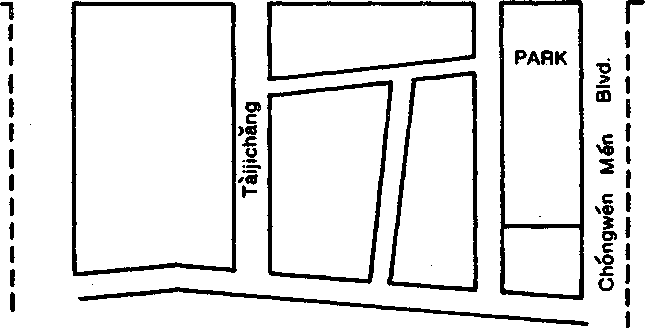

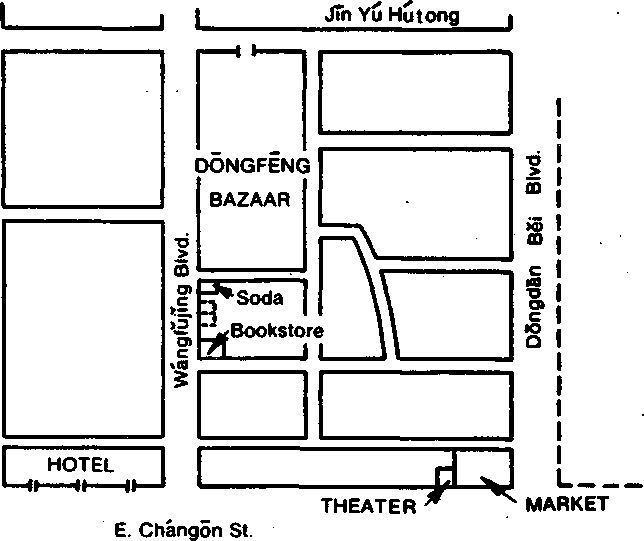

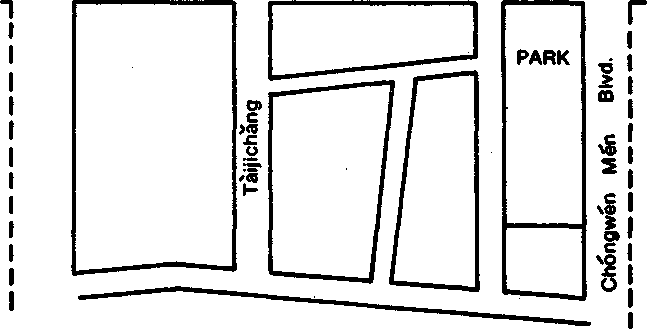
INSTRUCTIONS:
Type: Avenue
Situation: The setting is Beijing. One person is finding out from another how five buildings are arranged along an avenue.
Goal: For the player asking the questions, to find out the order in which the buildings are arranged along (one side of) the avenue; for the' player answering the questions, to give the information correctly.
Number of Players: Pairs of students.
Materials: Each player has five cards. Each card names a building on the imaginary Zhōngshān Avenue. (See Cards—Avenue, on the following pages.) Your partner's cards match yours.
Procedure: The player who will answer questions arranges the cards in his hand to represent the left-to-right order of five buildings along the avenue (in any order).
His partner asks whether one building is "near” (or "not far from") another or whether the building is "far from" (or "not near") another. If the buildings are near, he asks whether one building is "alongside of" the other. If so, he finds out whether one building is "to the left of" or "to the right of" the other. (Remember that these terms are used from the point of view of someone inside the building facing the front door.) He continues until he has arranged the cards in his hand in the correct left-to-right order.
The players exchange roles for the next round.
Example: You are Speaker 1. You have arranged your cards as follows:
*Hépíng* *H6ngqí * *Ránmín* wNo. 8 * AXínhuá w Hotel Theater Market School Bookstore
Speaker 2 puts his Rénmín Market card face-up on the table. He then takes another card from his hand and asks
S2: Hóngqí Diànyingyuàn lí Remain CàishichSng yuSn bu yuSn?
SI: Bù yuSn, jiù zài Remain CàishichSngde pángbiānr.
S2: Zài zuSbianr háishi zài yòubianr?
SI: Zài zuSbianr.
S2 puts his Hóngqí Theater card to the left of Remain Market. He takes another card from his hand and asks
S2: Xinhua Shūdiàn lí Remain CàishichSng yuan bu yuSn?
SI: HSn yuSn.
S2 guesses that the bookstore might be on the other side of the theater from the market:
S2: LÍ Hóngqí Diànyīngyuàn hSn jin ma?
SI: Bú Jin, hén yuSn.
S2 puts the bookstore card above the other two cards on the table, since he does not know where the bookstore is. Then he takes another card from his hand:
S2: Hépíng Fàndiàn lí Rénmín CàishichSng yuSn bu yuSn?
SI: HSn yuSn.
S2 makes the same guess about the hotel that he made about the bookstore:
S2: LÍ Hóngqí Diànyīngyuàn hSn Jin ma?
SI: Dui le, hSn Jin.
S2 puts the hotel card to the left of the theater card. Then he returns to the bookstore card to see if he can put it to the left of the hotel card:
S2: Xinhuá Shūdiàn lí Hépíng Fàndiàn hSn Jin ma?
SI: Bú Jin, hSn yuSn.
S2 tries out the same direction with his last card:
S2: Dibā XiSoxué lí Hépíng Fàndiàn hSn Jin ma? SI: Bú Jin, hSn yuSn.
82 realizes the only possible solution at this point. He places the school card and the bookstore card in order to the right of the market card:
S2: Dibā XiSoxué lí Rénmín CàishichSng hen Jin, Jiù zài Rénmín CàishichSngde youbianr. Xinhuá Shūdiàn lí Dibā Xuéxiào hSn Jin, Jiù zài Dibā Xuéxiàode yùubianr. Shi bu shi?
SI: Duì le.
Additional Notes: The teacher may insist on full answers, and answers as close to the questions as possible. This will require answers such as Hépíng Fàndiàn lí Rénmín CàishichSng bú Jin, with correct placement of the negative adverb bù.
A bit more variety may be introduced into the game by equating zSuzhe qù kéyi with hén Jin and bù yuSn and by equating zSuzhe qù bù kéyi with hén yuSn and bu Jin. The third exchange in the example might then go like this:
S2: Cong Xīnhuá Shūdiàn dào Rénmín CàishichSng zSnme qù? ZSuzhe qù kéyi bu kéyi?
SI: ZSuzhe qù bù kéyi, tài yuSn.
Practice Points: Lí, yuSn, Jin, zuúbianr, youbianr, pāngbiānr. You may also want to practice the word zhōngjiānr, as in X zài Y gēn Z-de zhōngjiānr. "X is between Y and Z.”
CARDS—AVENUE
|
Hépíng Hotel ’ |
Hóngqí Theater |
Hépíng Hotel |
Hongqí Theater |
|
Rénmín |
No. 8 |
Remain |
No. 8 |
|
Market |
School |
Market |
School |
|
Xinhué Bookstore |
XInhuá . Bookstore |
|
Hoping Hotel |
Hóngqí Theater |
Hoping. Hotel |
Hongqí Theater |
|
Rénmin Market |
No. 8 School |
Rénmin Market |
No. 8 School |
|
Xīnhuá Bookstore |
Xinhuà Bookstore |
- |
EXERCISE 1
This exercise will give you practice following directions in a building.
Two students at a Chinese college (a Chinese girl and an American) are talking. The setting is Taipei.
You will hear the conversation three times. As you listen to it for the third time, translate each sentence orally during the pause provided on tape. Then compare your translation with the suggested translation given by the speaker.
|
You will need to know these expressions: | |
|
cèsuS |
(toilet) |
|
duìmiān |
(across from, opposite, facing; the side facing) |
|
wang |
(to forget) |
|
xia lóu lai |
(to come downstairs) |
|
shāng lóu qu |
(to go upstairs) |
The full range of possibilities for going up and down stairs is
|
shāng lou lai |
(come upstairs) |
xiā láu lai |
(come downstairs) |
|
shāng 16u qu |
(go upstairs) |
xiā láu qu |
(go downstairs) |
In this conversation you will hear the verb kěnjian as part of a question asking "whether." A "whether" question with kànjian. just like one with zhīdao, is in the form of a statement.
Nī zhīdao tā lái le meiyou? (Do you know whether he came?)
Nī kānjian tā lái le meiyou? (Did you see whether he came?)
EXERCISE 2
Again, you will hear directions to places inside a building. Having come to a hospital to visit a sick friend, Mr. Levins stops in the lobby to ask for directions. He is talking to a receptionist at the information desk. (On the next page is a floor plan of the first and second floors of the hospital.)
Listen to the conversation two times. Then answer the questions below as you listen again.
You will hear these words in the conversation: lóutī (staircase, stairway, stairs)
duìmiànr (across from, opposite, facing; the side facing)
yàoshi (if)
nà (then, in that case)
One of the sentences in this exercise may be a little complicated to unravel.
|
W3 zou nǎge lóutī |
Jìn? |
|
(I go on which staircase |
close?) |
"Which staircase would be closest for me to go upstairs on?"
This sentence has the same form as Něi sange xuésheng, nSge hSo? "Which of these three students is better (best)?" except that what is being compared is described in a sentence instead of a word or phrase.
Something else that may give you a little difficulty is the expression loutI nàli, as in Dàole loutī nàli, wàng yòu z5u, "When you get to the staircase, go to the right." In Chinese, the object of a verb of motion or location must be a place word. Any word that is not considered an inherent place word must be followed by zhěli or nàli when used as a place word (following zài, dào, etc.).
QUESTIONS
1. According to the receptionist, which staircase is closer to Mr. MS’s room?
( ) the staircase beside the information desk
( ) the staircase across the lobby
2. Did the receptionist say that Mr. Levins could take the elevator?
( ) Yes ( ) No
HOSPITAL FLOOR PLAN:
ENTRANCE

EXERCISE 3
This exercise is based on two short conversations: between an American tourist in Taipei and a hotel employee and between the American and a waitress.
Listen to the conversations twice. Then answer the questions below as you listen again.
Here is a new expression you will hear:
yìbēi (a cup of Cyìbēi kāfēi, ”a cup of coffee”; yìbēi ch&, ”a cup of tea”l)
QUESTIONS
1. The dining room is on what floor? ( ) 1st ( ) 2nd ( ) 3rd
2. The barbershop is on what floor? ( ) 1st ( ) 2nd ( ) 3rd
3. Which way is the dining room as you get off the elevator?
( ) to the left ( ) to the right
U. Which way is the barbershop as you get off the elevator? ( ) to the left ( ) to the right
5. Is the washroom on the right or left at the rear of the restaurant? ( ) on the right ( ) on the left
DIALECT LISTENING EXERCISE
As you remember, a Dialect Listening Exercise is a conversation from a preceding exercise spoken with a different pronunciation. You will learn to understand Chinese as pronounced by speakers of Chinese languages who have learned Standard Chinese as a second language.
One common characteristic of dialect speech is that words which would start with the sounds /zh/, /ch/, and /sh/ (i.e., retroflex, or /r/-position, sounds) in Standard Chinese are pronounced with the sounds /z/, /c/, and /s/ (i.e., dental, or /s/-position, sounds). Also, initial /r/ may be pronounced like an English 1_, £, or z.
EXERCISE 1
Display I contains six floor plans of a Taipei department store. Written above each floor plan are the directions you will ask for.
Ask how to get from one place to another. When you are given the directions, check them one sentence at a time. (You will find it helpful to trace the route on the map, with one arrow for each sentence.)
Example (Floor Plan 1: from the entrance to the dishware department)
YOU: Céng zhàge dàmén dào mài pánziwànde dìfang qù, zSnme zSu?
TAPE: Cong zhàge dàmén wàng lī yìzhí z6u, zuSbian jiù shi mài
pánziwànde.
YOU:
W3 céng zhàge dàmén wàng lī yìzhí z3u, zuBbian jiù shi mài pánziwànde, duì bu dui?
TAPE: Duì le.
Notice that the non-Bàijīng pronunciation for "this,” "that," and "which” (zhàge, nàge, nàge) is used. When the person speaking to you uses these forms,- it is considered polite for you to use them also. (See Unit 5 text, Reference Notes on No. 2.)
DISPLAY I
1. FROM THE ENTRANCE TO THE DISHWARE DEPARTMENT
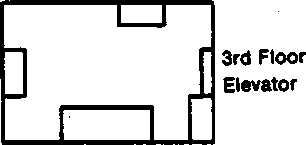
3. FROM THE FIRST FLOOR TO THE RADIO DEPARTMENT
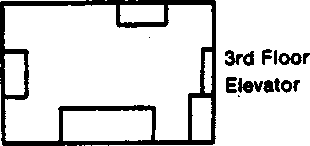


2nd Floor Elevator

2nd Floor Elevator

1st Floor Elevator
entrance

2. FROM THE ENTRANCE TO THE BOOK DEPARTMENT
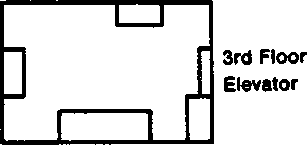
4. FROM THE RADIO DEPARTMENT TO THE VASE DEPARTMENT
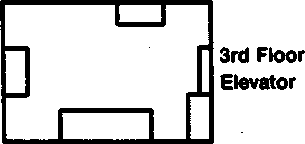

2nd Floor Elevator

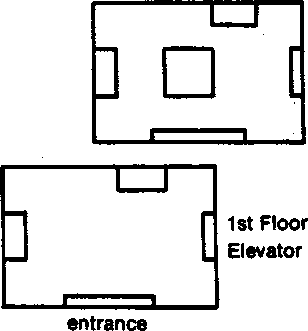
2nd Floor Elevator
5. FROM THE VASE DEPARTMENT TO THE SOAP DEPARTMENT
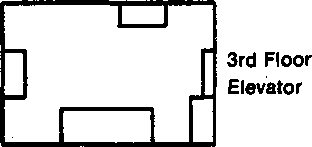
6. FROM THE SOAP DEPARTMENT TO THE TOILETS



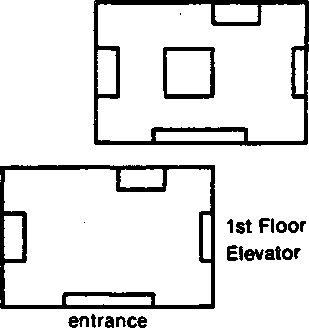
2nd Floor Elevator
EXERCISE 2
In this exercise you are an employee of an American company in Taiwan. You are waiting for a friend on the first floor of the offices. (See X in Display II.) As you wait, several people ask you for directions to places in the building. Use the information in Display II to answer their questions.
Example
TAPE: Qìngwèn, dào Āndésēn Xiānsheng bàngōngshì qu, zānme z3u?
YOU: Nl cóng zhèli wàng ydu z3u, yòubian dìèrge men <Jiù shi.
TAPE: Xièxie.
For this exercise, you will need to know these two words: mén (door)
bàngōngshì (office)
You will also need to recognize these names:
|
Bèiěr Xiānsheng |
(Mr. Bell) |
|
Bùláikè XiāojiS |
(Miss Black) |
|
Dùwēi Xiānsheng |
(Mr. Dewey) |
|
Fúkèsī Xiānsheng |
(Mr. Fox) |
|
Kāmén Tàitai |
(Mrs. Carmen) |
|
Shímìsǐ Xiānsheng |
(Mr. Smith) |
DISPLAY II
An American Company in Taiwan
1st Floor
|
Bèiěr | |
i i ELEVATORS |
DINING | ||
|
Xiǎnsheng |
L_ |
ROOM |
|
MAIN ENTRANCE |
Āndésēn Xiǎnsheng |
2nd Floor
|
ShTmìsT | Xiǎnsheng |
|
Buláǐkè Xiǎojīě |
Fukèsl Xiǎnsheng |
3rd Floor
|
Kǎmén Taitaij |
|
Dùwēi | Xiǎnsheng |
EXERCISE 3
You are in a fictional city in Taiwan. You will have six conversations with six cabdrivers.
For each conversation, you are in a cab. The cabdriver is not sure how to get to your house, so you must give him directions.
Display III is a map of part of the city. The six numbers on the map represent the starting point of each taxi ride. Begin giving directions from these points. The X on the map is your destination (your house) for all six trips.
Example
DRIVER: Zhèli shi Zhongshān Lu. Qǐngwèn, dào nī jiā qù, zěnme zou?
YOU: Nī xiān wàng qián zou, dàole lùkǒu wàng zuǒ z6u, ránhòu
dàole dìèrge lùkǒu zài wàng you zǒu, zuǒbian jiù shi.
DRIVER: Hǎo. Wo zhidao le.
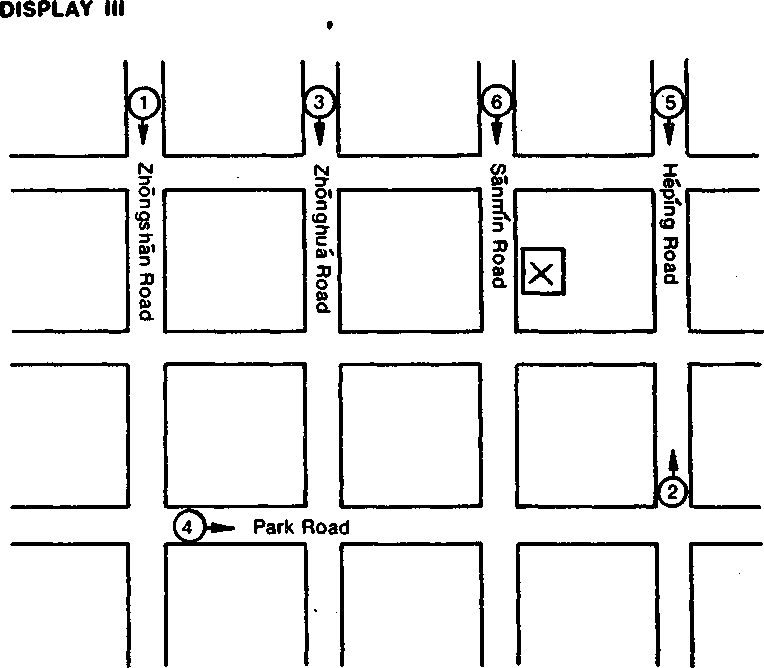
INSTRUCTIONS:
Type: Tracing (This game is played like the Unit 1 Communication Game, except that the routes you trace are in multistory buildings.)
When the route goes from one floor to another, simply draw it to the elevator (or stairs) on the floor plan for one floor. Then continue drawing the route from the elevator (or stairs) on the next floor. For a complicated route through the building, when you use an elevator (or a staircase) several times: Write an identifying number or letter at the end of a route on one floor. Write the same identifying number or letter at the beginning of the same route on another floor.
UNLABELED FLOOR PLANS for TRACING GAME
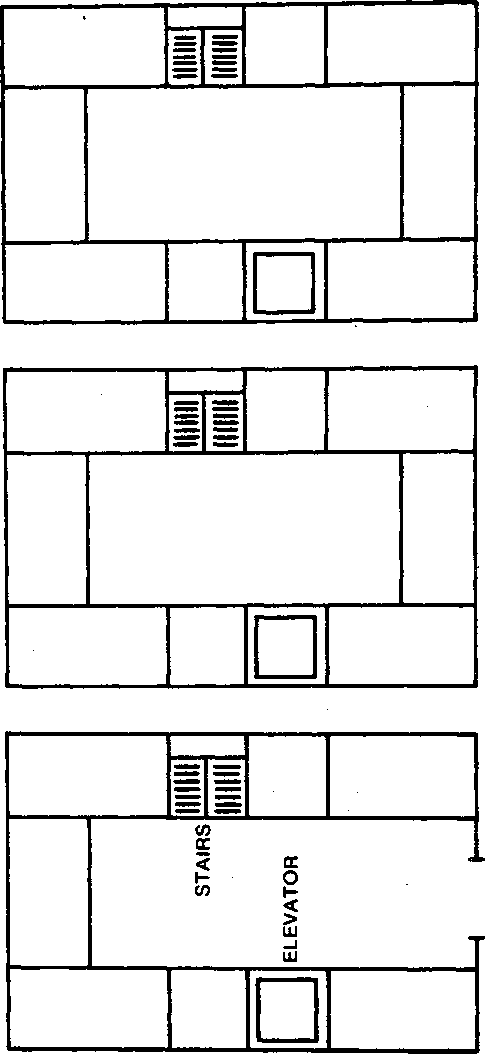
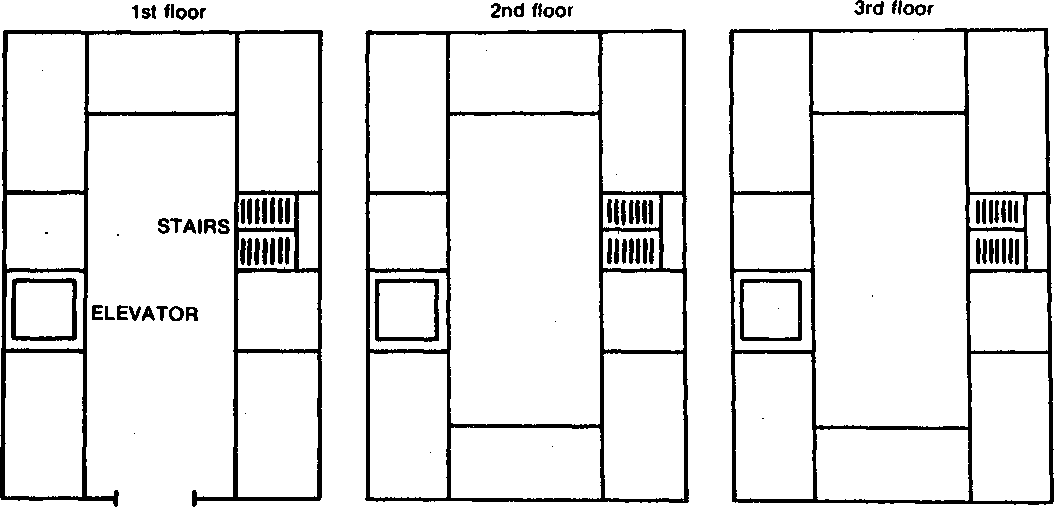
DIR Workbook, Unit U
LABELED FLOOR PLANS for TRACING GAME
An American Company in Taiwan
1st Floor

Beier | Xiānshenc
i----------------r
ELEVATORS

DINING ROOM

MAIN ENTRANCE

Andésēn Xiānsheng
2nd Floor
ShTmìsT |
Xiānsheng
L_JZ__l
|
Bùláike Xiǎojiě _______i |
FúkèsT Xiānsheng |
3rd Floor
Kǎmén Tàitail
|
Dùwèi Xiānshen |
J |
An American Company in Taiwan
1st Floor

Bèiěr |
Xiansheng
ELEVATORS

DINING ROOM
MAIN ENTRANCE
|
Andésèn Xiǎnsheng |
2nd Floor
|
ShTm'sT | Xiǎnsheng ______________________I_________________ |
|
Buláikè Xiǎojiě |
FÚkèsT Xiǎnsheng |
3rd Floor
|
Kǎmén Tàitai | |
|
Dùwēi ,| Xiǎnsheng |
INSTRUCTIONS:
Type: Three-Dimensional Tic-Tac-Toe (This game is played like the Unit 2 Communication Game C, with the following differences.)
Situation: The setting is Taipei.
Goal: To occupy four squares in a row. (A row may be on one floor; it may be four rooms in the same position on the four floors; or it may be rooms on different floors which would make a row if on the same floor.)
Materials: A work sheet for each player. (See Sample Work Sheets, on the following pages.) The "board” represents a hxU arrangement of rooms on each of four floors of a building. The board is equivalent to the UxUxU three-dimensional Tic-Tac-Toe board shown at the right of the work sheet.
Procedure: You "take” a room by giving directions to it. The first player puts his X in a room. He then gives his partner directions to that room from the building entrance. After placing an X in that room, the second player puts his 0 in another room and gives the first player directions from the building entrance.
Directions to the next X and 0 may either start from the building entrance again or start from the last X and 0 (to be decided by the teacher or agreed upon between players).
Example 1: (starting from the entrance each time) You are Speaker 1, marking Xs. Your moves and your opponent's are shown on the first Sample Work Sheet, with numbers indicating the order of moves. ,
SI: Jinle dàmén yìzhí zǒu, jiù shi dianti. Zuǒ diàntī dào èrlóu. Xiàle diàntī wàng yǒu zǒu, zài wàng yǒu zǒu. Yǒubian dìyíge men jiù shi.
S2: Jìnle dàmén wàng zuǒ zǒu, ránhou wàng yǒu zǒu. Zǒudao tóu wàng yǒu zǒu, yǒubian jiù shi lóutī. Shàng lóutī dào èrlóu, wàng zuǒ zǒu, zài wàng zuǒ zǒu. Zuǒbian dìyíge men Jiù shi.
SI: Jìnle dàmén yìzhí zǒu, jiù shi diàntī. Zuǒ diàntī dào sānlóu. Xiàle diàntī wàng yǒu zǒu, zài wàng yǒu zǒu. Yǒubian dìyíge men jiù shi.
S2: Jìnle dàmén wàng zuǒ zǒu, zài wàng yǒu zǒu. Yǒubian diyíge mén jiù shi.
(etc.)
Example 2: (continuous routes) This dialogue would be the same as the last example until the directions to X-3 and 0-U, which go as follows:
SI: Chūle mén (of X-l) wàng zuǒ zǒu, zài wàng zuǒ zǒu, zuǒbian jiù shi diàntī. Zuǒ diàntī dào sānlóu. Xiàle diàntī wàng yǒu zǒu, zài wàng yǒu zǒu. Yǒubian dìyíge mén Jiù shi.
S2: Chūle mén (of 0-2) wàng yǒu zǒu, zài wàng yǒu zǒu, yǒubian jiù shi lóutī. Xiàle lóutī dào yīlóu wàng zuǒ zǒu. Zuǒbian dièrge mén jiù shi.
Additional Notes; You may need the expression zōudao t6u, "to go to the end (of the corridor)."
In the original version of this game, a simpler 3x3x3 hoard was used.. However, students pointed out that the board permitted the'first player to take the center room on the second floor and enjoy an overwhelming advantage. If you do not have time to complete the more complicated game with this new UxUxU board, at least you will have had a good workout giving directions- in a building.
Practice Points; Directions in a building.
SAMPLE WORK SHEETS:
4th Floor

3rd Floor

2nd Floor
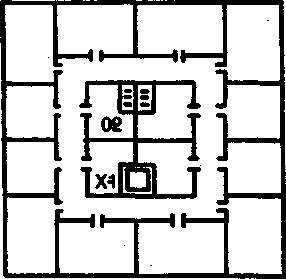
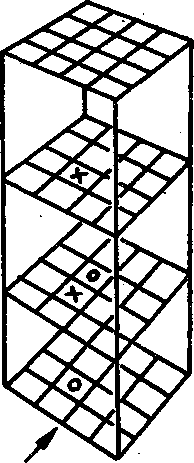
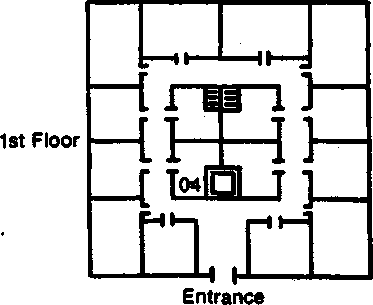
4th Floor
3rd Floor
2nd Floor
1st Floor

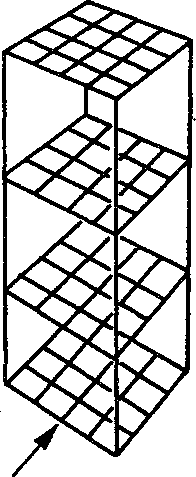

EXERCISE 1
You will hear addresses given in these conversations between an American man and two Chinese women in Taipei.
Listen to the conversations twice. Then answer the questions below as you listen again.
You need to know the expression ban jiā, "to move one’s residence.”
QUESTIONS
1. How many times has Mr. Zhang moved? ( ) Once ( ) Twice
2. How far is Section 2 from Section 1?
( ) Very close ( ) Very far
( ) Not too far ( ) Not too close
3. What is the number of the lane in the first address that the American hears on this tape? ___________________________
U. What is the number of the alley in the second address that the American hears on this tape? ____________________________
EXERCISE 2
In this exercise you will find street directions containing the verb guò. "to cross,” "to pass.” You will translate orally two short conversations.
The setting is the streets of Beijing. A Chinese man who lives overseas asks two women for directions.
You will hear the conversations three times. As you listen to them for the third time, translate each sentence orally during the pause provided on tape. Then compare your translation with the suggested translation given by the speaker. •
Here are some expressions you need to know for this exercise:
dàgài (probably)
hu£ (the opposite direction Cwàng huí zǒu, "to go back"])
hútòngr (a narrow street, a lane CBěijingl)
zdugud le (to have walked past)
zuìh&o (it would be best)
The diagram below shows, where conversations A and B take place and the route followed by the man after receiving directions.
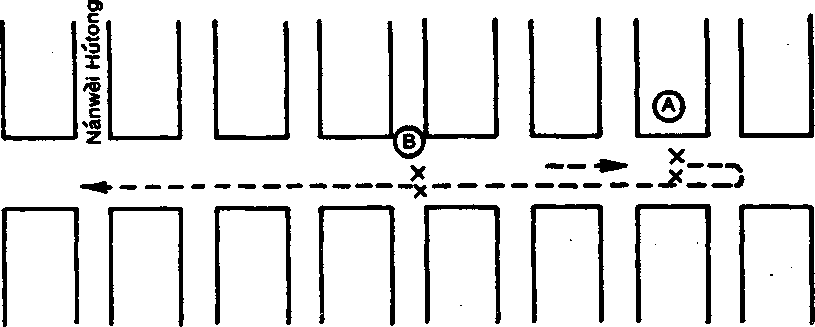
Notice that in giving directions "crossing two streets" is equivalent to "reaching the third intersection.”
Dàole dìsānge lùkdur, yòubianr
(When you have reached the third intersection, Nínwùi Alley is on the right.)
(Cross two streets, and the third alley on the right is Nínwdi Alley.)
Jiù shi Nánwei Hútdngr.
Guò liSngtiáo Jiē, ydubianr dìsāntiáo hútdngr Jiù shi Nánwèi Hútdngr.
EXERCISE 3
These three short conversations include complicated street addresses in Taipei. An American man who can speak Chinese but can not read it has Just stepped off a bus. He is trying to find a friend's house. He asks for directions as he walks along.
Listen to the conversations twice. Then give your translation of each sentence during the pause provided. Compare your translations with the translations given on tape.
You need to know Hépíng Dōnglù (Hépíng East Road)
men (gate, door)
EXERCISE 1
In this exercise you will answer questions. Base your responses on the information in the Display I map.
Example
TAPE: Qlngwèn, LÍn Xiānshengde dìzhl shi?
YOU: Tāde dìzhl shi Nanjing Dōnglù YÍduàn, Wǔshisìxiàng, Wǔnòng Shíjiǔhào.
TAPE: Ní shuō duōshao xiàng?
YOU: Shi Wǔshisìxiàng.
TAPE: Òu, Wǔshisìxiàng, Wǔndng, Shíliùhào, shi bu shi?
YOU: Bfi shi Shíliùhlo, shi Shíjiǔhào.
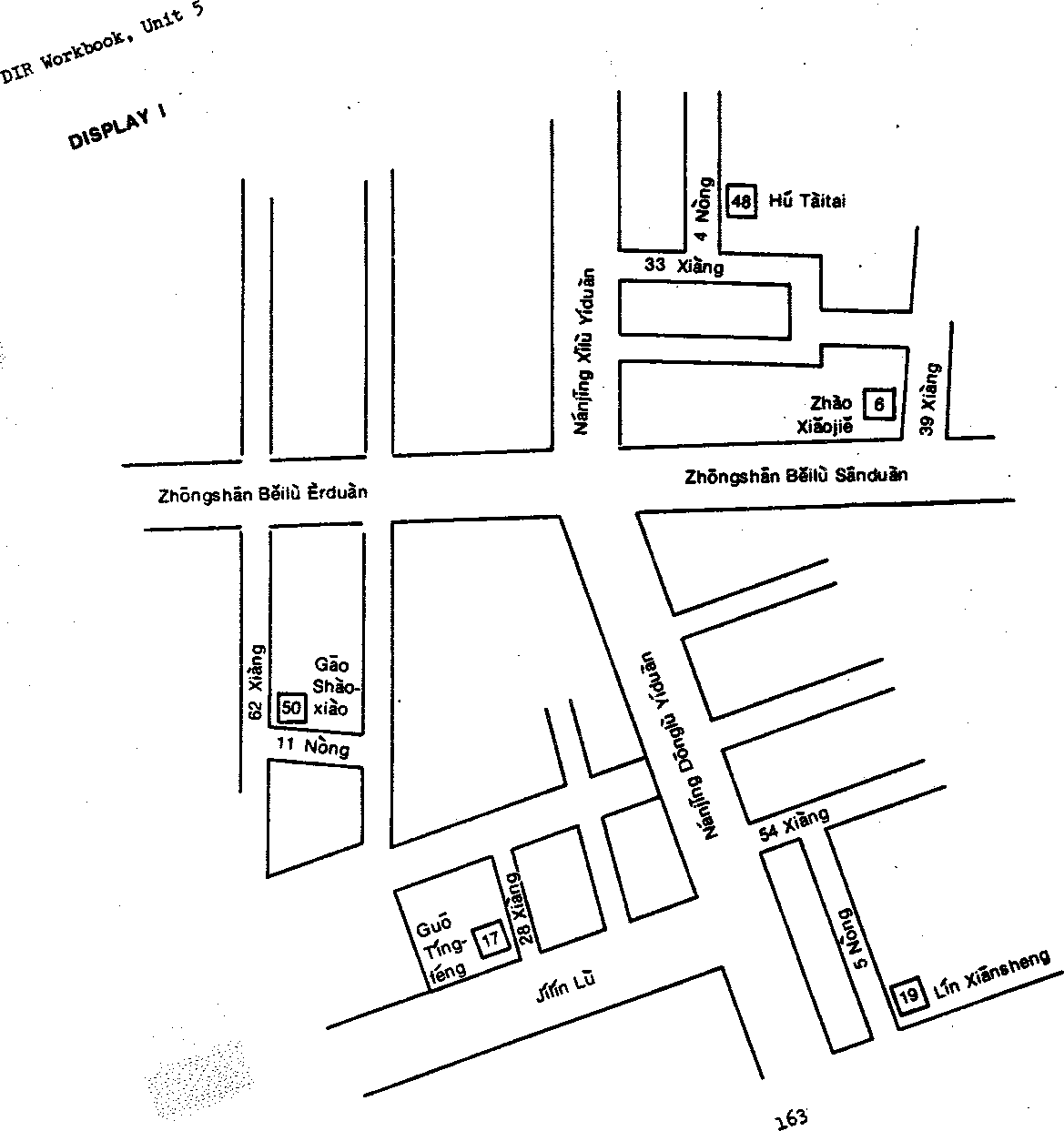
EXERCISE 2
Here are four conversations for you to take part in. The Display II map shows your location (starting point) on four different occasions and the locations of four houses (ending points). Each starting point shows where the directions for that conversation will begin. Each ending point shows the-address you are asking for.
Use the display information to ask directions to a certain address and to confirm the directions given.
Example
|
TAPE: |
Nín zháo shénme difang? |
|
YOU: |
W3 zhào Shísānxiàng, Wǔshisìhào. Zènrne z3u? |
|
TAPE: |
Nín c6ng zhèli wàng nán z5u. Guè sāntiáo jiē, jiù shi shísānxiàng. Wǔshisìhào zài zuǔbian* |
|
YOU: |
Nl shuō cáng zhèli wàng nán zSu, duì bu dui? |
|
TAPE: |
Duì le. |
|
YOU: |
Wǔshisìhào zài zuSbian, shi bu shi? |
|
TAPE: |
Duì le. |
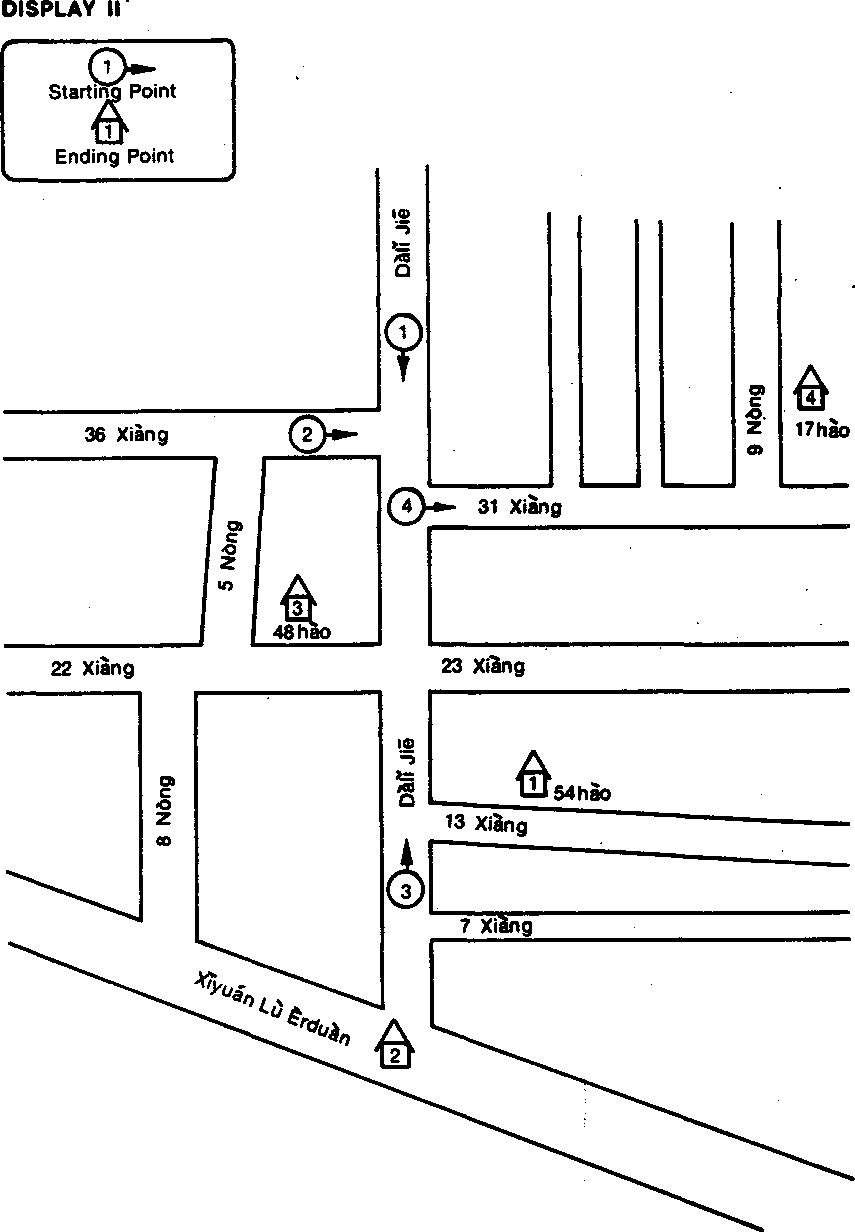
INSTRUCTIONS:
Type: Tracing (This game is similar to the Unit 1 Communication Game.)
Situation: An American is asking a Chinese friend for directions over the phone. The American is calling from a store at one of two locations: either from No. 8, Sānmín Road, Section 1, or from No. 1, Sānmín Road, Section 2.
Both people have copies of the same map, but the American can not read the street names and numbers, which are in characters.
Goal: To have the same route marked on both maps, or for the "American" to be able to locate the address he is asking for.
Number of Players: Pairs of students.
Materials: The "American" has an unlabeled copy of the map and a list of addresses. The "Chinese friend" has a labeled copy of the map. Both copies of the map show the two possible starting points as circles with arrows in them.
Procedure: The "American" chooses one of the addresses from his list and asks for directions to it. The "Chinese friend” finds out where the "American" is and gives him directions to the address (marking the route on his map if he wants to). The "American" (tracing the route on his map if he wants to) locates the address. The two players compare maps.
Further rounds may be played with the same copies of the map. Players switch roles for each round.
Example: You are Speaker 1, the "American.” You have chosen an address to ask for:
SI: Wo xiànzài zài Sānmín Lù èrduàn Yíhào. Wò yāo dào DàyS Jiē ìrduàn Shíqīnòng Yíxiàng Wǔhào qù. Wò bù zhldào zěnme zòu.
S2: HSo. NX dēngyidēng. Wò kànkan dìtú. Ou, nX chūle dàmén wàng zuò zòu, dàole lùkSu wàng you zòu jiù shi DàyS Jiē Èrduàn.
SI: Hao. Dàole DàyS Jiē Èrduàn ne?
S2: Dàole DàyS Jiē èrduàn yìzhí zòu, zòudao zuòbian dìàrge lùkSu jiù shi Shíqīnòng.
SI: Shi zuòbian dìàrge lùkSu, bú shi yòubiande?
S2: Duì, shi zuòbian dìàrge lùkòu. NX dàole Shíqīnòng zuòbian dìylge lùkSu jiù shi Yíxiàng. Yíxiàngde zuòbian dìsānge men jiù shi Wǔhào.
SI: Hao. Xiàxie ni.
S2: Bú kèqi.
Additional Note:' Notice the construction zSudao, "to go as far as,” "to go to,M which you have seen in zSudao t6u, "to go to the end (of the corridor)": ZSudao zuSbian dìèrge lùkSu, "Go to the second intersection on the left."
Practice Points: Everything you have learned about giving directions, especially the new material in this unit.
LIST OF ADDRESSES for TRACING GAME
Dày& Street, Section 1:
No. 3
No. 8, Lane 6
No. 1U, Alley 1, Lane 6
No. 2, Alley 2, Lane 6
No. 9* Alley 2, Lane 6
No. 7, Lane 9
No. 10, Alley 1, Lane 9
No. 2, Alley 2, Lane 9
DàyK Street, Section 2:
|
No. 18 |
|
No. 2, Alley 1, Lane 5 |
|
No. 5, Alley 2, Lane 5 |
|
No. 8, Lane 10 |
|
No. 7> Alley 2, Lane 10 |
|
No. 3, Alley 3, Lane 10 |
|
No. 6, Alley 3, Lane 10 |
|
No. 5, Alley 1, Lane 17 |
Other addresses may be used as destinations if the "American" simply asks his "Chinese friend" for directions to his house and the "Chinese friend" then chooses a house for himself, gives the address, and gives directions to it.
MAPS for TRACING GAME

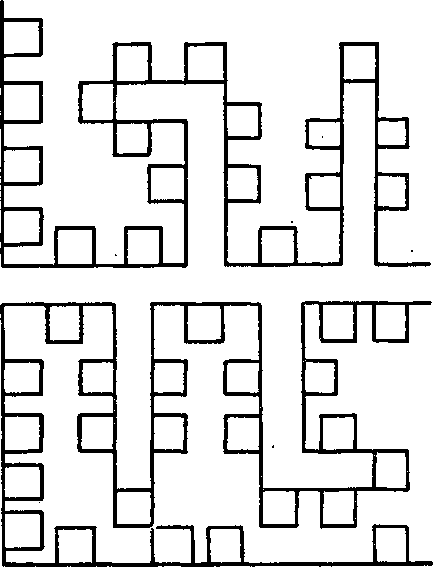
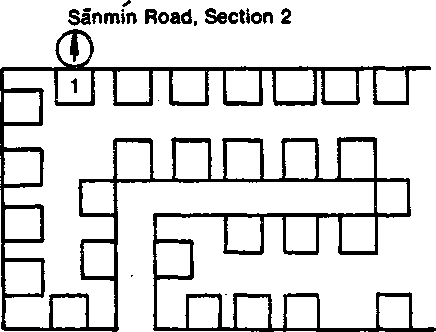
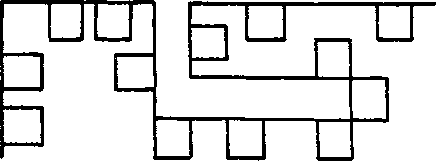
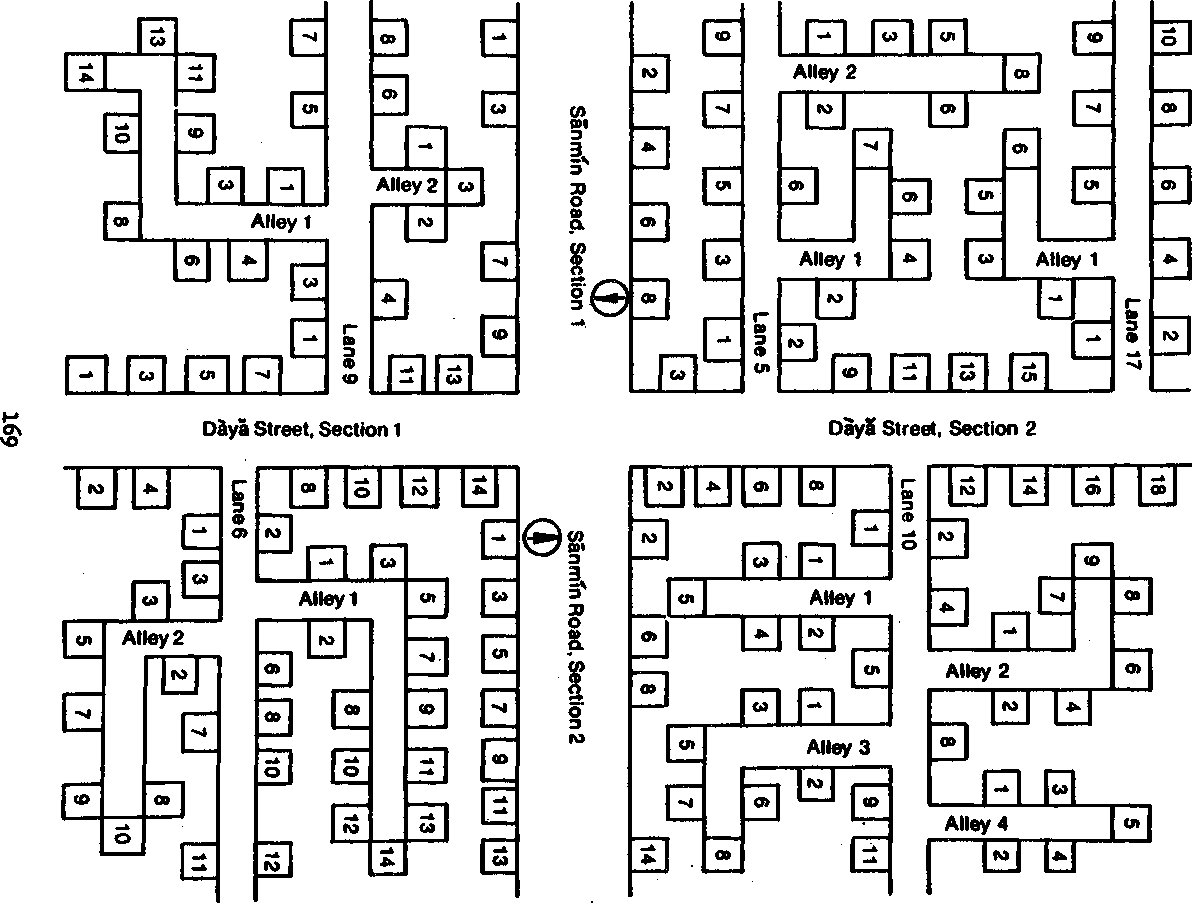
DIR Workbook, Unit 5
Module & Unit
à Oh! 3.U
Si to be short (of stature) 3.3
|
-bǎ |
(counter for things with handles) |
3.3 |
|
bái |
to be white | |
|
-bǎi |
hundred |
3.5 |
|
Bǎihuò Dàlóu |
(name of a department store in Beijing) |
U.3 |
|
bǎihuò gōngsī |
department store |
fc.3 |
|
ban |
half |
3.6 |
|
ban jiā |
to move one’s residence |
U.U* |
|
bàngōngshì |
office |
U.U’ |
|
bànshìchù |
office |
U.2’ |
|
bànyè |
midnight |
3.6“ |
|
bào (yífèn) |
newspaper |
3.1 |
|
bàozhl (yífèn) |
newspaper |
3.1 |
|
-bēi |
a cup of |
U.U’ |
|
bei |
north |
U.2 |
|
bèibian(r) |
north side |
ìi.2 |
|
-ben |
volume (counter for books and magazines) |
3.1 |
|
bǐ (yìzhí) |
pen |
3.1 |
|
-bì |
currency |
3.5’ |
|
-bian(r) |
side, edge (used in place words) |
k.2 |
|
biSo |
watch (timepiece) |
U.3 |
|
biérén (biéren) |
another person, someone, else |
U.5 |
|
bíngxiSng |
refrigerator |
3.1» |
|
bú kèqi |
you’re Welcome |
3.5 |
|
cèishichang |
market |
4.2 |
|
canting |
dining room |
u.u |
|
cèsuS |
toilet |
u.u |
|
chà |
to lack |
T&D U |
|
chábēi |
teacup |
3.4 |
|
chang |
to be long |
3.3* |
|
cháo |
to, towards |
4.3 |
|
cháyè |
tea leaves, tea (the |
3.4* |
prepared leaves)
|
chū |
to go out, to exit |
U.2 |
|
chūlai |
to come out |
If.3 |
|
chūqu |
to go out |
U.3 |
|
cóng |
from |
if.l |
|
c6ng |
through, via |
If.2 |
|
cuò |
to make a mistake, to be |
i*.5 |
■wrong
|
da |
to be large |
3.2 |
|
dàgài |
probably |
»f.5 |
|
dài |
to wear (glasses, gloves, |
If.3 |
|
a watch, jewelry, etc.) | ||
|
dài biǎo |
to wear a watch |
if.3’ |
|
da jiē |
boulevard |
If.3 |
|
dàlóu |
building (multistoried) |
if.3 |
|
dàmén(r) |
main entrance, main gate |
U.3, if.5 |
|
dào |
to, towards |
if.l |
|
-dào |
route, path |
if.5 |
|
dàren |
adult |
3.2 |
|
-dé |
(marker of modification) |
3.2 |
|
děi |
must |
3.6 |
|
děng |
to wait |
3.6 |
|
dēngyiděng |
to wait a moment |
3.6 |
|
dì- |
(used in forming ordinal |
NUM if |
|
numbers Ci.e., dìyl, ”the | ||
|
first”; dìèr, ”the second”]) | ||
|
-diǎn |
(counter for hours on the |
3.6, T&D 3 |
|
clock) | ||
|
diàn(r) |
a little, some |
3.2 |
|
diànshàn |
electric fan |
3.5 |
|
diànshì |
television |
3.5 |
|
diàntí |
elevator |
if.if |
|
diSnxin (yíkuài) |
pastry, snack |
3.2 |
|
diànyíng(r) |
movie, film |
if.2 |
|
dìfang |
a place |
3.if |
|
dìtǎn (yìzhang) |
rug |
3.if |
|
dìtú (yìzhang) |
map |
3.1 |
|
dǐxia |
the underneath, underneath |
if.3 |
|
dìxià |
underground |
lf.5 |
|
dìxià xíngrén dào |
pedestrian underground walkway |
if.5 |
|
Dìyl Gǒngsì |
the First Company (department |
3.if |
|
store in Taipei) | ||
|
dōng |
east |
if.2 |
|
dōngběi |
northeast |
if. 2* |
|
dōngbian(r) |
east side |
if.2 |
|
Dōngdān |
a neighborhood in Bēijīng |
if.2 |
|
dōngnán |
southeast |
if.2’ |
|
dōngxi |
thing |
3.1. |
|
duSn |
to be short |
3.3 |
|
-duàn |
section, block |
U.5 |
|
duì |
to be correct |
U.l |
|
duìbuqí |
I*m sorry, excuse me |
3.1 |
|
duìmiàn(r) |
across from, opposite, facing |
u.u |
|
duō |
to be many |
3.U* |
|
duo yuan |
how far |
U.3 |
|
duōshao |
how much, how many |
3.1 |
um, nm, uh-huh (actually 3.3
pronounced like n£ or mm)
|
fāngbiàn (fāngbian) |
to be convenient |
U.l* |
|
fànguǎnr |
restaurant (BSiJīng) |
U.l |
|
fànguanzi |
restaurant (Taiwan) |
U.l |
|
fángzi |
house |
U.l |
|
fànwan |
rice bowl |
3.U |
|
fěijī |
airplane |
T&D U |
|
í’éizào (yíkuài) |
soap |
3.2 |
|
-fěn |
minute |
T&D 3 |
|
-fēn |
cent |
3.2 |
|
-fèn(r) |
copy (counter for magazines or |
3.1 |
|
newspapers) |
3.1 | |
|
fÙJìn (fǔjìn) |
area, vicinity |
U.2 |
|
gāo |
to be tall |
3.3 |
|
gāoxìng |
to be happy |
3.3 |
|
gei |
to give |
3.2 |
|
gěi |
for |
3.5 |
|
gēn |
with |
U.3* |
|
gōngsī |
company |
3.U |
|
gōngxiāo hézuòshè |
marketing and supply cooperative (PRC) |
3.2*, U.2 |
|
gōngyuán |
park |
U.2 |
|
gòu |
to be enough |
U.2* |
|
guǎi |
to turn |
U.3 |
|
guan |
to close |
3.6 |
|
guan men |
to close (for the business day); to close down, to go out of business |
3.6 |
|
Guāngmíng Rìbào |
The Guāngmíng Daily |
3.2* |
|
Gùgōng Bōwuyuàn |
Palace Museum |
U.2* |
|
guì |
to be expensive |
3.3 |
|
guò |
past the hour |
T&D U |
|
guò |
to cross, to pass |
U.5 |
|
hái |
also, additionally |
3.2 |
|
hái bù yídìng |
not yet certain |
U.l* |
|
háishi |
or |
3.3 |
|
Hàn-Rì zìdiǎn |
Chinese-Japanese dictionary |
U.3* |
|
Hàn-Ylng zìdiǎn |
Chinese-English dictionary |
3.1 |
|
hǎo |
to get better |
3.3 |
|
hǎokǎn |
to be good looking, to look nice |
3.3 |
|
hēi |
to be black |
3.3 |
|
Hépíng Dōnglù |
Hépíng East Road |
U.5’ |
|
háng |
to be red |
3.3 |
|
hòu |
back |
U.U |
|
hòubian(r) |
back side |
U.h |
|
huá |
glorious; abbreviation for China |
U.l’ |
|
Huáměi Kǎfēiting |
Huáměi Coffeehouse |
U.í |
|
huàn |
to change, to exchange |
3.5 |
|
huáng |
to bé yellow, to be brown |
3.3 |
|
huāpíng |
(flower) vase |
3.3 |
|
huàxué |
chemistry |
3.1 |
|
huí |
the opposite direction, back |
U.5’ |
|
hútong (hútòngr) |
narrow street, lane (Beijing) |
U.5 |
|
jí- (ji-) |
a few |
U.3 |
|
Jiā |
plus; to add |
NUM U |
|
jiāli |
household |
3.U |
|
jiàn |
to meet |
3.6 |
|
-jiàn |
piece (counter for pieces of |
U.3* |
|
clothing) | ||
|
jiao |
to be called, to be given-named |
U.3* |
|
jǐdiǎn zhōng |
what hour, what time |
3.6, T&D 3 |
|
jíge (jige) |
several |
U.3 |
|
jǐlóu |
what floor |
h.U |
|
-jīn |
catty ( 1.1 pound) |
3.2 |
|
jīngguo |
by way of,' via; to pass through |
u.r |
|
jin |
to be close, to be near |
U.1J U.3 |
|
jìn |
to enter |
u.u |
|
jiù |
right, immediately, exactly |
3.r |
|
(with reference to space) | ||
|
jiù |
to be old, to be used, |
3.1’, 3.3 |
to be worn
jiù immediately (with reference to
time)
|
kāfēitīng |
coffeehouse |
U.l |
|
kāi |
to open |
3.6 |
|
kāi mén |
to open (for the business day); to open for business |
3.6 |
|
kāi xué |
to begin school |
U.l* |
|
kāishi |
to start* to begin |
3.6“ |
|
kàn |
to read* to look at* to visit |
3.3 |
|
kàn |
to think (hold an opinion) |
3.3 |
|
kànjian |
to see |
U.U |
|
-kè |
quarter of an hour |
T&D 3 |
|
kěshi |
but |
3.U |
|
kéyi |
may, can, to be permitted to; to be all right, to be okay, to be feasible* to be possible |
3.6, U.3 |
|
-kuài |
dollar |
3.1 |
|
-kuài |
a pieée (counter) |
3.2 |
|
lān |
to be blue |
3.3 |
|
lǎo |
to be old |
3.3’ |
|
láojià |
excuse me (BSijfng) |
U.3 |
|
-li (11) |
inside, in |
U.2 |
|
lí |
from, apart from |
U.3 |
|
Lībàirì |
Sunday |
T&D 3 |
|
lībian(r) |
inside |
U.2 |
|
11fa (lifà) |
to cut hair |
U.U |
|
lǐfǎde difang (-fà-) |
a place where hair is cut |
U.U |
|
-long (-nòng) |
alley |
U.5 |
|
-lou |
floor, story of a building |
U.U |
|
lóutī |
stairs |
U.U |
|
lu |
to be green |
3.3 |
|
lùběi |
north side of the street |
U.3 |
|
lùdōng |
east side of the street |
U.3 |
|
lùkǒu(r) |
intersection |
U.1 |
|
lùnán |
south side of the street |
U.3 |
|
lùxī |
west side of the street |
U.3 |
|
lūxíng zhīpiào |
traveler's check |
3.5 |
(yìzhāng)
|
máfan ni |
sorry to "bother you |
3.5 |
|
měi |
to buy |
3.1 |
|
mài |
to sell |
3.1 |
|
mSimai |
business |
3.2 |
|
mámahūhǔ |
so-so, fair |
3.6 |
|
-máo |
dime |
3.2 |
|
měi |
to be beautiful |
U.l |
|
mei shenme |
it’s nothing |
3.6 |
|
MěijIn |
U.S. currency |
3.5 |
|
mén(r) |
door |
3.6 |
|
mén(r) |
gate |
U.5 |
|
ménk8u(r) |
doorway, gateway, entrance |
U.5 |
|
w na- |
which |
U.5 |
|
nà |
well, then, in that case |
U.2*, U.U |
|
nǎbian |
which side, where |
U.U |
|
nàbian |
that side, there |
U.U |
|
nǎge |
which |
U.U*, u.5 |
|
nàge |
that |
U.U*, U.5 |
|
nán |
south |
U.2 |
|
nánbian(r) |
south side |
U.2 |
|
Nanjing Dǒnglù |
Nánj Ing' East Road |
U.2 |
|
Nanjing Xllù |
Nanjing West Road |
U.2 |
|
nánkàn |
to be ugly |
3.3 |
|
nàxie |
those |
3.U |
|
něibian(r) |
which side, where |
U.U |
|
nèibian(r) |
that side, there |
U.U |
|
nèixie |
those |
3.U |
|
niàn |
to be pronounced as, to be |
U.3* |
|
read as | ||
|
niánqlng |
to be young |
3.3 |
|
-nong (-long) |
alley |
U.5 |
|
páijià |
exchange rate (currency) |
3.5 |
|
pángbiān(r) |
beside, next to, alongside of |
U.3 |
|
pánzi |
plates |
3.U |
|
panziwan |
dishes |
3.U |
|
piányi |
to be inexpensive, to be cheap |
3.3 |
|
piàozi |
bills (currency) |
3.6 |
|
pi jiǔ |
beer |
3.2 |
|
-ping |
bottle (counter) |
3.2 |
|
píngguǒ (píngguo) |
apple |
3.2 |
|
pùzi |
shop, store (Běijīng) |
U.l |
|
qián |
one thousand |
3.6, NUM 6 |
|
qián |
money |
3.1 |
|
qián |
front, ahead |
U.U |
|
qiáo |
bridge |
U.5 |
|
qǐng |
please |
3.2 |
|
qìshuǐ |
soda, carbonated soft drink |
3.2 |
|
qù |
to go |
U.l |
|
ránhòu |
afterwards, after that |
U.l |
|
re |
to be hot |
U.2* |
|
rénmín |
people |
3.5* |
|
Rénmín Huabào |
The People’s Pictorial |
3.2* |
|
Rénmín Rìbào |
The People’s Daily. |
3.2* |
|
Renminbi |
People’s currency, Rénmínbì, |
3.2*, 3.5 |
|
RMB (PRC) | ||
|
rènshi |
to recognize, to know |
u.r |
|
Rì-Hàn zidiSn |
Japanese-Chinese dictionary |
U.3* |
|
shàng |
to go up |
U.U |
|
shàng lóu |
to go'upstairs |
u.u |
|
shàng lóu (qu) |
to go upstairs |
u.u* |
|
shàngbian(r) |
the upper surface, above |
U.3 |
|
shāngdiàn |
shop, store |
U.l |
|
shàngwǔ (shàngwu) |
forenoon, morning |
3.6, T&D U |
|
shénme (shenme) |
anything |
3.2 |
|
shénme dìfang |
where, what place |
3.U |
|
shénme shíhou |
when, what time |
3.6 |
|
shi |
matter, affair, business |
U.5 |
|
shi bu shi... |
is it..., is it so that... |
3.5 |
|
shōu |
to accept, to receive |
3.5 |
|
shoubiSo |
wristwatch |
3.5 |
|
shōuyinjí |
radio |
3.5 |
|
shū (yìběn) |
book |
3.1 |
|
shūdiàn |
bookstore |
U.l*, U.3 |
|
shūjiàzi |
bookcase |
3.U |
|
shuǒ |
to speak, to speak (a language); to say that |
U.5 |
|
shùxué |
mathematics |
3.1 |
|
tài |
too (excessive) |
3.3 |
|
Taibi |
Taiwan currency (NT$) |
3.6 |
|
Taiwan Wentán |
Taiwan Literary Magazine |
3.1’ |
-tang (counter for class periods)
-tiáo (counter for long, winding
-tou ' one of two ends of something U.U
wàibian(r)
wan wàng wàng (wang) Wǎngfǔjíng Dàjiē wanshang wen
outside ten thousand to forget to, towards Wǎngfǔjíng Boulevard (Beijing) evening to ask
U.2
NUM 6
U.U" •
U.l
U.2
3.6, T&D U
U.5
|
xī |
west |
U.2 |
|
xià |
to go down |
U.U |
|
xià 16u |
to go/come downstairs |
U.U ' |
|
xià lóu (lai) |
to come downstairs |
U.U" |
|
xiàbian(r) |
the bottom side, the under |
U.3 |
|
surface | ||
|
xiān |
first; ahead of time, |
U.l |
|
beforehand | ||
|
xiang |
to think that; be thinking of |
3.1 |
|
(doing); to want to, would | ||
|
like to | ||
|
xiàng |
towards |
U.l |
|
xiàng |
lane |
U.5 |
|
xiǎngyixiǎng |
to think it over |
3.1 |
|
xiànzài |
now |
T&D 3 |
|
xiǎo |
to be small |
3.2 |
|
xiǎoháizi |
child |
3.2 |
|
xiǎomàibù |
variety shop |
U.2 |
|
xiǎoxué |
elementary school |
U.l", U.2 |
|
xiàwǔ (xiàwu) |
afternoon |
3.6, T&D U |
|
xlběi |
northwest |
U.2" |
|
xlbian(r) |
west side |
U.2 |
|
-xie (-xiē) |
(counter for an indefinite |
3.U |
|
plural number of things) | ||
|
xíhuan |
to like |
3.U |
|
xīn |
to be new |
3.1", 3.3 |
|
xínán |
southwest |
U.2* |
|
xíng |
to be all right |
3.6 |
|
Xíngqīrì |
Sunday |
T&D 3 |
|
xíngrén |
pedestrian |
U.5 |
|
Xīnhuá Shūdiàn |
New China Bookstore (PRC) |
U.3 |
|
Xīnhuá Zìdiǎn |
.New China Dictionary |
3.2' |
|
xǐshǒujiān |
washroom |
U.U |
|
xuéxiào |
school |
U.l |
|
yánsè |
color |
3.U |
|
yào |
to want |
3.2 |
|
yàoshi |
if |
U.U* |
|
yèli |
at night |
3.6. T&D U |
|
yìbēi |
one cup of (counter) |
U.U* |
|
yíce |
a, an |
U.3 |
|
yígòng |
altogether |
3.1 |
|
yīhòu |
after |
U.2 |
|
Yīng-Hàn zìdiǎn |
English-Chinese dictionary |
3.1 |
|
yīqián |
before |
U.2 • |
|
yīshang (yíjiàn) |
clothing |
U.3* |
|
yìzhí |
straight |
U.l |
|
yīzi (yìbǎ) |
chair |
3.U |
|
you |
right (direction) |
U.l |
|
you(de) shíhou |
sometimes |
3.6* |
|
yòubian(r) |
right side |
U.2 |
|
youde |
some |
3.U |
|
Youyì Shāngdiàn (-yí) |
Friendship Department Store |
3.5’, U.2* |
|
(Běijīng) |
U.3* | |
|
yuan |
garden |
U.2* |
|
yuan |
to be far |
U.3 |
|
yuan |
hall |
U.2* |
|
yǔsǎn (yìbǎ) |
umbrella |
3.3 |
|
zài |
then (in commands) |
U.l |
|
zàiJiàn |
good-bye |
3.2 |
|
zǎo |
to be early |
U.3* |
|
zǎochen (zǎochén) |
early morning |
3.6 |
|
zǎoshang (zàoshàng) |
morning |
3.6, T&D U |
|
zázhì (yìběn) |
magazine |
3.1 |
|
zěnme |
how |
3.5 |
|
zěnmeyàng |
how (someone or something) is; |
3.3 |
|
how is...? | ||
|
-zhang |
(counter for flat things: |
3.1 |
|
tables, paper, pictures, etc.) | ||
|
zhǎo |
to give change |
3.2 |
|
zhǎo |
to look for |
U.5 |
|
zhè- |
this |
U.5 |
|
zhèbian |
this side, here |
U.5 |
|
zhàge |
this |
U.U*, U.5 |
|
zhèibian(r) |
this side, here |
U.U |
|
zhèixie (zhèxie) |
these |
3.U |
|
zhēn |
really |
3.3 |
|
-zhī |
(counter for straight, stick- |
3.1 |
|
like objects) | ||
|
zhi (yìzhang) |
paper |
3.1 |
|
zhìdao |
to know |
U.l |
|
zhìpiào (yìzhang) |
check (e.g., banker’s or |
3.5 |
|
personal) | ||
|
zhong |
clock |
3.5 |
|
zhōng |
o’clock |
3.6, T&D 3 |
|
Zhōngguo Wénxué Shi |
History of Chinese Literature |
3.1 , u.r |
|
zhōngjiān(r) |
the middle, in between |
U.3 |
|
(zhǒngjiànr) | ||
|
Zhǒngshān Běilù |
Zhongshān North Road |
U.5 |
|
zhōngwǔ (zhǒngwu) |
noon |
3.6, T&D U |
|
zhōngxué |
middle school (equal to |
U.2 |
|
Junior and senior high school) | ||
|
zhuSn |
to turn |
U.3 |
|
zhuōzi (yìzhang) |
table |
3.U |
|
zì |
character (of Chinese writing) |
U.3' |
|
zìdiǎn (yìběn) |
dictionary |
3.1 |
|
z8u |
to leave |
T&D U |
|
z3u |
to go |
U.l' |
|
z8u dào |
to walk to |
U.3* |
|
z8u dào t6u |
to walk to the end (of |
U.U' |
|
something) | ||
|
zSucuà le |
to have sone the wrong wav |
U.5 |
|
zǒuguò le |
to have walked past |
U.5 |
|
zǒuláng |
corridor |
U.U |
|
zouzhe |
walking |
U.3 |
|
zouzou |
to take a walk |
U.2' |
|
zuì hào |
it would be best that |
U.2', U.5' |
|
zu8 |
left (direction) |
U.l |
|
zuò |
to ride, to go by, to take (a |
U.U |
|
conveyance) | ||
|
zuò mSimai |
to do business |
3.2 |
|
zuobian(r) |
left side |
U.2 |
180
It is unbelievable that anyone who speaks Chinese does not know the relative distances between these three major cities. They are used in this exercise precisely because the names are familiar to most people, and thus not distracting.